Humminbird 1198Cx Si Combo 1158Cx Di Hd Xd Owner S Manual 54763_38_WireAuthorization
2014-07-06
: Humminbird Humminbird-1198Cx-Si-Combo-1158Cx-Di-1158Cx-Hd-Xd-Combo-Owner-S-Manual humminbird-1198cx-si-combo-1158cx-di-1158cx-hd-xd-combo-owner-s-manual humminbird pdf
Open the PDF directly: View PDF ![]() .
.
Page Count: 195 [warning: Documents this large are best viewed by clicking the View PDF Link!]
- Thank You!
- Warnings
- Table of Contents
- 1100 Series™ Introduction
- Universal Sonar 2
- How GPS and Cartography Work
- Fishing System Configuration
- Power On the Control Head
- What’s on the Control Head
- Key Functions
- SD Memory Card Slots
- What’s on the Sonar Display
- What’s on the Side Imaging® Display
- What’s on the Down Imaging™ Display
- Views
- Side Imaging® View
- Down Imaging™ View
- Sonar View
- Sonar Zoom View
- Split Sonar View
- Snapshot and Recording View
- Side Beam View
- Bird’s Eye View
- Chart View
- Combo Views
- Combo Views: Functions
- Side Imaging®/Sonar Combo View
- Chart/Bird’s Eye Combo View
- Chart/Chart Combo View
- Chart/Sonar Combo View
- Chart/Side Imaging® Combo View
- Down Imaging™/Side Imaging® Combo View
- Chart/Down Imaging™ Combo View
- Down Imaging™/Sonar Combo View
- Down Imaging™/Side Imaging®/Sonar Combo View
- Chart Orientation
- Viewing Cartography
- Introduction to Navigation
- The Menu System
- Start-Up Options Menu
- X-Press™ Menu
- Main Menu
- Sonar X-Press™ Menu
- Side Imaging® X-Press™ Menu
- Down Imaging™ X-Press™ Menu
- Navigation X-Press™ Menu
- Snapshot and Recording X-Press™ Menu
- Alarms Menu Tab
- Sonar Menu Tab
- Beam Select
- Side View Frequency
- Imaging Frequency
- Surface Clutter
- SwitchFire™
- Fish ID+™
- Fish ID Sensitivity
- Real Time Sonar (RTS™) Window
- Sonar Colors
- Bottom View
- Zoom Width
- 83 kHz Sensitivity
- 455 kHz Sensitivity
- Depth Lines
- SI Range Lines
- Noise Filter
- Max Depth
- Water Type
- Transducer Select
- Color Bar
- Temperature Graph
- Imaging Colors
- Down Imaging™ Beam Width
- Navigation Menu Tab
- Current Track
- Saved Tracks
- Waypoints
- Routes
- Chart Orientation
- North Reference
- Waypoint Decluttering
- Trolling Grid Rotation
- Trackpoint Interval
- Track Min Distance
- Track Color Range
- Map Datum
- Course Projection Line
- 3D View Outline
- Export All Nav Data
- Delete All Nav Data
- Continuous Navigation Mode
- GPS Receiver Override
- SI Navigation
- Chart Menu Tab
- Setup Menu Tab
- Sound Volume
- Units - Depth
- Units - Temp
- Units - Distance
- Units - Speed
- User Mode
- Language
- Triplog Reset
- Restore Defaults
- Select Readouts
- Select Nav Readouts
- Depth Offset
- Aux. Temp Offset
- Temp. Offset
- Speed Calibration
- Local Time Zone
- Daylight Saving Time
- Position Format
- Time Format
- Date Format
- Digits Format
- NMEA Output
- Sonar
- Demonstration
- Video Out
- Views Menu Tab
- Accessories Menu Tab
- Troubleshooting
- 1-Year Limited Warranty
- Humminbird® Service Policy
- Returning Your Unit for Service
- 1100 Series™ Fishing System Accessories
- Specifications
- Glossary
- Appendix A
- Contact Humminbird®

Operations Manual
1158c Combo, 1158c DI Combo, & 1198c SI Combo
Product Manual

Thank You!
Thank you for choosing Humminbird®, the #1 name in fishfinders. Humminbird® has built its
reputation by designing and manufacturing top-quality, thoroughly reliable marine equipment.
Your Humminbird® is designed for trouble-free use in even the harshest marine environment. In
the unlikely event that your Humminbird® does require repairs, we offer an exclusive Service
Policy - free of charge during the first year after purchase, and available at a reasonable rate
after the one-year period. For complete details, see the Warranty section in this manual. We
encourage you to read this manual carefully in order to get full benefit from all the features and
applications of your Humminbird® product.
Contact our Customer Resource Center at 1-800-633-1468 or visit our Web site at humminbird.com.
WARNING! This device should not be used as a navigational aid to prevent collision, grounding, boat
damage, or personal injury. When the boat is moving, water depth may change too quickly to allow
time for you to react. Always operate the boat at very slow speeds if you suspect shallow water or
submerged objects.
WARNING! The electronic chart in your Humminbird®unit is an aid to navigation designed to facilitate
the use of authorized government charts, not to replace them. Only official government charts and
notices to mariners contain all of the current information needed for the safety of navigation, and the
captain is responsible for their prudent use.
WARNING! Disassembly and repair of this electronic unit should only be performed by authorized
service personnel. Any modification of the serial number or attempt to repair the original equipment or
accessories by unauthorized individuals will void the warranty.
WARNING! This product contains chemicals known to the State of California to cause cancer and/or
reproductive harm.
WARNING! Do not travel at high speed with the unit cover installed. Remove the unit cover before
traveling at speeds above 20 mph.
ATTENTION INTERNATIONAL CUSTOMERS: Products sold in the U.S. are not intended for use in
the international market. Humminbird® international units provide international features and are
designed to meet country and regional regulations. Languages, maps, time zones, units of
measurement, and warranty are examples of features that are customized for Humminbird®
international units purchased through our authorized international distributors.
To obtain a list of authorized international distributors, please visit our Web site at humminbird.com
or contact our Customer Resource Center at (334) 687-6613.
NOTE: Some features discussed in this manual require a separate purchase, and some features are
only available on international models. Every effort has been made to clearly identify those features.
Please read the manual carefully in order to understand the full capabilities of your model.

WARNING! Humminbird® is not responsible for the loss of data files (waypoints, routes, tracks, groups,
recordings, etc.) that may occur due to direct or indirect damage to the unit’s hardware or software. It
is important to back up your control head’s data files periodically. Data files should also be saved to
your PC before restoring the unit’s defaults or updating the software. See your Humminbird® online
account at Humminbird.com and the Waypoint Management Guide on your Humminbird® Manual CD
for details.
1100 Series™, Cannon®, CannonLink™, Contour XD™, Down Imaging™, DualBeam PLUS™, Fish ID+™, HumminbirdPC™,
Humminbird®, InterLink™, LakeMaster®, ProMap™, QuadraBeam PLUS™, RTS Window™, Side Imaging®, SwitchFire™,
Structure ID®, Total Screen Update™, UniMap™, WeatherSense®, WhiteLine™, and X-Press™ Menu are trademarked
by or registered trademarks of Johnson Outdoors Marine Electronics, Inc.
Baekmuk Batang, Baekmuk Dotum, Baekmuk Gulim, and Baekmuk Headline are registered trademarks owned by Kim
Jeong-Hwan.
Navionics® Gold, HotMaps™, and HotMaps™ Premium, Navionics® Classic Charts, and Platinum™ Cartography are
trademarked by or registered trademarks of Navionics®.
XM WX® is a registered trademark of XM Satellite Radio and Weather to the Power of X® is a registered trademark of
XM Satellite Radio Inc. All rights reserved.
© 2012 Johnson Outdoors Marine Electronics, Inc. All rights reserved.
531840-2EN_B

i
Table of Contents
1100 Series™ Introduction 1
How Sonar Works ........................................................................................................................................ 1
High Definition Side Imaging® Sonar
(1198c SI Combo models only)
.......................................................... 3
DualBeam PLUS™ Sonar
(1158c, 1198c SI)
.................................................................................................. 3
Down Imaging™ Sonar
(1158c DI only, XNT 9 DI T)
......................................................................................4
QuadraBeam PLUS™ Sonar
(optional-purchase QuadraBeam PLUS™ transducer only [1158c and 1198c SI only])
.................................... 4
Universal Sonar 2 5
How GPS and Cartography Work 5
Fishing System Configuration 6
Video-Out and RS 232 Connectors.............................................................................................................. 7
Ethernet Connector...................................................................................................................................... 7
Accessory Bus.............................................................................................................................................. 8
Power On the Control Head 9
What’s on the Control Head 10
Key Functions 11
POWER/LIGHT Key .................................................................................................................................... 11
VIEW Key .................................................................................................................................................. 11
MENU Key.................................................................................................................................................. 11
4-WAY Cursor Control Key
(RIGHT, LEFT, UP, or DOWN Cursor Keys)
.......................................................... 12
VIEW PRESET Keys .................................................................................................................................... 12
EXIT Key...................................................................................................................................................... 12
INFO Key .................................................................................................................................................... 13
MARK Key .................................................................................................................................................. 13
GOTO Key.................................................................................................................................................... 13
ZOOM (+/-) Keys........................................................................................................................................ 14
SD Memory Card Slots 15
Add Maps to Your Fishing System ............................................................................................................ 16
Update Software........................................................................................................................................ 16
Export Navigation Data.............................................................................................................................. 17

ii
Table of Contents
What’s on the Sonar Display 18
Understanding the Sonar Display ............................................................................................................ 20
Real Time Sonar (RTS™) Window ............................................................................................................ 20
SwitchFire™ .............................................................................................................................................. 21
Freeze Frame and Active Cursor................................................................................................................ 21
Instant Image Update................................................................................................................................ 21
Sonar Bottom Presentation ...................................................................................................................... 22
What’s on the Side Imaging® Display
(1198c SI Combo models only)
24
Understanding the Side Imaging® Display .............................................................................................. 26
Side Imaging® Frequencies and Coverage................................................................................................ 27
For Best Performance ................................................................................................................................ 28
On the Water Interpretation...................................................................................................................... 29
What’s on the Down Imaging™ Display (1158c DI and 1198c SI Combo models only) 32
Understanding the Down Imaging™ Display .......................................................................................... 34
Interpreting the Display ............................................................................................................................ 34
Down Imaging™ Sensitivity ...................................................................................................................... 35
Freeze Frame and Active Cursor................................................................................................................ 35
Views 36
Side Imaging® View
(1198c SI only)
.......................................................................................................... 38
Down Imaging™ View
(1158c DI and 1198c SI only)
.................................................................................. 41
Sonar View ................................................................................................................................................ 44
Sonar Zoom View ...................................................................................................................................... 46
Split Sonar View ........................................................................................................................................ 48
Snapshot and Recording View
(optional-purchase SD memory card required)
............................................ 50
Side Beam View
(optional-purchase QuadraBeam PLUS™ transducer required [1158c and 1198c SI only])
.... 56
Bird’s Eye View .......................................................................................................................................... 60
Chart View.................................................................................................................................................. 62
Combo Views ............................................................................................................................................ 64
Combo Views: Functions .......................................................................................................................... 64
Side Imaging®/Sonar Combo View
(1198c SI only)
.................................................................................... 65
Chart/Bird’s Eye Combo View .................................................................................................................. 66

iii
Table of Contents
Chart/Chart Combo View .......................................................................................................................... 67
Chart/Sonar Combo View .......................................................................................................................... 68
Chart/Side Imaging® Combo View
(1198c SI only)
.................................................................................... 69
Down Imaging™/Side Imaging® Combo View
(1198c SI only)
.................................................................. 70
Chart/Down Imaging™ Combo View
(1158c DI and 1198c SI only)
.......................................................... 71
Down Imaging™/Sonar Combo View
(1158c DI and 1198c SI only)
.......................................................... 72
Down Imaging™/Side Imaging®/Sonar Combo View
(1198c SI only)
...................................................... 73
Chart Orientation ...................................................................................................................................... 74
Viewing Cartography 74
Introduction to Navigation 76
Waypoints, Routes, and Tracks ................................................................................................................ 76
Save, Edit, or Delete a Waypoint .............................................................................................................. 78
Navigate to a Waypoint or Position .......................................................................................................... 79
Add a Waypoint Target or Trolling Grid .................................................................................................... 80
Save, Edit or Delete a Route .................................................................................................................... 83
Save or Clear a Current Track.................................................................................................................... 83
Edit, Delete, or Hide Saved Tracks ............................................................................................................ 84
Man Overboard (MOB) Navigation .......................................................................................................... 85
The Menu System 87
Start-Up Options Menu 88
Normal........................................................................................................................................................ 88
Simulator.................................................................................................................................................... 89
System Status ............................................................................................................................................ 90
Accessory Test............................................................................................................................................ 91
GPS Diagnostic View ................................................................................................................................ 92
X-Press™ Menu 93
Main Menu 94
Quick Tips for the Main Menu .................................................................................................................. 95
Note for all Menu Settings........................................................................................................................ 95
User Mode (Normal or Advanced) ............................................................................................................ 96

iv
Table of Contents
Sonar X-Press™ Menu 98
Active Side
(Combo Views only)
.................................................................................................................. 99
Split Position
(Combo Views only)
.............................................................................................................. 99
Sensitivity ................................................................................................................................................ 100
Upper Range
(Advanced: Sonar, Split Sonar and Active Sonar Side Views only)
........................................ 101
Lower Range ............................................................................................................................................ 101
Chart Speed ............................................................................................................................................ 101
Quad Layout
(with optional-purchase QuadraBeam PLUS™ Transducer, Side Beam View only)
.................. 102
Bottom Lock
(Sonar Zoom View only)
........................................................................................................ 102
Bottom Range
(Sonar Zoom View only, when Bottom Lock is On)
.............................................................. 102
Cancel Navigation
(only when Navigating)
.............................................................................................. 102
Side Imaging® X-Press™ Menu
(Side Imaging® Views only [1198c SI])
103
Active Side
(Combo Views only)
................................................................................................................ 104
Split Position
(Combo Views only)
............................................................................................................ 104
SI Side ...................................................................................................................................................... 104
SI Sensitivity ............................................................................................................................................ 104
SI Enhance .............................................................................................................................................. 105
SI Range .................................................................................................................................................. 106
Chart Speed ............................................................................................................................................ 106
SI Colors .................................................................................................................................................. 106
Cancel Navigation
(only when Navigating)
.............................................................................................. 106
Down Imaging™ X-Press™ Menu
(Down Imaging™ Views only [1158c DI and 1198c SI])
107
Active Side
(Combo Views only)
................................................................................................................ 108
Split Position
(Combo Views only)
............................................................................................................ 108
Down Sensitivity
(1198c SI only)
.............................................................................................................. 108
Imaging Sensitivity
(1158c DI only)
............................................................................................................108
Upper Range
(Advanced: Down Imaging™ Views only)
............................................................................ 109
Lower Range ............................................................................................................................................ 109
Chart Speed ............................................................................................................................................ 110
SI Colors
(1198c SI only)
............................................................................................................................ 110
Imaging Colors
(1158c DI only)
..................................................................................................................110
Cancel Navigation
(only when Navigating)
.............................................................................................. 110

v
Table of Contents
Navigation X-Press™ Menu 111
Active Side
(Combo Views only)
................................................................................................................ 112
Split Position
(Combo Views only)
............................................................................................................ 112
Waypoint [Name]
(Only with an active cursor on a waypoint)
.................................................................... 112
Cursor to Waypoint
(Chart or Combo View only)
...................................................................................... 113
Save Current Track .................................................................................................................................. 113
Clear Current Track .................................................................................................................................. 113
Save Current Route
(only when Navigating)
............................................................................................ 113
Skip Next Waypoint
(only when Navigating)
............................................................................................ 113
Cancel Navigation
(only when Navigating)
.............................................................................................. 114
Cancel MOB Navigation
(only when MOB Navigation is activated)
.......................................................... 114
Remove Target
(only if a Target is Active)
.................................................................................................. 114
Remove Grid
(only if a Grid is Active)
........................................................................................................ 114
Waypoint [Name]
(Most recently-created waypoint)
.................................................................................. 115
Snapshot and Recording X-Press™ Menu
(Snapshot and Recording View only)
116
Start Recording
(optional-purchase SD Card, Snapshot and Recording View only)
...................................... 117
Stop Recording
(optional-purchase SD Card only)
...................................................................................... 117
Delete Image
(optional-purchase SD Card, Snapshot and Recording View only)
........................................ 117
Delete All Images
(optional-purchase SD Card, Snapshot and Recording View only)
.................................. 117
Delete Recording
(optional-purchase SD Card, Snapshot and Recording View only)
.................................. 117
Delete All Recordings
(optional-purchase SD Card, Snapshot and Recording View only)
............................ 118
Pings Per Second
(optional-purchase SD Card, Snapshot and Recording View only)
.................................. 118
Playback Speed
(optional-purchase SD Card, Snapshot and Recording View only)
.................................... 119
Stop Playback
(optional-purchase SD Card only)
........................................................................................ 119
Alarms Menu Tab 120
Alarm Volume .......................................................................................................................................... 121
Depth Alarm ............................................................................................................................................ 121
Fish ID Alarm............................................................................................................................................ 121
Low Battery Alarm .................................................................................................................................. 121
Aux. Temp Alarm
(with optional-purchase Temp. probe or Temp/Speed only)
............................................ 122
Temp. Alarm ............................................................................................................................................ 122

vi
Off Course Alarm .................................................................................................................................... 122
Arrival Alarm ............................................................................................................................................ 123
Drift Alarm................................................................................................................................................ 123
Sonar Menu Tab 124
Beam Select ............................................................................................................................................ 125
Side View Frequency
(1198c SI only)
........................................................................................................ 126
Imaging Frequency
(1158c DI only)
............................................................................................................126
Surface Clutter ........................................................................................................................................ 127
SwitchFire™ ............................................................................................................................................ 127
Fish ID+™ ................................................................................................................................................ 128
Fish ID Sensitivity .................................................................................................................................... 128
Real Time Sonar (RTS™) Window .......................................................................................................... 129
Sonar Colors ............................................................................................................................................ 130
Bottom View ............................................................................................................................................ 130
Zoom Width
(Sonar Zoom View only)
...................................................................................................... 130
83 kHz Sensitivity
(Advanced, DualBeam PLUS™ Sonar only)
.................................................................... 130
455 kHz Sensitivity
(Advanced, with optional purchase QuadraBeam PLUS™ transducer)
.......................... 131
Depth Lines
(Advanced)
............................................................................................................................ 131
SI Range Lines
(Advanced, Side Imaging® View only)
................................................................................ 132
Noise Filter
(Advanced)
............................................................................................................................ 133
Max Depth
(Advanced)
............................................................................................................................ 133
Water Type
(Advanced)
............................................................................................................................ 133
Transducer Select .................................................................................................................................... 134
Color Bar .................................................................................................................................................. 134
Temperature Graph
(Sonar View only, with Temperature input)
................................................................ 134
Imaging Colors
(1158c DI only)
..................................................................................................................134
Down Imaging™ Beam Width
(Advanced, 1198c SI only)
........................................................................ 134
Navigation Menu Tab 135
Current Track............................................................................................................................................ 136
Saved Tracks ............................................................................................................................................ 136
Waypoints ................................................................................................................................................ 137
Table of Contents

vii
Table of Contents
Routes ...................................................................................................................................................... 138
Chart Orientation .................................................................................................................................... 138
North Reference ...................................................................................................................................... 138
Waypoint Decluttering
(Advanced)
.......................................................................................................... 138
Trolling Grid Rotation .............................................................................................................................. 139
Trackpoint Interval .................................................................................................................................. 139
Track Min Distance
(Advanced)
................................................................................................................ 139
Track Color Range.................................................................................................................................... 139
Map Datum
(Advanced)
............................................................................................................................ 140
Course Projection Line ............................................................................................................................ 140
3D View Outline ...................................................................................................................................... 140
Export All Nav Data ................................................................................................................................ 140
Delete All Nav Data
(Advanced)
.............................................................................................................. 140
Continuous Navigation Mode ................................................................................................................ 140
GPS Receiver Override
(Advanced)
.......................................................................................................... 141
SI Navigation
(Side Imaging® models only [1198c SI])
................................................................................141
Chart Menu Tab 142
Lat/Lon Grid ............................................................................................................................................ 143
Navaids on Bird’s Eye View .................................................................................................................... 143
Chart Select.............................................................................................................................................. 143
Set Simulation Position
(Advanced)
.......................................................................................................... 143
Set Map Offset
(Advanced)
...................................................................................................................... 144
Clear Map Offset
(Advanced)
.................................................................................................................... 144
Shaded Depth .......................................................................................................................................... 144
Chart Detail Level
(optional-purchase Navionics® charts only)
.................................................................. 144
Map Borders ............................................................................................................................................ 145
Spot Soundings
(optional-purchase Navionics® charts only)
...................................................................... 145
Contour Lines
(optional-purchase LakeMaster® charts only)
...................................................................... 146
Depth Colors
(optional-purchase LakeMaster® charts only)
........................................................................ 146
Depth Highlight
(optional-purchase LakeMaster® charts only)
.................................................................. 146
Depth Highlight Range (+/-)
(optional-purchase LakeMaster® charts only)
.............................................. 146

viii
Table of Contents
Water Level Offset
(optional-purchase LakeMaster® charts only)
.............................................................. 146
Shallow Water Highlight
(optional-purchase LakeMaster® charts only)
.................................................... 147
Lake List
(optional-purchase LakeMaster® charts only)
.............................................................................. 147
Setup Menu Tab 148
Sound Volume.......................................................................................................................................... 149
Units - Depth............................................................................................................................................ 149
Units - Temp
(International only)
................................................................................................................ 149
Units - Distance
(with Speed input only)
.................................................................................................. 149
Units - Speed
(with Speed input only)
...................................................................................................... 149
User Mode .............................................................................................................................................. 149
Language
(International only)
.................................................................................................................... 150
Triplog Reset
(with Speed input only)
........................................................................................................ 150
Restore Defaults ...................................................................................................................................... 150
Select Readouts
(Advanced, Non-Navigation Mode)
................................................................................ 150
Select Nav Readouts
(Advanced, Navigation Mode)
................................................................................ 152
Depth Offset
(Advanced)
.......................................................................................................................... 154
Aux. Temp Offset
(Advanced)
.................................................................................................................... 154
Temp. Offset
(Advanced)
.......................................................................................................................... 154
Speed Calibration
(Advanced, with Speed paddlewheel only)
.................................................................. 154
Local Time Zone
(Advanced)
.................................................................................................................... 154
Daylight Saving Time
(Advanced)
............................................................................................................ 155
Position Format
(Advanced)
...................................................................................................................... 155
Time Format
(Advanced, International only)
.............................................................................................. 155
Date Format
(Advanced, International only)
.............................................................................................. 155
Digits Format
(Advanced)
.......................................................................................................................... 155
NMEA Output
(Advanced)
........................................................................................................................ 156
Sonar ........................................................................................................................................................ 156
Demonstration.......................................................................................................................................... 156
Video Out
(Advanced)
................................................................................................................................ 156
Views Menu Tab 157

ix
Accessories Menu Tab 158
Screen Snapshot
(optional-purchase SD Cards only)
................................................................................ 159
AIS
(optional-purchase AIS equipment only)
.............................................................................................. 159
Troubleshooting 163
1100 Series™ Doesn’t Power Up ............................................................................................................ 163
1100 Series™ Defaults to Simulator with a Transducer Attached ........................................................ 163
Display Problems ......................................................................................................................................164
Finding the Cause of Noise ......................................................................................................................165
1-Year Limited Warranty 166
Humminbird® Service Policy 167
Returning Your Unit for Service 168
1100 Series™ Fishing System Accessories 169
Specifications 171
Glossary 176
Appendix A - Transducer Mounting Template: XHS 9 HDSI 180 T 182
Contact Humminbird® 183
NOTE: Entries in this Table of Contents which list (International only) are only available on products sold
outside of the U.S. by our authorized international distributors. To obtain a list of authorized international
distributors, please visit our Web site at humminbird.com or contact our Customer Resource Center at
(334) 687-6613.
NOTE: Entries in this Table of Contents which list (with Speed Input) or (with Temperature Input) may
require the purchase of separate accessories. You can visit our Web site at humminbird.com to order
these accessories online or contact our Customer Resource Center at 1-800-633-1468.
Table of Contents

1100 Series™ Introduction
Your 1100 Series™ Ultra Wide Screen Fishing System comes in several different configurations.
See the following list of products, all of which are covered by this manual, to find your
1100 Series™ configuration:
• Humminbird® 1158c Combo: Ultra wide screen Fishing System with DualBeam PLUS™
sonar and chartplotting. GPS receiver included.
• Humminbird® 1158c DI Combo: Ultra wide screen Fishing System with Down
Imaging™ Sonar, traditional 2D sonar, and Chartplotting. GPS Receiver included.
•Humminbird® 1198c SI Combo: Ultra wide screen Fishing System with Side Imaging®
Sonar, DualBeam PLUS™Sonar, Down Imaging™ Sonar, and chartplotting. GPS receiver
included.
How Sonar Works
Sonar technology is based on sound waves. The 1100 Series™ Fishing System uses sonar to
locate and define structure, bottom contour and composition, as well as depth directly below
the transducer.
Your 1100 Series™ Fishing System sends a sound wave signal and determines distance by
measuring the time between the transmission of the sound wave and when the sound wave is
reflected off of an object; it then uses the reflected signal to interpret location, size, and
composition of an object.
Sonar is very fast. A sound wave can travel from the surface to a depth of 240 ft (70 m) and back
again in less than 1/4 of a second. It is unlikely that your boat can "outrun" this sonar signal.
SONAR is an acronym for SOund and NAvigation Ranging. Sonar
utilizes precision sound pulses or "pings" which are emitted into
the water in a teardrop-shaped beam.
The sound pulses "echo" back from objects in the water such as
the bottom, fish, and other submerged objects. The returned
echoes are displayed on the LCD screen. Each time a new echo is
received, the old echoes are moved across the LCD, creating a
scrolling effect.
1Introduction

When all the echoes are viewed side by side, an easy to interpret
“graph” of the bottom, fish, and structure appears.
The sound pulses are transmitted at various frequencies
depending on the application. Very high frequencies (455 kHz) are
used for greatest definition but the operating depth is limited.
High frequencies (200 kHz) are commonly used on consumer
sonar and provide a good balance between depth performance
and resolution. Low frequencies (83 kHz) are typically used to
achieve greater depth capability.
The power output is the amount of energy generated by the sonar
transmitter. It is commonly measured using two methods:
•Root Mean Square (RMS) measures power output over the
entire transmit cycle.
•Peak to Peak measures power output at the highest points.
The benefits of increased power output are the ability to detect
smaller targets at greater distances, ability to overcome noise,
better high speed performance, and enhanced depth capability.
Introduction 2

High Definition Side Imaging® Sonar
(1198c SI Combo models only)
Your 1198c SI Combo uses Side Imaging®sonar to
provide a wide yet precise survey of a large area of
water, including detailed bottom topography and
fish-attracting structure orientation. The Side
Imaging®transducer returns are processed into an
image similar to an aerial photograph.
Typically, the Side Imaging® sonar can search an
area that is 480 feet wide (240 to each side), with a
typical depth performance of 150 feet when the
Side Imaging® Sonar frequency is set for 455 kHz.
The side beams can be operated at one of two
frequencies: 455 kHz or 800 kHz. Selecting 800 kHz
produces the sharpest image but the search area to
each side and the depth capability are limited as
compared to the 455 kHz frequency. See What’s on
the Side Imaging® Display and Understanding
the Side Imaging® Display for more information.
The Side Imaging® transducer also provides down
imaging displays on the screen. See What’s on the
Down Imaging™ Display for more information.
DualBeam PLUS™ Sonar
(1158c, 1198c SI)
Your 1100 Series™ Fishing System uses a 200/83
kHz DualBeam PLUS™ sonar system with a wide
(60°) area of coverage. DualBeam PLUS™ sonar
has a narrowly focused 20° center beam,
surrounded by a second beam of 60°, expanding
your coverage to an area equal to your depth. In 20
feet of water, the wider beam covers an area 20
feet wide. DualBeam PLUS™ sonar returns can be
blended together, viewed separately, or compared
side-by-side. DualBeam PLUS™ is ideal for a wide
range of conditions - from shallow to very deep
water in both fresh and salt water. Depth capability
is affected by such factors as boat speed, wave
action, bottom hardness, water conditions and
transducer installation.
60 Degree Total Coverage
Bottom Coverage = 1 x Depth
60˚ 20˚
200kHz
83kHz
60°
83kHz
20°
200kHz
86°
455kHz
86°
455kHz
180 Degree Total Coverage
3Introduction

Down Imaging™ Sonar
(1158c DI only, XNT 9 DI T)
Your 1158c DI Fishing System uses Down
Imaging™ technology. The Down Imaging™
transducer scans the water with razor-thin, high-
definition beams. The beams are wide (side to side)
but very thin front to back.
The Down Imaging™ beams can be operated at
two frequencies: 455 kHz (75°) or 800 kHz (45°).
Select 455 kHz for the best overall image quality
and depth. Select 800 kHz for the sharpest image.
See Down Imaging™ X-Press™ Menu: Imaging
Frequency for more information.
The transducer also uses conical beams to provide
data in traditional 2D format (see What’s on the
Sonar View). Select 455 kHz for a narrowly focused
16° center beam, or select 200 kHz for a wider 25°
beam (see Sonar Menu Tab: Beam Select).
Depth capability is affected by such factors as boat
speed, wave action, bottom hardness, water
conditions and transducer installation.
QuadraBeam PLUS™ Sonar
(optional-purchase QuadraBeam PLUS™ transducer
only [1158c and 1198c SI only])
Your Fishing System supports the optional-
purchase QuadraBeam PLUS™ transducer.
QuadraBeam PLUS™ sonar provides a wide (90°)
area of coverage. QuadraBeam PLUS™ starts with
two fan-shaped 35° 455 kHz Side Structure
locating sonar beams to spot fish, bait, and
structure to the left and right of the boat over an
area of the bottom that’s always equal to twice
your depth.
For a detailed view below the boat, QuadraBeam
PLUS™ uses DualBeam PLUS™ technology, with
precision 20° and wide 60° beams. QuadraBeam
PLUS™ finds more fish faster and can even tell you
where to put your bait by showing if fish are to the
left, right, or directly beneath your boat.
35° 60° 20° 35°
455 kHz 455 kHz
83 kHz
200 kHz
90 Degree Total Coverage
Bottom Coverage = 2 x Depth
16°
75°
25°
455kHz
200kHz
455kHz
45° 800kHz
75 Degree Total Coverage
Bottom Coverage = 1 x Depth
Introduction 4

Universal Sonar 2
Your 1100 Series™ Fishing System supports Universal Sonar 2, a state-of-the-art, integrated and
protected transducer that is built into the lower unit of Minn Kota® trolling motors. With
Universal Sonar 2, all wiring is concealed inside the indestructible composite shaft—out of
sight and out of harm’s way, with no clamps, ties, or exposed wires. Universal Sonar 2 features
new temperature sensing and the performance of DualBeam PLUS™ technology. An expanded
view and greater bottom detail gives you a totally new perspective of the water below, along
with optimal sonar performance to help you find fish.
How GPS and Cartography Work
Your Fishing System also supports GPS (Global Positioning System) and chartplotting. It uses
GPS and sonar to determine your position, display it on a grid, and provide detailed underwater
information.
GPS uses a constellation of satellites that continually send radio
signals to the earth. The GPS receiver on your boat receives signals
from satellites that are visible to it. Based on time differences
between each received signal, the GPS receiver determines its
distance to each satellite. With distances known, the GPS receiver
mathematically triangulates its own position. With once per
second updates, the GPS receiver then calculates its velocity and
bearing.
GPS was originally intended for military use; however, civilians may also take advantage of its
highly accurate position capabilities, typically within +/- 4.5 meters, depending on conditions.
This means that 95% of the time, the GPS receiver will read a location within 4.5 meters of your
actual position. Your GPS Receiver also uses information from WAAS (the Wide Area
Augmentation System), EGNOS (the European Geostationary Navigation Overlay Service), and
MSAS (the MTSAT Satellite Augmentation System) satellites if they are available in your area.
The following GPS functionality is currently supported by the Fishing System when it is
connected to the included GPS receiver:
• View current position
• View current track (breadcrumb trail)
• View precision speed and heading from your GPS receiver
• Save tracks, waypoints, and routes
• Travel a route and navigate from one waypoint to the next
See Chart View and SD Memory Card Slots: Add Maps to Your Fishing System for more
information.
5Introduction

Fishing System Configuration
The Fishing System has a wide variety of configurations that will influence the installation. The
accessory bus, video output, ethernet connector, and RS 232 connectors allow you to expand
your Fishing System capabilities. As you expand the configuration, the menu options that
correspond with the connected accessory will be added to the menu system.
Please read all instructions that are relevant for your configuration before beginning the
installation process. See the Humminbird® installation guide for details.
Power
Temp/Speed
Temperature
GPS Receiver
WeatherSense®
Transducer
1
2
3
6
7
8
Speed through water Video Out
4
“Y” Cable
5
6
9
RS 232
10
The 1100 Series™ has a wide variety of configurations.
5
1
2
4
6
7
Accessory Bus
8 10
3
9
Fishing System Configuration 6

NOTE: Accessories connected to the RS 232 or Video-Out connectors require a separate power source.
Video-Out and RS 232 Connectors
Your unit has a built-in Video Out connector and a dual RS 232 connector, which can be used
with optional-purchase equipment such as AIS (Automatic Identification System). If you
purchase a video monitor and attach it to your control head using the Video Out connector, your
unit will send a video signal if it detects a monitor. See Setup Menu Tab: Video Out for more
information.
NOTE: To purchase a connection cable for an optional-purchase AIS, visit our Web site at humminbird.com
or contact our Customer Resource Center at 1-800-633-1468.
NOTE: Accessories connected to the RS 232 or Video-Out connectors require a separate power source.
Ethernet Connector
Your unit has a built-in Ethernet connector so that you can network two Humminbird®units.
When you connect the units together using the optional-purchase Humminbird®Ethernet cable,
data is shared across the two units and additional menu options are added to the
Menu System. See the Ethernet Operations Manual for details.
NOTE: The Ethernet cable requires a separate purchase. Visit our Web site at humminbird.com or contact
our Customer Resource Center at 1-800-633-1468 for details.
RS 232
1
Power
2
Communications/GPS
3
Video Out
4
Ethernet
5
Temp/Speed
6
1100 Series™ Rear View
1 2 3
4
5
6
Transducer
7
7
7Fishing System Configuration

Accessory Bus
Use the Accessory Bus to expand the functionality of your
Fishing System. Accessories plug directly into the Fishing
System and enable advanced features such as WeatherSense®
and the AS WX 1 Satellite Weather Receiver.
When an accessory is plugged into the Fishing System,
additional functions will be added to the menu system
automatically. See Accessories Menu Tab and Fishing System
Accessories in this manual. Also, see the accessory’s operations
manual for additional details.
NOTE: Accessories to enable WeatherSense® and the AS WX 1 Satellite Weather Receiver require
separate purchases. Visit our Web site at humminbird.com or contact our Customer Resource Center
at 1-800-633-1468 for details.
Accessory Bus
Fishing System Configuration 8

Power On the Control Head
Follow the instructions below to power on your Humminbird® control head.
1. Press the POWER/LIGHT key.
2. When the Title screen is displayed, press the MENU key to access the Start-Up Options
Menu.
3. Use the 4-WAY Cursor Control key to select Normal (if there is a transducer attached to
the control head), or Simulator (if there isn’t a transducer attached to the control head).
NOTE: See Start-Up Options Menu for more information.
• If a functioning transducer is connected, Normal operation will be selected
automatically at power up, and your Fishing System can be used on the water.
• If a transducer is not connected and you wait too long to select a Start-Up Option,
the system will default to whichever menu is already highlighted.
• In Simulator you can learn how to use your control head and save settings in
advance for later use.
1100 Series™ Title Screen
9Power On

10
What’s on the Control Head
Your 1100 Series™ user interface is easy to use. A combination of keys, different views, and
situation-specific, customizable menus allows you to control what you see on the color display.
Refer to the following illustration and see Key Functions,Views, and The Menu System for
more information.
Screen
ZOOM (+/-) Keys
VIEW Key
MARK Key
GOTO Key
EXIT Key
1
2
3
7
8
9
4-WAY Cursor Control Key (LEFT, RIGHT, UP, or DOWN) View Preset Keys
410
INFO Key SD Card Slots
511
MENU Key POWER/LIGHT Key
612
714
1
2
4
5
7
8
3
6
9
10
12
11
What’s on the Control Head

Key Functions
Your Fishing System has a set of easy to use keys that give you flexibility and control over your
fishing experience.
POWER/LIGHT Key
The POWER/LIGHT key is used to power the Fishing System on and off. You can
also use the POWER/LIGHT key to adjust the backlight and contrast of the display.
Power On the Control Head: Press the POWER/LIGHT key to power on the unit. When the Title
screen is displayed, press the MENU key to access the Start-Up Options Menu.
Power Off the Control Head: Press and hold the POWER/LIGHT key for 3 seconds. A message
will appear to indicate how many seconds there are until shutdown occurs. To ensure that
shutdown occurs properly and any menu settings will be saved, your Fishing System should
always be turned off using the POWER/LIGHT key.
Adjust the Backlight or the Display Background Color: Press
the POWER/LIGHT key to access the Light and Background
submenu. Use the 4-WAY Cursor Control key to select Light or
Background, and then use the LEFT or RIGHT Cursor key to
change the settings. Press EXIT to exit the Light and Background
submenu.
NOTE: Your control head will start up with the backlight on and will automatically turn it off to conserve
power.
VIEW Key
The VIEW key is used to cycle through all available views. Press the VIEW key to
advance to the next view. Press the VIEW key repeatedly to cycle through all
available views. Views can be hidden to optimize the system to your fishing
requirements (see Views or View Menu Tab).
MENU Key
The MENU key is used to access the menu system. See The Menu System for
more information.
Start-Up Options Menu: Press the MENU key during the power up sequence to view the Start-Up
Options menu.
X-Press™ Menu: Press the MENU key once in any view to access the X-Press™ Menu, which
provides frequently-used menu settings that correspond with the current view or navigation mode.
Main Menu: Press the MENU key twice in any view to access the Main Menu, which is organized
under tabbed headings to help you find a specific menu item quickly.
11 Key Functions

4-WAY Cursor Control Key
(RIGHT, LEFT, UP, or DOWN Cursor Keys)
The 4-WAY Cursor Control key has multiple functions, which depend on the
view, menu, or situation.
•Menu Selection: Press the DOWN or UP Cursor keys to highlight a menu option, then
press the RIGHT or LEFT Cursor keys to change a menu setting. The changes will be
activated and saved immediately.
•Freeze Frame: In Sonar View, Side Imaging®View, and Down Imaging™View, press any
arrow on the 4-WAY Cursor Control key to freeze the display and move the active cursor
to a location on the screen. A cursor dialog box will display to show the depth of the
location you choose.
•Active Cursor: Press any arrow on the 4-WAY Cursor Control key, and the active cursor
will appear on the screen.
•Chart Views: The 4-WAY Cursor Control key also pans the charts and highlights
decluttered waypoint icons.
•Bird’s Eye View: The 4-WAY Cursor Control key controls the motion of the eye point.
•Snapshot and Recording View: Press the UP or DOWN Cursor keys to highlight a
recording icon, and then press the RIGHT Cursor key to start recording playback. Press
the RIGHT or LEFT Cursor keys to control the speed of playback.
VIEW PRESET Keys
The VIEW PRESET keys are used to save your three favorite views for quick
retrieval. Instead of using the VIEW key to cycle through all the views to find the
one you want, you can program the VIEW PRESET keys to display a specific view
immediately. See Views for more information.
EXIT Key
The EXIT key has multiple functions, which depend on the situation.
•If an alarm is sounding, press the EXIT key to cancel the alarm.
•If a menu tab is selected, press the EXIT key to exit the menu mode and return to the view.
•If a menu is active, press the EXIT key to return to the previous level in the menu
system.
•From any view, press the EXIT key to cycle through the available views in reverse order.
•If Freeze Frame is active, press the EXIT key to return to a scrolling display.
•If the Cursor is active, press the EXIT key to remove the cursor from the display.
NOTE: In Freeze Frame or Active Cursor mode, you can also make the cursor move diagonally
by pressing in between two of the arrows on the 4-WAY Cursor Control key.
Key Functions 12

INFO Key
The INFO key has multiple functions, which depend on the active view and
situation.
Chart Views: Press the INFO key while in any navigation view to display information about
objects that are near the active cursor. If the cursor is not active, the Chart Info submenu will
be displayed. See Views: Viewing Cartography for more information.
Screen Snapshots: In Chart views, highlight a screen snapshot or recording icon and press the
Info key. Select Chart Info or View Snapshot from the submenu. See Snapshot and Recording
View for more information.
MARK Key
Press the MARK key while in any view to mark the position of a waypoint. The
MARK key function is available if the GPS receiver is connected.
•Active Cursor: The waypoint will be marked at the cursor location.
•Without Active Cursor: The waypoint will be marked at the boat location.
•If Screen Snapshot is active, a waypoint will be created, and a screen snapshot will
also be saved to the optional-purchase SD card (see Views: Snapshot and Recording
View). Navigation is not affected by the Screen Snapshot feature.
NOTE: If Screen Snapshot is enabled but there is not a GPS receiver connected, pressing the
MARK key will capture the screen image and display an error saying that a GPS position fix is
required to create a waypoint.
NOTE: You must have an optional-purchase SD card installed for the screen snapshot feature to
work.
GOTO Key
The GOTO key has multiple functions, which depend on the situation.
•Active Cursor: Press the GOTO key while in any view to create a waypoint and start
navigation towards that waypoint.
•Without Active Cursor: Press the GOTO key to display the saved waypoints list, and then
highlight a waypoint. Press the RIGHT Cursor key to begin navigation.
•Man Overboard: Press and hold the GOTO key for more than 1.5 seconds to activate the
Man Overboard (MOB) function. Once MOB is activated, any current navigation will be
cancelled and the current route will be discarded without notification (see Man
Overboard (MOB) Navigation).
13 Key Functions

ZOOM (+/-) Keys
The Zoom keys function in different ways which depend on the view displayed.
•Navigation Views or the Sonar Zoom View: Press the +/- ZOOM key to
change the scale of the view to appear closer or farther away.
•Side Imaging® View or Down Imaging™View: Use the 4-WAY Cursor
Control key to move the active cursor to a position on the screen. Press the
+ ZOOM key to magnify your selection. Press the -Zoom key to decrease the
scale.
NOTE: The cursor must be active for the zoom feature to work in the Side Imaging® or Down
Imaging™ View.
Key Functions 14

SD Memory Card Slots
The two SD card slots on your control head can be used with
SD cards (optional-purchase required) to add detailed charts to
your Fishing System, update your Fishing System software, or
export navigation data from your Fishing System.
To insert an SD memory card:
1. Remove the SD memory card slot cover.
2. Position the SD memory card so that the label faces the left side of the unit, and insert
the card into the slot. Press down on the card until it clicks into place.
3. Close the slot cover and turn the knob just 1/4 of a turn to close. Do NOT overtighten,
as this will not improve water resistance and may damage the cover.
4. To Remove: Press the SD memory card into the slot and then release. The card will
eject, and you can then pull the card from the slot.
NOTE: Do not leave the SD slot cover open. The slot cover should always be closed to prevent water
damage to the unit.
Inserting an SD Card
into the Card Slot
NOTE: The SD Cards require a separate purchase. For more information, visit our Web site at
humminbird.com or contact our Customer Resource Center at 1-800-633-1468.
15 SD Card Slots

SD Card Slots 16
Add Maps to Your Fishing System
Your Fishing System includes a built-in Contour XD™ or UniMap™ with a more detailed map of
North America (Domestic models) or a detailed map of Europe and Southeast Asia, including
Australia and New Zealand (International models).
You can also purchase SD cards with additional chart information for a particular location.
NOTE: The 1100 Series™ supports Navionics® Gold, HotMaps™, HotMaps™ Premium, and Platinum™
Cartography on SD card media. The 1100 Series™ does not support Navionics® Classic Charts.
•Auto Select: When you install the SD card in your control head, your Fishing System will
retrieve the chart and display it automatically.
•Chart Select: You can also choose which chart to display with the Chart Select menu
option in the Chart Menu Tab. Choose Right (card slot) or Left (card slot) to select the SD
card you’d like to use (see Chart Menu Tab: Chart Select).
•Chart Layers: You can customize your Navigation Views by selecting which chart layers
to display or hide (see Chart Menu Tab: Chart Detail Level).
•Map Borders: Use the 4-WAY Cursor Control key to move the active cursor within a map
border, and press the ZOOM + key to view the different map (see Chart Menu Tab: Map
Borders).
•Menu Options: The Chart Menu Tab will change to display menu options that
correspond with the active chart (see Chart Menu Tab).
Update Software
Set up an online account at humminbird.com so that you will receive the latest Humminbird®
news and software upgrades for your Fishing System. You can also download HumminbirdPC™
from your account, which allows you to manage your waypoints, routes, and tracks on your
personal computer.
Required Equipment: Personal computer with Internet access, a formatted SD memory card,
and a USB Memory Card Reader.
NOTE: To purchase the USB Memory Card Reader (AS CR) visit our Web site at humminbird.com
or contact our Customer Resource Center at 1-800-633-1468.Our Customer Resource Center will
also assist you with any questions you might have about updating your Humminbird® Fishfinder.
NOTE: The SD Cards require a separate purchase. Your Fishing system supports LakeMaster® and
Navionics® Cartography on SD card media.
16

To update the control head software:
1. Install a formatted SD memory card into the card reader connected to your PC.
2. Register your Fishing System: Log on to humminbird.com. Click My Account. Set up a
new account.
3. Download: From My Account\My Profile\My Equipment, click the file name of the
latest software update [unit name (version #)].
• Read the instructions in the dialog box and click Download.
• Follow the prompts to save the software file directly to the SD Card.
4. Install the SD card with the updated software file into the control head card slot.
5. Power on your Fishfinder. The control head will recognize the new software and run
through a series of prompts to confirm software installation.
Export Navigation Data
You can export all saved tracks, waypoints, and routes from your Fishing System to an optional-
purchase SD memory card.
To export all navigation data:
1. Make sure that an optional-purchase SD memory card is installed in the slot.
2. Press the MENU key twice to access the Main Menu, then press the RIGHT Cursor key
until the Navigation tab is selected.
3. Highlight Export All Nav Data and press the RIGHT Cursor key. The Confirm dialog box
will appear. To confirm export, press the RIGHT Cursor key once more. To cancel export,
press the LEFT Cursor key.
NOTE: If an SD memory card is not installed, an error message will be displayed. Insert the SD memory
card and try again.
NOTE: The SD memory cards and USB Memory Card Reader require separate purchases. The USB
Memory Card Reader accessory can be used in conjunction with your personal computer to view and
organize your exported navigation data. To purchase this accessory, visit our Web site at
humminbird.com or contact our Customer Resource Center at 1-800-633-1468.
17 SD Card Slots

Depth - Water depth; can be set to alarm when the
water becomes too shallow.
Temperature - Water surface temperature
Speed - If a Speed accessory or GPS Receiver is
attached, the 1100 Series™ can display the speed of the
boat and can keep a triplog of nautical or statute miles
traveled.
Course - The current direction the boat is traveling
measured in degrees from North.
Voltage
Sonar Color Bar - Color spectrum indicating low to high
sonar intensity returns, where red indicates high intensity
and white indicates low intensity.
RTS™(Real Time Sonar) Window
Thermoclines - Layers of water with different
temperatures that appear at different depths and different
times of the year. A thermocline typically appears as a
continuous band of many colors moving across the display
at the same depth.
Bait Ball
Cursor - Available in Freeze Frame and can be positioned
in the Sonar View to provide depth of a sonar return and
bottom depth below the cursor. The Latitude and
Longitude of the cursor position, the distance to travel to
the cursor position, and the bearing to the cursor position
are shown with a GPS receiver attached. Cursor
information is displayed at the top of the screen.
Second Sonar Return - When the sonar signal
bounces between the bottom and the surface of the water
and back again. Use the appearance of the second return
to determine bottom hardness. Hard bottoms will show a
strong second return, while soft bottoms will show a very
weak one or none at all.
11
10
9
8
7
6
5
4
3
2
1
18
What’s on the Sonar Display
The Fishing System can display a variety of useful information about the area under and adjacent
8
9
1 2
What’s on the Sonar Display

19
to your boat, including the following items:
7
10
345
6
11
What’s on the Sonar Display

Understanding the Sonar Display
It is important to understand the significance of the display. The
display does NOT show a literal 3-dimensional representation of
what is under the water. Each vertical band of data received by
the control head and plotted on the display represents something
that was detected by a sonar return at a particular time. As both
the boat and the targets (fish) may be moving, the returns are only
showing a particular segment of time when objects were
detected, not exactly where those objects are in relation to other
objects shown on the display.
The returned sonar echoes are displayed on the screen. As a new
echo is received, the historical data scrolls left across the display.
Real Time Sonar (RTS™) Window
AReal Time Sonar (RTS™) Window appears on the right side of the display in the Sonar View only.
The RTS Window™ always updates at the fastest rate possible for depth conditions and shows only
the returns from the bottom, structure and fish that are within the transducer beam. The RTS
Window™ plots the depth and intensity of a sonar return. (See Sonar Menu Tab: Real Time Sonar
(RTS™) Window).
The Narrow RTS Window™
indicates the sonar intensity
through the use of colors.
Red indicates a strong return
and blue indicates a weak
return. The depth of the
sonar return is indicated by
the vertical placement of the
return on the display depth
scale.
The Wide RTS Window™
indicates the sonar intensity
through the use of a bar
graph. The length of the
plotted return provides an
indication of whether the
return is weak or strong. The
depth of the sonar return is
indicated by the vertical
placement of the return on
the display depth scale.
What’s on the Sonar Display 20

SwitchFire™
SwitchFire™ controls how the sonar returns are displayed in the Sonar Views. SwitchFire™
settings are available in the Sonar Menu Tab.
To see the maximum sonar information available within the transducer beam so more fish
arches and better jig tracking are shown, choose Max Mode.
To see less clutter and more fish size accuracy interpreted from the transducer beam, choose
Clear Mode. See Sonar Menu Tab: SwitchFire™ for more information.
Freeze Frame and Active Cursor
Freeze Frame & Active Cursor - Press any arrow on the 4-WAY Cursor Control key, and the
screen will freeze and a cursor will be displayed. Use the 4-WAY Cursor Control key to move the
cursor over a sonar return, and the depth of the sonar return will be displayed in the cursor
dialog box.
The RTS Window™ continues to update in Freeze Frame. To return to a scrolling display and
exit Freeze Frame, press the EXIT key. Freeze Frame is available in the Sonar, Split Sonar, and
Sonar Zoom Views.
Instant Image Update
Instant Image Update - You can change a variety of sonar menu settings (such as Sensitivity
or Upper Range), and the adjustments will be shown instantly on the screen.
21 What’s on the Sonar Display

Sonar Bottom Presentation
As the boat moves, the unit charts the changes in depth on the display to create a profile of the
Bottom Contour. The type of bottom can be determined from the return charted on the display.
AHard Bottom such as compacted sediment or flat rock appears as a thinner line across the
display. A Soft Bottom such as mud or sand appears as a thicker line across the display. Rocky
Bottoms have a broken, random appearance.
NOTE: A sloping bottom will be represented as a thicker line across the display. Harder bottoms
typically will be displayed with red and softer bottoms typically will be displayed with blue.
The sonar returns from the bottom, structure, and fish can be represented as Structure ID® or
WhiteLine™. See Sonar Menu: Bottom View to set the Bottom View.
Structure ID® represents weak returns in blue and strong returns in red.
What’s on the Sonar Display 22

WhiteLine™ highlights the strongest sonar returns in white, resulting in a distinctive outline.
This has the benefit of clearly defining the bottom on the display.
23 What’s on the Sonar Display

What’s on the Side Imaging® Display 24
Depth - Water depth; can be set to alarm when the water
becomes too shallow.
Temperature - Water surface temperature
Speed - If a Speed accessory or GPS Receiver is
attached, the 1100 Series™ can display the speed of the
boat and can keep a triplog of nautical or statute miles
traveled.
Course - The current direction the boat is traveling
measured in degrees from North.
Voltage
Bottom Return
Topography Changes-
The light part of the screen shows
where the beam is hitting hard bottom or rising terrain. The dark
part of the screen indicates soft bottom (sand, mud) or
descending terrain.
The water column shows the relative depth of the water
under the boat at a given time. Variations in the width of
the water column show variations in the distance to the
bottom as the boat passes over.
Shadows result from a lack of reflected sonar from a
particular area and can be more valuable for interpretation
than the sonar reflected by the object itself. Use shadows
to help you see the image in 3 dimensions, oriented in
space. You can gain insight into the actual shape of an
object, or the depth to which it has sunk into the bottom,
through shadows on the display. Objects standing on the
bottom cast a sonar shadow. The longer the shadow, the
taller the object. Fish also cast shadows. You can use the
shadow to interpret how close the fish is to the bottom.
9
8
7
6
5
4
3
2
1
1 2
10
Side Imaging® Range - Images shown on the right side of the screen are located on the right side of your boat, and
images shown on the left side of the screen are located on the left side of your boat. In this illustration, the sonar is pinging
142 feet on each side.
10
What’s on the Side Imaging®Display (1198c SI Combo models only)
Side Imaging®displays a number of easily recognizable features that allow for accurate interpretation
intensity of the sonar return. For example, rock and gravel provide a clearer sonar return than mud
better than downward slopes that face away from the transducer. You can find a number of easily
contour and structure, including the following items:

25 What’s on the Side Imaging® Display
7
3 4 5
6
8
10
12
9
11
Clouded Area - May indicate a bait ball and White Streaks may indicate fish.
Boat Icon & Top of the Display -
Information from the side beams are displayed at the top of the screen. As new information
is received, the historical data scrolls down the screen. The boat icon will turn to indicate the direction of navigation.
12
11
of bottom contour and structure. For Side Imaging®, the bottom composition determines the
and sand because of their relative density. Upward slopes that face the transducer reflect sonar
recognizable features on the Side Imaging® display that allow for accurate interpretation of bottom

Understanding the Side Imaging® Display
It is important to understand how Side Imaging® technology produces the display. The images
you see on the display are produced using sonar technology. The special transducer projects
three distinct beams – one beam facing down and two beams pointing out to the side.
Down Beam is aimed directly below the boat and provides conical coverage.
Side Beams are aimed at right angles to the path of the boat. The side beam coverage
is very thin from front to back, yet very wide top to bottom. The narrow aspect (front to
back) of the beam illuminates a small strip of the bottom perpendicular to the direction
of the boat.
Each time the unit pings, a strip of data representing all the echoes received by the
transducer are put together on the display to form the image that you see.
The rows closest to the boat icon at the top of the view are the most recent sonar data.
The information is scrolled down the screen as new data, drawn at the top of the screen,
becomes available.
Side Imaging® Representation
As the unit pings, a strip of data is displayed at the top of the Side Imaging® view.
Side Imaging®
Sonar echoes are
first displayed at
the top of the
screen, and
historical data
scrolls down the
display as new
information is
received.
What’s on the Side Imaging® Display 26

The main benefit of Side Imaging® sonar to anglers is that it provides an overall survey of a large
area of water. This gives you a better understanding of the bottom topography and how
structure is oriented for more efficient fishing.
Saltwater anglers pick up precise details of popular fishing structure like wrecks, reefs, humps
and drop-offs, as well as being able to spot bait balls in open water. Freshwater anglers can
see fish-attracting structure such as timber, stumps, rocks, and creek beds.
Side Imaging® Frequencies and Coverage
Side Imaging® sonar uses two very precise sonar beams that are directed to either side of the
boat. The beams “illuminate” the bottom contour, structure, and fish, and the results are
displayed in a “picture-like” image on the screen.
•Frequencies: The side beams can be operated at one of two frequencies: 455 kHz or 800
kHz. Your Side Imaging® transducer also provides DualBeam PLUS™ at 200/83 kHz.
Selecting 800 kHz produces the sharpest image, while selecting 455 kHz provides
greater bottom coverage area.
•Side Imaging® Beams are extremely narrow from front to back, and provide “thin slices”
of the bottom for high resolution imaging.
•Side Imaging® Range: 240 feet to each side, with a total side coverage of 480 feet, with
a depth limitation of 150 feet, depending on the contour of the bottom and when the
side beam frequency selection is set to 455 kHz.
130° Total Coverage
60°
83kHz
20°
200kHz
55°
800kHz
55°
800kHz
Side Imaging
800 kHz provides highest resolution with 130° total beam width
455 kHz provides maximum coverage with 180° total beam width
27 What’s on the Side Imaging® Display

For Best Performance
Use the following tips and examples to help you interpret the Side Imaging® display.
Boat speed: Side Imaging® is best performed at boat speeds between 2 to 6 mph. If the boat is
stationary, the same information is displayed over and over. If the boat is moving very quickly,
there will be gaps between the strips of information. The best boat speed to use will depend on
the side range selected. Slower speeds are good for longer ranges, while faster speeds can be
used at shorter ranges.
Boat navigation: It is important to understand that when the boat turns, successive beam strips
to one side will begin to overlap and the strips on the other side will fan out, providing some
distortion to the image. Because of this, the best imaging performance is produced by straight
line navigation and minimal side-to-side boat motion (i.e. wave induced, etc.). This applies to
navigation by either the main engine or the trolling motor. Minimize turning time and avoid
wave action that induces large side-to-side rocking of the boat. For example, if there is a lot of
wave activity, try to move the boat so that it is perpendicular to the waves instead of parallel
with the waves in order to minimize the side-to-side rocking of the boat.
Beam Coverage: When there is an area directly under the boat that does not have SI beam
coverage, this area will be covered by the standard 200/83 kHz down-looking beam and
displayed in the Sonar views. The net effect of this, on the display, is that a single object may
appear as two separate entities, when in reality, it is one continuous object. See Submerged
Bridge: A Closer Perspective and the Submerged Bridge: Alternative Perspective illustrations
for examples of this.
Side Imaging® Tips
Boat speed: 2 to 6 mph
Straight line navigation
Minimum turning time and wave turbulence
See humminbird.com and sideimaging.com for a side imaging sonar tutorial and
additional information.
What’s on the Side Imaging® Display 28

On the Water Interpretation
Submerged Timber
1
Submerged Tree
2
Submerged Ravine with Timber
Submerged Ravine
3
Possible Drop Off
4
4
3
1
2
New Bridge Pilings
1
Creek Channel
2
Submerged Bridge, Creek Channel and New Bridge Pilings
Submerged Bridge
3
3
2
1
29 What’s on the Side Imaging® Display

Submerged Bridge
1
Submerged Bridge, Alternative Perspective
1
Bait Fish
1
Submerged Standing and Fallen Timber, plus Bait Fish
Standing and Fallen Timber
2
1
2
What’s on the Side Imaging® Display 30

Swimming Pool
1
Submerged Swimming Pool
1
Dumped Logs
1
Submerged Barge with Dumped Logs
Submerged Barge
2
1
2
31 What’s on the Side Imaging® Display

What’s on the Down Imaging™ Display 32
Bottom Return - Use the appearance of the bottom
return to determine bottom hardness. Rock and gravel
provide a clearer sonar return than mud and sand because
hard objects reflect sonar better than soft objects.
Structure
Shadows - Result from a lack of reflected sonar from a
particular area and can be as valuable for interpretation
than the sonar reflected by the object itself. Use shadows
to help you see the image in 3 dimensions, oriented in
space. You can gain insight into the actual shape of an
object, or the depth to which it has sunk into the bottom,
through shadows on the display. Objects standing on the
bottom cast a sonar shadow. The longer the shadow, the
taller the object. Fish also cast shadows. You can use the
shadow to interpret how close the fish is to the bottom.
Depth - Water depth can be set to alarm when the water
becomes too shallow.
Upper Range
Clouded Area may indicate a bait ball and White
Streaks may indicate fish.
Topography Changes - The light part of the display
shows where the beam is hitting hard bottom or rising
terrain. The dark part of the display indicates soft bottom
(sand, mud) or descending terrain.
Lower Range
Speed - If a GPS Receiver or Temp/Speed accessory
is connected, the Fishing System can display the speed
of the boat and can keep a Triplog of nautical or statute
miles traveled.
Course - The current direction the boat is traveling
measured in degrees from North.
Voltage
10
11
9
8
7
6
5
4
3
2
1
4
2
1
What’s on the Down Imaging™ Display (1158c DI and 1198c SI Combo models only)
Down Imaging™ uses unique sonar technology to provide information about the area directly
that you see on the display. Down Imaging™ reveals a variety of recognizable features so that you

33 What’s on the Down Imaging™ Display
9 10 11
5
6
7
3
8
NOTE: Entries in this view that list (with Temp/Speed or GPS Receiver) are available if either device is
connected to the 1100 Series™ Fishing System. If both devices are connected, then only the information
from the GPS receiver will be displayed on the view.
below your boat. The razor-thin, high- definition profiling beams produce the detailed sonar data
can interpret the structure and bottom contour, including the following items:

Understanding the
Down Imaging™ Display
The images you see on the Down Imaging™ display are
produced using sonar technology. Each time the unit pings, a
strip of data representing all the echoes received by the
transducer are put together on the display to form the image
that you see. Like traditional 2D Sonar, the sonar history scrolls
left across the screen.
Interpreting the Display
Down Imaging™ beams “illuminate” the bottom contour, structure, and fish. The beams are
wide (side to side) but very thin front to back.
Use the light and dark parts of the display to interpret the objects under your boat as follows:
•Dark shades represent soft returns (mud, sand) or descending terrain.
•Light shades represent denser terrain (timber, rocks) or rising terrain. A very hard
bottom may appear as white on the display.
•White Streaks or Clouds may represent fish on the display.
•Shadows are not caused by light but by the lack of a sonar return. Objects standing on
the bottom cause a sonar shadow to appear on the display. The longer the shadow, the
taller the object. Fish may also cast shadows. You can use the shadow to interpret where
the fish or object is located in relation to the bottom.
What’s on the Down Imaging™ Display 34

Down Imaging™ Sensitivity
Use Down Sensitivity or Imaging Sensitivity to control how the sonar returns appear on the
display. Increase the sensitivity to reveal weaker returns that may be of interest, especially in
very clear water or greater depths. Decrease the sensitivity to eliminate the clutter from the
display that is sometimes present in murky or muddy water. See the Down Imaging™ X-Press™
Menu for more information.
Freeze Frame and Active Cursor
Freeze Frame and Active Cursor - Press any arrow on the 4-WAY Cursor Control key, and the
screen will freeze and a cursor will be displayed. Use the 4-WAY Cursor Control key to move the
cursor over a sonar return, and the depth of the sonar return will be displayed in the cursor
dialog box.
Zoom: Use the zoom keys on your control head to see the returns near the cursor location at a
higher magnification. See Views: Down Imaging™ View for more information.
35 What’s on the Down Imaging™ Display

Views
The sonar and navigation information from your Fishing System are displayed
on the screen in a variety of easy-to-read views. Many of these views are also
available as a Combo View, which shows two views on the screen at the same
time.
•Default View: When you first power up the control head, Chart/Side Combo View will
be the default view for the 1198c SI Combo. Sonar/Chart View will be the default view
for the 1158c. Chart/Down Combo View will be the default view for the 1158c DI.
•Available Views: The available Views on your Humminbird® unit will vary with the model
and the transducer attached to your control head. Side Imaging® Views are only available
in the 1198c SI Combo units. Down Imaging™ Views are only available in the 1158c DI and
1198c SI Combo units, and Side Beam View is only available when an optional-purchase
QuadraBeam PLUS™ transducer is attached to the control head. See Views Menu Tab
and the following pages for more information.
•Cycle: When you press the VIEW key repeatedly, the display cycles through the available
views on your screen. When you press the EXIT key, the display cycles through the
available views in reverse order.
•Customize: You can display or hide any view to suit your fishing preferences. See the
following pages for more information about each View.
To customize your view rotation:
You can choose which views are hidden or visible in your view rotation.
1. Press the MENU key twice to access the tabbed Main Menu, then press the RIGHT
Cursor key until the Views tab is selected.
2. Press the UP or DOWN Cursor keys to select a View.
3. Press the LEFT or RIGHT Cursor keys to change the status of the view from Hidden to
Visible or vice versa.
To program each PRESET key:
Another way to access your favorite views quickly is to store them on the VIEW PRESET keys.
Instead of using the VIEW key to cycle through every view to find the one you want, you can
program the VIEW PRESET keys to display a specific view immediately.
1. Press the VIEW key to cycle to the view you want to store.
2. Press and hold one of the VIEW PRESET keys for several seconds. A chime will indicate
that the view has been saved. You can store up to three views, one on each key.
Views 36

To change the Digital Readouts:
Each view displays digital readout information (such as speed or time), which varies with the
view selected, the accessory attached, and whether or not you are navigating. See Setup Menu
Tab: Select Readouts and Setup Menu: Select Nav Readouts for more information about which
digital readout windows can be customized.
1. Press the MENU key twice to access the tabbed Main Menu, then press the RIGHT
Cursor key until the Setup tab is selected.
2. Press the DOWN key to highlight Select Readouts or Select Nav Readouts, and press
the RIGHT Cursor key.
NOTE: If the Select Readouts option does not appear under the Setup Tab, change the User
Mode to Advanced.
3. Press the UP or DOWN Cursor keys to select a Readout position, then press the RIGHT
or LEFT Cursor keys to choose what will be displayed in that position. To hide the data
window, select Off.
37 Views

Side Imaging® View
(1198c SI only)
Side Imaging® View shows a shadowed right- and left-looking view from the boat as the boat
passes over the bottom. See Understanding the Side Imaging®Display for more information
about interpreting the Side Imaging® View.
•Side Imaging® X-Press™Menu: Press the MENU key once to access the Side Imaging®
X-Press™ Menu. You can choose a side of the water to view, the sensitivity of the sonar
to see more or less detail, the side beam range, the chart scrolling speed, and the display
color scheme. See Side Imaging® X-Press™ Menu and Understanding the Side
Imaging® Display for more information.
•Sonar Menu Tab: Add SI Range Lines to the display, or turn on Contour Mode to change
how the water column is displayed. See Sonar Menu Tab for more information.
•Freeze Frame: Press any arrow on the 4-WAY Cursor Control key, and the SI View will
freeze and a cursor will appear on the screen. Use the 4-WAY Cursor Control key to move
the cursor over a sonar return, and observe the following:
- The depth of the sonar return you choose will be displayed in the cursor
information box.
-Zoom+:Press the ZOOM+ key, and a zoom box will appear and magnify the area
you choose, providing more detail in the individual sonar returns. The zoom scale
will increase or decrease as you press + or - repeatedly. Press EXIT to remove the
zoom box and return to Side Imaging® View.
•Navigation: You can mark waypoints (press the MARK key), start navigation to a
specified waypoint, or navigate to the cursor location. See Introduction to Navigation:
Navigate to a Waypoint or Position for more information.
-Navigation readouts will display at the bottom of the screen when navigation
starts.
-Go To Waypoint Submenu: When you select a waypoint from the list and start
navigation, the boat icon at the top of the screen will indicate the direction the
boat needs to turn to reach the waypoint. The boat icon color will also change to
orange. See Navigation Menu Tab: SI Navigation and Introduction to Navigation
for more information.
Views 38

Submerged Tree
7
Standing and Fallen Timber
8
Side Beam Range
9
Water Column
10
Bottom Return
11
Orange Boat Icon (Navigating)
12
Side Imaging® View (while Navigating)
1234
Depth:
water depth
1
XTE: Cross Track Error. Distance of Boat from Route
2
Speed:
speed of boat
3
Course:
the current direction the boat is traveling measured in degrees from North.
4
Bearing of boat with respect to true North
5
Shadows
6
5
8
6
7
9
10
11
12
13
Waypoint the boat is navigating towards
13
39 Views

Temp:
water surface temperature
10
Speed:
speed of boat
11
Course:
the current direction the boat is
traveling measured in degrees from North
12
VLT:
Voltage
13
Full Range View
14
15
Side Imaging® View, with Active Cursor and Zoom
910 11 12
Cursor Info Box
1
Depth of Cursor
2
Depth Below Cursor
3
Distance to Cursor
4
Bearing to Cursor
5
Zoom Level
6
Zoom Preview Box
7
Zoomed View
8
13
8
1234
5
6
7
Depth
9
14
Views 40

Down Imaging™ View
(1158c DI and 1198c SI only)
Down Imaging™ View displays the down beam portion of the data from the Side Imaging®
beams. The Down Imaging™ results are displayed in a “picture-like” image on the screen in 2D
format. Sonar returns are charted on the right side of the display. As new information is
received, the historical information scrolls left across the display.
•Coverage: The Down Imaging™ coverage is always very thin front to back, and the side
to side width can be adjusted (see Sonar Menu Tab: Down Imaging™Beam Width).
•Down Imaging™ X-Press™ Menu: Press the MENU key once to access the Down
Imaging™ X-Press™ Menu. You can set the sensitivity of the sonar to see more or less
detail, the chart scrolling speed, and the display color palette (see Down Imaging™
X-Press™ Menu).
•Freeze Frame: Press any arrow on the 4-WAY Cursor Control key, and the
Down Imaging™View will freeze and a cursor will appear on the screen. Use the 4-WAY
Cursor Control key to move the cursor over a sonar return, and observe the following:
- The depth of the sonar return you choose will be displayed in the cursor
information box.
-Zoom+: Press the ZOOM+ key, and a zoom box will appear and magnify the area
you choose, providing more detail in the individual sonar returns. The zoom scale
will increase or decrease as you press + or - repeatedly. Press EXIT to remove the
zoom box and return to Down Imaging™View.
41 Views

Bottom Return
6
Topography Changes
7
Upper Range
8
Lower Range
9
1011
1012
10
Down Imaging™View
1234
Depth:
water depth
1
Boat Position: Latitude/Longitude
2
Speed:
speed of boat
3
Course:
the current direction the boat is traveling measured in degrees from North.
4
VLT:
Voltage
5
6
5
7
6
8
9
Views 42

Boat Position: Latitude/Longitude
10
Speed:
speed of boat
11
Course:
the current direction the boat is
traveling measured in degrees from North
12
VLT:
Voltage
13
Full Range View
14
15
Down Imaging™ View, with Active Cursor and Zoom
910 11 12
Cursor Info Box
1
Depth of Cursor
2
Depth Below Cursor
3
Distance to Cursor
4
Bearing to Cursor
5
Zoom Level
6
Zoom Preview Box
7
Zoomed View
8
13
8
1234
5
6
7
Depth
9
14
43 Views

44
Sonar View
Sonar View presents a historical log of sonar returns. The most recent sonar returns are charted
on the right side of the display. As new information is received, the historical information scrolls
left across the display.
•Upper and Lower Depth Range numbers indicate the distance from the surface of the
water to a depth range sufficient to show the bottom.
•Depth is automatically selected to keep the bottom visible on the display, although you
can adjust it manually as well (see Sonar X-Press™ Menu).
•Digital Readouts shown on the display will change based on the Select Readouts
settings or the optional-purchase accessories attached. Also, on any 2D Sonar view, the
whole height of the screen can be used to display sonar. Simply turn off the selectable
readout that is below the water column. (see Setup Menu Tab: Select Readouts).
•Freeze Frame: Use the 4-WAY Cursor Control key to freeze the display and move the
cursor over a sonar return. The depth of the sonar return will be displayed in the cursor
dialog box.
Views

NOTE: If the Depth number is flashing, it means that the unit is having trouble locating the bottom. This
usually happens if the water is too deep, the transducer is out of the water, the boat is moving too fast, or
for any other reason that the unit can’t accurately receive continuous data.
Upper Depth Range Structure
1
Temperature Graph
2
Depth Lines
3
RTS Window
™
4
Sonar Color Bar
5
7
Depth
8
Temp:
Water Surface Temperature
9
Speed:
Speed of Boat
10
Course:
the current direction the boat is traveling measured in degrees from North
11
Lower Depth Range
6
VLT:
Voltage
12
Sonar View
1
2
3
4
5
6
7
8 9 10 11 12
45 Views

Sonar Zoom View
Sonar Zoom View provides a magnified view of the bottom and structure. The Sonar Zoom View
makes it easier to see separate sonar returns that would usually be displayed close together,
such as those caused by fish suspended close to the bottom or within structure.
• The Zoom Level, or magnification, is displayed in the top left corner of the display. Press
the + or - ZOOM keys to increase or decrease the zoom level.
• The Zoomed View is displayed on the left side of the screen. As the depth changes, the
zoomed view updates automatically.
• The Full Range View is displayed on the right side of the screen. The Full Range View
includes the Zoom Preview Box, which shows where the zoomed view is in relation to
the full range view.
• The Upper and Lower Depth Range numbers indicate the high and low range of the
water which is being viewed.
•Digital Readouts shown on the display will change based on the Select Readouts
settings or the optional-purchase accessories attached (see Setup Menu Tab: Select
Readouts).
•Freeze Frame: Use the 4-WAY Cursor Control key to freeze the display and move the
cursor over a sonar return. The depth of the sonar return will be displayed in the cursor
dialog box.
Views 46

47 Views
Upper Depth Range
, Full Range View
9
Zoom Preview Box
10
Full Range View
11
Lower Depth Range
, Zoom View
12
Lower Depth Range
, Full Range View
13
Sonar Zoom View
12
3 4
Depth
1
Temp:
water surface temperature
2
Speed:
speed of boat
3
Course:
the current direction the boat is traveling measured in degrees from North
4
VLT:
Voltage
5
Zoomed View
6
Zoom Level
7
5
8
6
7
Upper Depth Range
, Zoom View
8
9
11
10
12 13

Split Sonar View
Split Sonar View displays sonar returns from each down beam frequency on separate sides of
the screen. You can use the Split Sonar View to make side by side comparisons between the
sonar returns from both beams.
•DualBeam PLUS™ models (1158c and 1198c SI) display sonar returns from the 83 kHz
wide beam on the left side of the screen and sonar returns from the 200 kHz narrow
beam on the right side of the screen.
•Down Imaging™ models (1158c DI) display traditional 2D sonar returns from the 455
kHz narrow beam on the left side of the screen and sonar returns from the 200 kHz wide
beam on the right side of the screen.
• The Digital Readouts in the Split Sonar View cannot be customized; therefore,
information such as water temperature and voltage are unavailable in the Split Sonar
View.
•Freeze Frame: Use the 4-WAY Cursor Control key to freeze the display and move the
cursor over a sonar return. The depth of the sonar return will be displayed in the cursor
dialog box.
Views 48

Depth Lower Depth Range
1
Temp:
water surface temperature
2
Speed:
speed of boat
3
Course:
the current direction the boat is traveling measured in degrees from North
4
VLT:
Voltage
5
6
Depth Lines
7
Upper Depth Range
8
83 kHz
Sonar History Window
9
200 kHz
Sonar History Window
10
Split Sonar (1158c and 1198c SI)
12
3 4 5
6
8
7
910
49 Views

Snapshot and Recording View
(optional-purchase SD memory card required)
Snapshot and Recording View displays the screen snapshots and recordings that are saved on
the optional-purchase SD card installed in the control head. Use this view to review the
snapshot and recording file details, start recording, and adjust the recording settings.
•Activate Screen Snapshot: Select Screen Snapshot from the Accessories Menu Tab,
and select On. Also, install an optional-purchase SD card in the control head, and make
sure Snapshot and Recording View is set to Visible on the Views Menu Tab.
•Scroll and View: Use the UP and DOWN Cursor keys to scroll through the saved Screen
Snapshots and Recordings. The active file is highlighted with arrows. Press the RIGHT
Cursor key to view the file.
•Snapshot and Recording X-Press™ Menu: Press the MENU key once in this view to
open the X-Press™ Menu. Use the X-Press™ Menu to Start Recording, Delete Images,
or adjust the Recording and Playback settings (see Recording and Playback or Snapshot
and Recording X-Press™ Menu).
NOTE: The speed of the screen capture or the recording depends on the type of card you use; in general,
SD cards capture the screen faster than MMC cards.
NOTE: For snapshots and recordings, the indicator bar has several states: during recording, the amount
of space remaining on the SD card is indicated on the status bar. During playback, the amount of
time/memory remaining to play is indicated on the status bar. When a snapshot thumbnail is
highlighted, the amount of room remaining on the SD card is indicated.
Snapshot and Recording View
Recording icon Amount of recording left to play
1
2
5
6
15
Snapshot thumbnail Recording mode icons
26
Unavailable icon Amount of recording that has been played
37
Information box Amount of space used for this recording
48
3
4
7
8
5
Views 50

Screen Snapshots
Screen Snapshots are saved pictures of the view on the screen. The screen snapshot will
include the menus, dialog boxes, warnings, and messages that were active when the screen
snapshot was taken. Saved Screen Snapshots can be viewed from the Snapshot and Recording
View or Chart View.
The Screen Snapshot feature is available when an optional-purchase SD card is installed and
Screen Snapshot is On (see Accessories Menu Tab: Screen Snapshot).
Make a Screen Snapshot:
1. Activate Screen Snapshot and install an SD card.
2. From any view or cursor location you want to
capture, press the MARK key. The screen will
pause while the image is saved.
A waypoint will also be created at the boat or active
cursor location. The screen snapshot shares the same
file name (.PNG).
Delete a Screen Snapshot:
1. From the Snapshot and Recording View, press
the UP or DOWN Cursor keys to scroll through
the saved files and highlight a snapshot file.
2. Press the Menu key once, and select Delete
Image from the X-Press™ Menu.
3. Press the RIGHT Cursor key.
NOTE: Navigation is not affected by the Screen Snapshot feature. Also, if Screen Snapshot is enabled,
but a GPS receiver is not connected, pressing the MARK key will capture the screen image but an error
will display that says a GPS position fix is required to create a waypoint.
Waypoint saved at Cursor Location
1
Screen Snapshot Confirmation
2
File Name
3
1
2
3
From Snapshot and Recording View, select Delete Image from
the X-Press™ Menu.
1
1
51 Views

View a saved Screen Snapshot from Snapshot and
Recording View:
1. From the Snapshot and Recording View, press
the UP or DOWN Cursor keys to scroll through
the saved files and highlight a snapshot file.
2. Press the RIGHT Cursor key.
View a saved Screen Snapshot from Chart View:
1. In Chart View, use the 4-WAY Cursor Control key
to move the active cursor onto a Screen
Snapshot Icon .
When the cursor snaps onto the Screen Snapshot
Icon, a thumbnail preview of the Screen Snapshot
will be displayed on the screen.
2. Press the INFO key, and select View Snapshot.
3. Press the EXIT key to return to Chart View.
Notes about Screen Snapshots:
• A border around the full screen indicates that the view is a saved screen snapshot and
not a “live” view.
• If you press the INFO key, and the snapshot file connected to the icon is not saved on
the installed SD card, the Chart Information box will display instead of the screen
snapshot.
• Use an optional-purchase SD card reader connected to a PC to view the saved screen
snapshot data files on your optional-purchase SD card (see humminbird.com for
details). You will notice that a .DAT (or a .TXT) file is created for every .PNG screen
snapshot. This data file is required for viewing the screen snapshots from your control
head, so don’t delete these files.
Snapshot File Name
1
Time + Date of Snapshot
2
Waypoint Position
3
Highlighted Snapshot File
4
SD card available storage
5
1 2 3
5
4
Screen Snapshot Icon and Waypoint Name
1
Thumbnail Preview
(press the INFO key to view at full size)
2
1
2
Views 52

Recording and Playback
The Recording feature records active sonar information. When the recording is played back, the
views that were active during the recording are available in Playback. The Recording and
Playback feature is available when an optional-purchase SD card is installed and Screen
Snapshot is On (see Accessories Menu Tab: Screen Snapshot). Saved Recordings can be played
back from the Snapshot and Recording View.
Start recording:
1. From the Snapshot and Recording View, press
the MENU key once to open the Snapshot and
Recording X-Press™ Menu.
2. Highlight Start Recording, and press the RIGHT
Cursor key. A waypoint will also be created at
the boat location, and the recording shares the
same file name (.SON).
Stop recording:
1. In any view, press the MENU key once to open
the Snapshot and Recording X-Press™ Menu.
2. Highlight Stop Recording and press the RIGHT
Cursor key.
Notes about Recording:
•While recording, press the EXIT key to exit the Snapshot and Recording X-Press™ Menu
and scroll to a different view. Recording will continue.
• The slider bar at the bottom of the Snapshot and Recording View shows the recording
progress and remaining space on the SD card.
•Pings Per Second: For maximum performance, keep the Pings Per Second setting on Auto
(see Snapshot and Recording X-Press™ Menu).
•Viewing saved Screen Snapshots and Recording Playback are not available while in
recording mode.
From Snapshot and Recording View, select Start Recording
from the X-Press™ Menu
1
Slider Bar
2
1
2
53 Views

Playback a Recording:
1. From the Snapshot and Recording View, press
the UP or DOWN Cursor keys to scroll through
the saved files and highlight a saved Recording.
2. Press the RIGHT Cursor key.
Change Playback Settings:
1. Press the MENU key once to open the Snapshot
and Recording X-Press™ Menu.
2. Use the X-Press™ Menu to adjust the Sonar
Recording’s Sensitivity, Upper Range, Lower
Range, and the Playback Speed. See Snapshot
and Recording X-Press™ Menu for details.
NOTE: Sonar chart speed is increased during Fast Forward
and reversed during Rewind. This may reduce the quality of
the sonar image, since at higher speeds, not every sonar
return can be processed and displayed.
Stop Playback:
1. Press the MENU key once to open the Snapshot
and Recording X-Press™ Menu.
2. Highlight Stop Playback, and press the RIGHT
Cursor key.
Delete a Recording:
1. From the Snapshot and Recording View, press
the UP or DOWN Cursor keys to scroll through
the saved files and highlight a saved Recording.
2. Press the Menu key once, and select Delete
Recording from the X-Press™ Menu. Press the
RIGHT Cursor key.
Recording File Information
1
Highlighted Recording File
2
1
2
“Playback” indicates the control head is playing
a saved recording.
1
Open the X-Press™ Menu to adjust Playback settings.
2
You can also use Freeze Frame and mark waypoints.
1
2
From Snapshot and Recording View, select Delete Recording
from the X-Press™ Menu.
1
1
Views 54

Notes about Playback:
•“Playback” will flash periodically on the screen to indicate that the control head is playing
a saved recording and not a “live” view.
•Navigation is not affected by the Sonar Recording feature, but any active navigation is
cancelled and thumbnails and icons disappear when Playback begins or ends.
•Playback is paused automatically at the end of the recording.
•Freeze Frame: Press the 4-WAY Cursor Control key to pause Playback and move the Active
Cursor to a location on the sonar view. The Cursor dialog box will show the depth and
information for the location you choose. Press Exit to resume Playback.
•Press the MARK key during Playback to save a Screen Snapshot and/or mark a waypoint
in the view or active cursor location you choose.
Recording Information
Recording Indicator Current Ping Rate
1
2
5
6
16
Amount of space and time used by this recording Average Ping Rate
27
Name of recording Amount of space remaining on card
38
Time and Date recording was started Total amount of space on card
49
Position where recording was started
5
10
3 4
7 8
8
9
55 Views

Side Beam View
(optional-purchase QuadraBeam PLUS™ transducer required [1158c and 1198c SI only])
Side Beam View displays sonar data from the left and right 455 kHz beams and the 200 kHz
down-looking beam in one view. This view is available if an optional-purchase QuadraBeam
PLUS™ transducer accessory is connected and Transducer Select is set to QuadraBeam (see
Sonar Menu Tab: Transducer Select).
NOTE: The QuadraBeam PLUS™ transducer requires a separate purchase.
•Coverage: The sonar information from the side-looking beams reveals bottom contour,
structure, and fish similar to the down-looking beam, but the area covered is to the left
and right, which gives you a wider view of the bottom.
•Range: The distance covered by the right and left side-looking beams is controlled by
the Lower Range setting for the down-looking beam, up to a maximum of 160 feet (see
Sonar X-Press™Menu: Lower Range).
•Layout: The Side Beam View can be arranged in any of the following layouts: Default,
Classic, and Slanted. Press the MENU key once, and select Quad Layout from the
X-Press™ Menu to choose a layout for this view.
Views 56

Default layout: The top portion of the display presents a historical log of sonar returns from the
200 kHz down-looking sonar beam. New information in the down beam panel scrolls from right
to left. The bottom portion of the display presents a historical log of sonar returns from the 455
kHz right- and left-looking sonar beams. New information in the side beam panels scrolls from
the center out.
8
200 kHz Sonar History Window
9
Upper Depth Range
10
Lower Depth Range
11
Side Beam View, Default Layout
12
3 4
Depth
1
Temp:
water surface temperature
2
Speed:
speed of boat
3
Course:
the current direction the boat is traveling measured in degrees from North
4
VLT:
Voltage
5
Right Side 455 kHz Sonar History Window
6
5
Left Side 455 kHz Sonar History Window
7
6
7
9
8
10
11
Water Surface Line for 455 kHz Sonar History Windows
10
11
57 Views
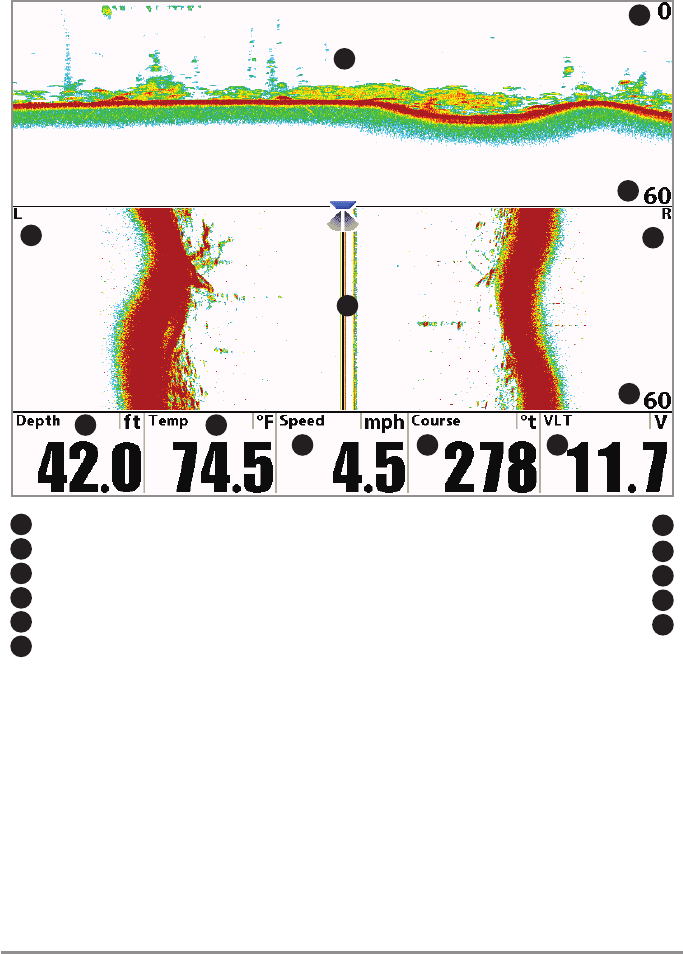
Classic layout: The top portion of the display presents a historical log of sonar returns from the
200 kHz down-looking sonar beam. New information in the down beam panel scrolls from right
to left. The bottom portion of the display presents a historical log of sonar returns from the 455
kHz right- and left-looking sonar beams. New information appears at the top and scrolls down
the display.
Water Surface Line for 455 kHz Sonar History Windows
8
200 kHz Sonar History Window
9
Upper Depth Range
10
Lower Depth Range
11
Side Beam View, Classic Layout
12
3 4
Depth
1
Temp:
water surface temperature
2
Speed:
speed of boat
3
Course:
the current direction the boat is traveling measured in degrees from North
4
VLT:
Voltage
5
Left Side 455 kHz Sonar History Window
6
5
Right Side 455 kHz Sonar History Window
7
7
6
9
8
10
11
11
Views 58

59 Views
Slanted layout: This layout presents the two 455 kHz side sonar beams and the 200 kHz down-
looking sonar beam as three panels of historical data. This layout is presented as three slanted
panels. New information appears on the right and scrolls to the left.
Right Side 455 kHz Sonar History Window
8
Water Surface Line
9
Upper Depth Range
10
Lower Depth Range
11
Side Beam View, Slanted Layout
12
3 4
Depth
1
Temp:
water surface temperature
2
Speed:
speed of boat
3
Course:
the current direction the boat is traveling measured in degrees from North
4
VLT:
Voltage
5
Left Side 455 kHz Sonar History Window
6
5
200 kHz Sonar History Window
7
7
68
9
10
11
9
9

Views 60
Bird’s Eye View
Bird’s Eye View shows a 3D perspective view of the track and the chart’s land contour from a
point above and behind the boat (the eye point). As the boat turns, the eye point moves to follow
the boat.
•To shift the eye point position so that you can look off to the sides, or even behind the
boat: Press the RIGHT or LEFT Cursor keys to turn the eye point right or left. Press the
UP Cursor key to move the eye point forward, and press the DOWN Cursor key to move
the eye point backward.
• Press the EXIT key to move the eye point back to its original position behind and above
the boat.
•Digital Readouts: If all selectable readout boxes are turned off below the Bird's Eye
pane, the window will stretch to fill the whole vertical pane. See Setup Menu Tab:
Select Readouts for more information.
Bird's Eye View (Standard)
12
3 4
Depth
1
Temp:
water surface temperature
2
Speed:
speed of boat
3
Course:
the current direction the boat is traveling measured in degrees from North
4
5
VLT:
Voltage
5
Boat Icon
6
Cartography
7
6
7
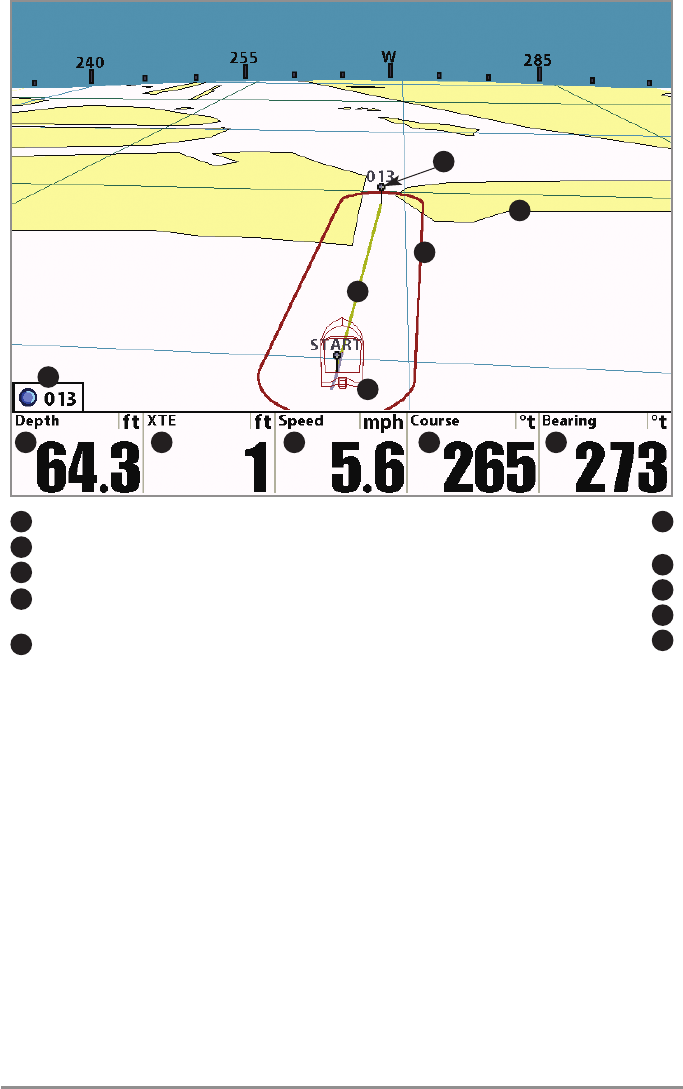
61 Views
XTE (Cross Track Error):
Distance of Boat from Route
3
Depth
2
Next Waypoint
1
Course:
the current direction the boat is traveling measured
in degrees from North
5
Bearing:
Direction to Destination Waypoint
measured in degrees from North
6
Boat Icon
7
Route
8
Off Course Limits
9
Cartography
10
Bird’s Eye View (Navigating)
Speed:
the measurement of the boat’s progress across a given
distance, and is the speed measurement provided by GPS
4
1
2 3 4 5 6
7
1
8
9
10

Views 62
Chart View
Chart View shows cartography from the built-in Contour XD™, built-in UniMap™, or an optional
SD map for the area surrounding your current position. The cartography is applied to any
standard Chart View or Combo view that displays a chart. The current track (also known as the
position history or breadcrumb trail) showing where the boat has been, along with saved tracks,
waypoints, and the current route (when navigating), are overlaid on the chart.
NOTE: See Chart Menu tab and Navigation Menu tab for more information.
•Shift/Pan: Use the 4-WAY Cursor Control key to shift/pan the chart to another area.
•Zoom: Press the ZOOM (+/-) keys to zoom in and out.
•Information: Press the INFO key to get information about the chart objects near the
cursor.
Chart View (Standard) with optional-purchase Navionics® Cartography
12
3 4
Depth
1
Temp:
water surface temperature
2
Speed:
speed of boat
3
Course:
the current direction the boat is traveling measured in degrees from North
4
VLT:
Voltage
5
Declutter Icons
6
5
Track
7
Boat Icon
8
Course Projection Line
9
Waypoint
10
Cartography
11
Map Scale
12
6
7
12
11
8
9
10
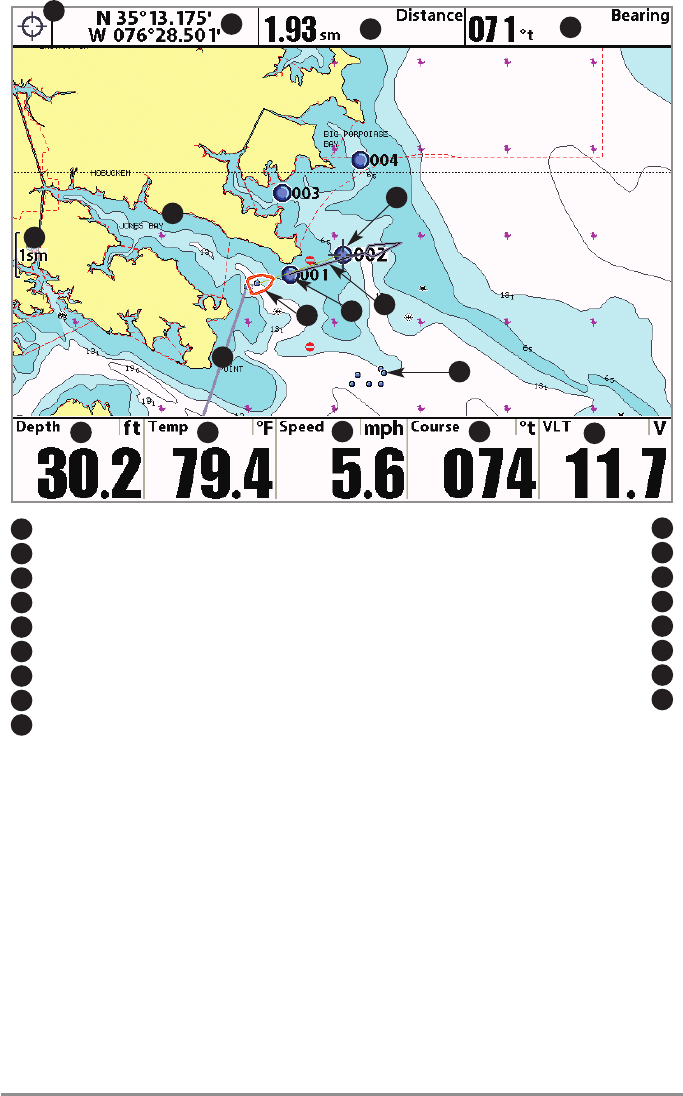
63 Views
Cursor Info Box Track
1
Latitude and Longitude
Position of Cursor
2
Distance
to Cursor
3
Bearing
to Cursor
4
Depth
5
10
Boat Icon
11
Waypoint
12
Course Projection Line
13
Active Cursor
14
Decluttered Waypoint icons
15
Temp:
Water Surface Temperature
6
Speed:
Speed of Boat
7
Course:
the current direction the boat is traveling measured in degrees from North
8
VLT:
Voltage
9
Cartography
16
Map Scale
17
Chart View (with Cursor) with optional-purchase Navionics® Cartography
1234
5 6 7 8 9
10
12
14
17
11 13
15
16

Combo Views 64
Combo Views
Combo Views display two views (or more) on the screen at the same time. You can perform
functions for either side of the view, access the X-Press™ Menu, and change the left view
display size. The available combo views are shown on the following pages.
Combo Views: Functions
The Combo Views allow you to observe and control two views at once. To change the settings
for either side of the view, the individual view must be selected as the active side.
• The green arrow points to the active side.
•Active Side: Press the MENU key once and select Active Side from the X-Press™ Menu.
Choose RIGHT or LEFT to set the active side.
•X-Press™Menu: After you set the Active Side, press the MENU key once to access the
X-Press™ Menu. The X-Press™ Menu provides settings for the active view, and the
display updates immediately with your changes.
•Display Size: Press the MENU key once and select Split Position from the X-Press™
Menu. Split Position allows you to adjust the size of the left side of the display.
•Active Cursor: Press any arrow on the 4-WAY Cursor Control key, and the cursor will
appear on the active side of the view.
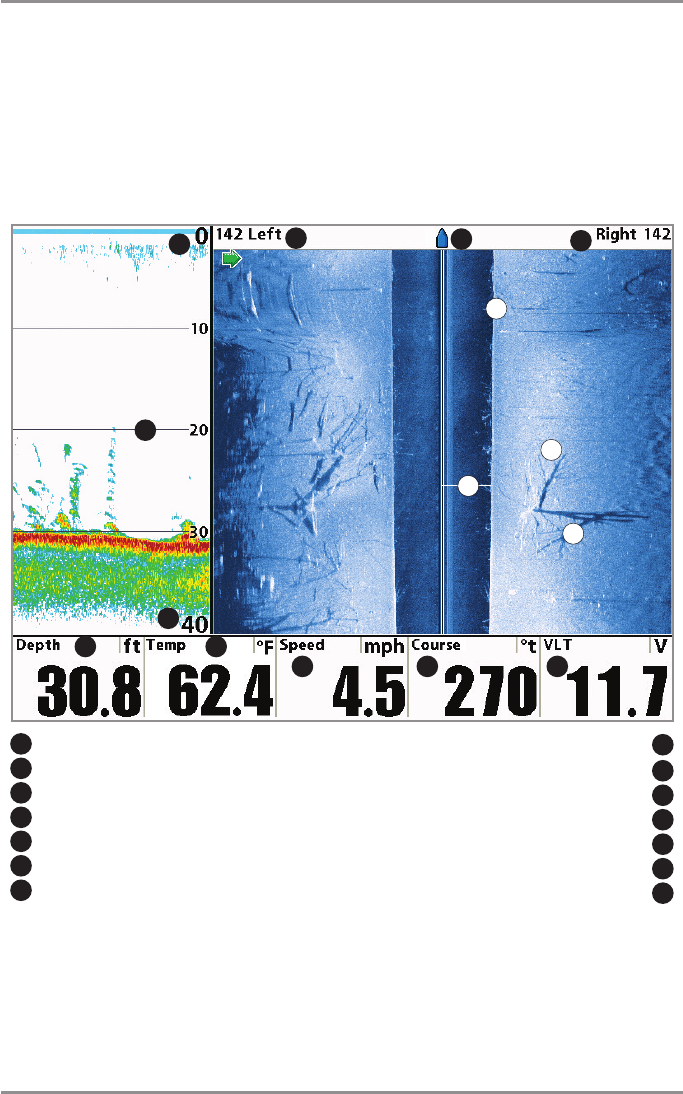
65 Combo Views
Side Imaging®/Sonar Combo View (1198c SI only)
Side/Sonar Combo View shows sonar information and Side Imaging® sonar information in a
combination split screen, where the Sonar View is displayed on the left and the Side Imaging®
View is displayed on the right.
Select an Active Side, and you can adjust the sensitivity, the side beam range, the chart scrolling
speed, and the color scheme of the display. For more information about each side of this combo
view, see Sonar View and Side Imaging® View.
Side/Sonar Combo View
Side Imaging® Range
9
Boat Icon
10
Bottom Return
11
Tree
12
Shadows
13
Water Column
14
12
3 4
Depth
1
Temp:
water surface temperature
2
Speed:
speed of boat
3
Course:
the current direction the boat is traveling measured in degrees from North
4
VLT:
Voltage
5
Upper Depth Range
6
Depth Lines
7
5
Lower Depth Range
8
6
8
7
99
10
11
13
12
14
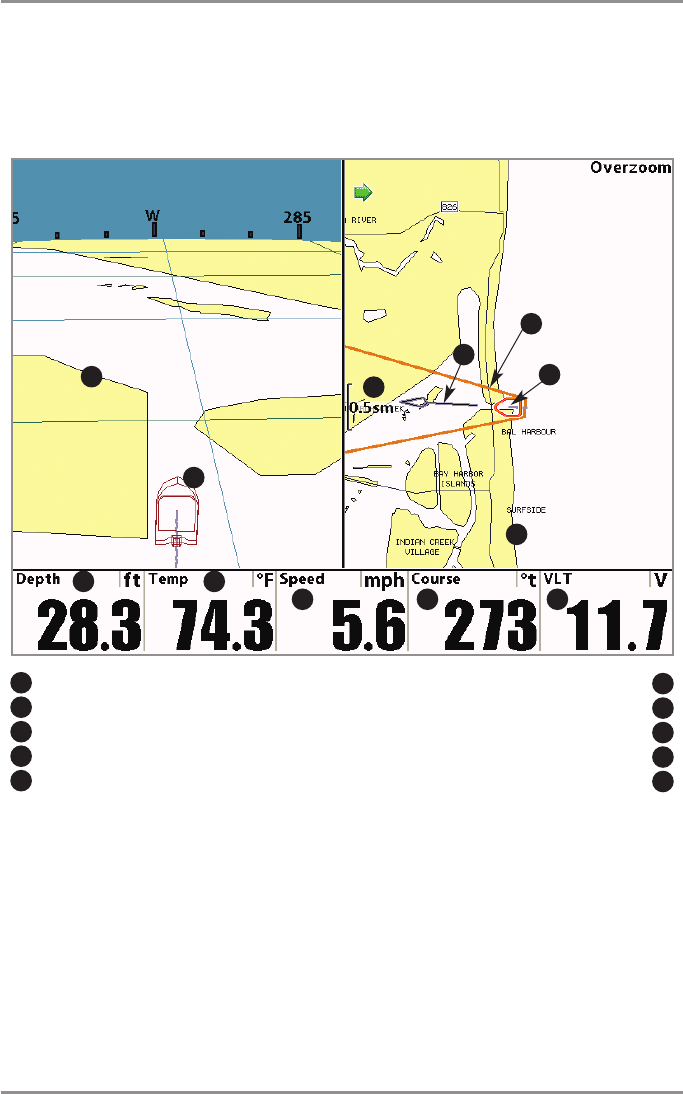
Combo Views 66
Chart/Bird’s Eye Combo View
Chart/Bird’s Eye Combo View shows the Chart and Bird’s Eye views in a combination split
screen, where the Bird’s Eye View is displayed on the left and the Chart View is displayed on
the right. For more information about each side of this combo view, see Chart View and Bird’s
Eye View.
Chart/Bird’s Eye Combo View (Standard)
12
3 4
Depth
1
Temp:
water surface temperature
2
Speed:
speed of boat
3
Course:
the current direction the boat is traveling measured in degrees from North
4
VLT:
Voltage
5
5
Cartography
6
Boat Icon
7
3D View Outline
8
Course Projection Line
9
Map Scale
10
6
7
67
8
9
10
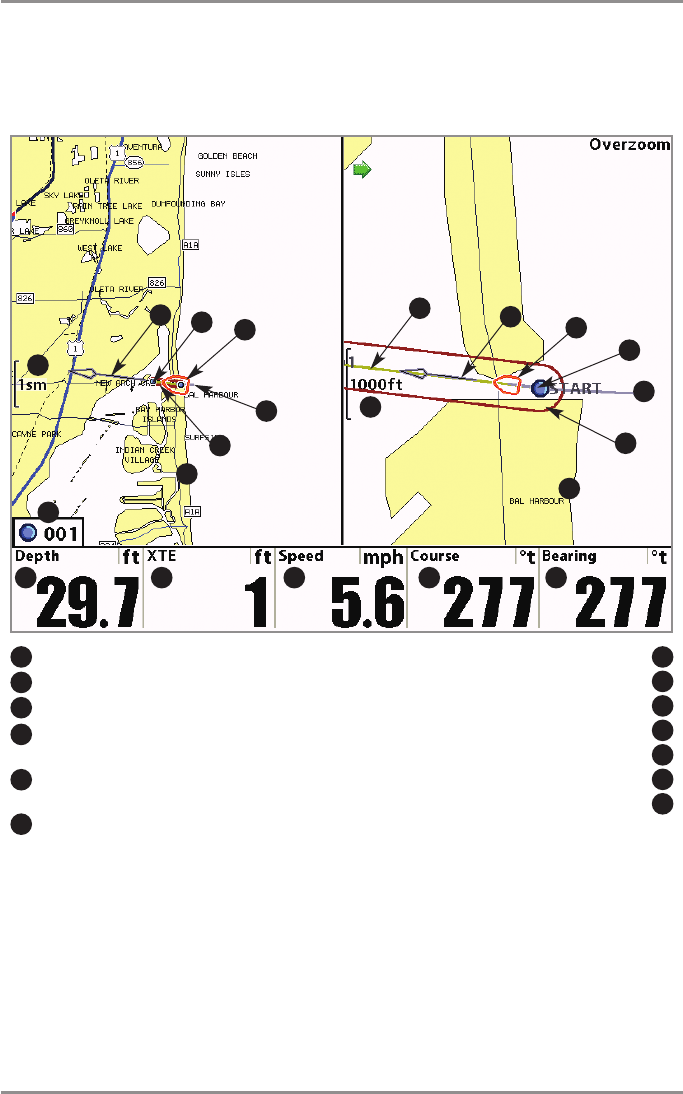
67 Combo Views
Chart/Chart Combo View
Chart/Chart Combo View shows two versions of the Chart view in a combination split screen
so that you can see the position of the boat on one side while you zoom in or perform other
functions on the other. See Chart View for more information.
XTE (Cross Track Error):
Distance of Boat from Route
3
Depth
2
Next Waypoint
1
Course:
the current direction the boat is traveling measured
in degrees from North
5
Bearing:
Direction to Destination Waypoint
measured in degrees from North
6
Cartography
7
Off Course Limits
8
Track
9
Boat Icon
10
Course Projection Line
11
Route
12
Map Scale
13
14
Chart/Chart Combo View (Navigating)
Speed:
the measurement of the boat’s progress across a given
distance, and is the speed measurement provided by GPS
4
1
2 3 4 5 6
7
13
1
8
10
7
9
10 11
12
11 1
13
9
8

Combo Views 68
Chart/Sonar Combo View
Chart/Sonar Combo View shows both the Chart and Sonar views in a combination split screen,
where the Sonar View is displayed on the left and the Chart View is displayed on the right. For
more information about each side of this combo view, see Chart View and Sonar View.
Chart/Sonar Combo View
12
3 4
Depth
1
Temp:
water surface temperature
2
Speed:
speed of boat
3
Course:
the current direction the boat is traveling measured in degrees from North
4
VLT:
Voltage
5
Chart Window
6
5
Cartography
7
Boat Icon
8
Course Projection Line
9
Map Scale
10
Sonar Window
11
Depth Lines
12
6
7
8
9
10
11
12

69 Combo Views
Chart/Side Imaging® Combo View (1198c SI only)
Chart/Side Combo View shows chart information and Side Imaging® sonar information in a
combination split screen, where the Side Imaging® View is displayed on the left and the Chart
View is displayed on the right. For more information about each side of this combo view, see
Chart View and Side Imaging®View.
Chart/Side Combo View
12
3 4
Depth
1
Temp:
water surface temperature
2
Speed:
speed of boat
3
Course:
the current direction the boat is traveling measured in degrees from North
4
VLT:
Voltage
5
Chart Window
6
Cartography
7
5
Boat Icon
8
Course Projection Line
9
Map Scale
10
Side View Range
11
Side View Window
12
Bottom Return
13
6
7
8
9
10
12
11
8
13

Combo Views 70
Down Imaging™/Side Imaging® Combo View (1198c SI only)
Down/Side Imaging®Combo View shows Down Imaging™ and Side Imaging® sonar
information in a combination split screen, where the Down Imaging™View is displayed on the
left and the Side Imaging® View is displayed on the right. For more information about each side
of this combo view, see Down Imaging™View and Side Imaging®View.
Down Imaging™/Side Imaging® Combo View
12
3 4
Depth
1
Boat Position: Latitude/Longitude
2
Speed:
speed of boat
3
Course:
the current direction the boat is traveling measured in degrees from North
4
VLT:
Voltage
5
Down Imaging™ Window
6
Side Imaging® Window
7
5
Bottom Return
8
Topography Changes
9
Side view Range
10
Boat Icon
11
Green Arrow: Active Side
12
Upper Range
13
7
11
9
10
6
12
13
8
8
10
Lower Range
14
14

71 Combo Views
Chart/Down Imaging™ Combo View (1158c DI and 1198c SI only)
Chart/Down Imaging™ Combo View shows Chart and Down Imaging™ information in a
combination split screen, where the Down Imaging™View is displayed on the left and the Chart
View is displayed on the right. For more information about each side of this combo view, see
Down Imaging™ View and Chart View.
Chart/Down Imaging™Combo View
12
3 4
Depth
1
Boat Position: Latitude/Longitude
2
Speed:
speed of boat
3
Course:
the current direction the boat is traveling measured in degrees from North
4
VLT:
Voltage
5
Chart Window
6
Down Imaging
™
Window
7
5
Bottom Return
8
Upper Range
9
Lower Range
10
Green Arrow: Active Side
11
Cartography
12
Map Scale
13
6
12
8
14
13
7
11
9
10
Boat Icon
14
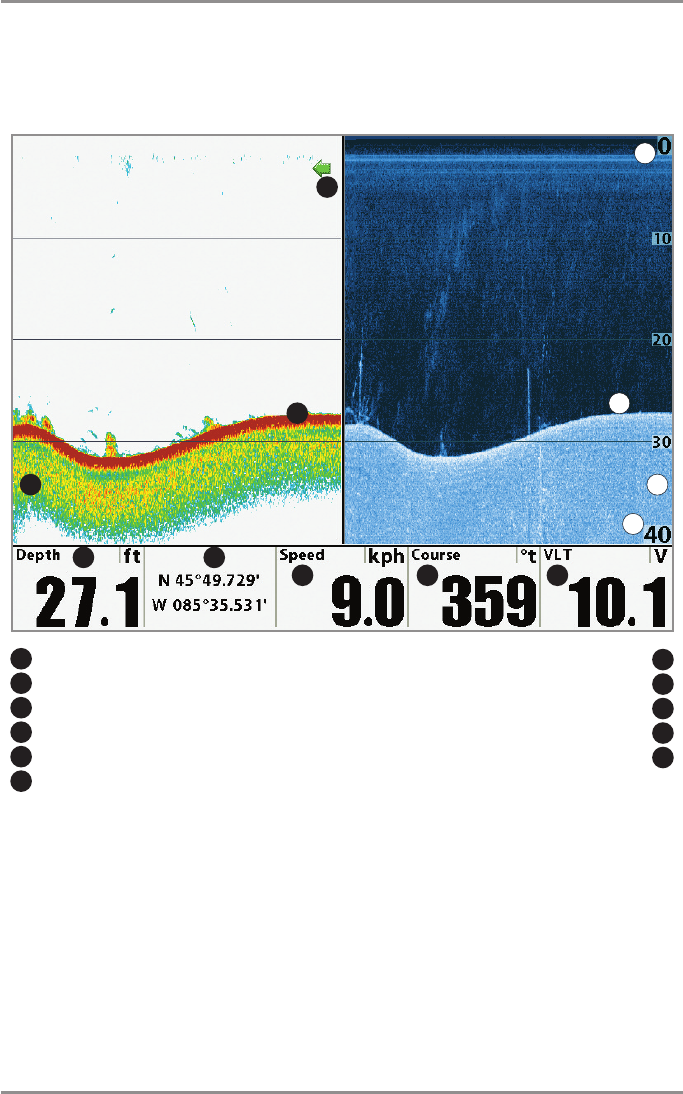
Combo Views 72
Down Imaging™/Sonar Combo View (1158c DI and 1198c SI only)
Down Imaging™/Sonar Combo View shows traditional Sonar information on the left and
Down Imaging™ sonar information on the right. For more information about each side of this
combo view, see Down Imaging™ View and Sonar View.
Down Imaging™/Sonar Combo View
12
3 4
Depth
1
Boat Position: Latitude/Longitude
2
Speed:
speed of boat
3
Course:
the current direction the boat is traveling measured in degrees from North
4
VLT:
Voltage
5
Sonar Window
6
7
5
Down Imaging™ Window
7
Upper Range
8
Lower Range
9
Green Arrow: Active Side
10
Bottom Return
11
13
7
9
8
10
6
11 11

73 Combo Views
Down Imaging™/Side Imaging®/Sonar Combo View (1198c SI only)
Down Imaging™/Side Imaging®/Sonar Combo View shows Down Imaging™ and traditional
Sonar information on the left side of the screen, and Side Imaging® on the right side of the
screen. If you use the active cursor on the left side of the screen, a cursor will appear in both
the Sonar and Down Imaging™ views. For more information about each side of this combo view,
see Down Imaging™ View,Side Imaging® View, and Sonar View.
Down Imaging™/Side Imaging®/Sonar Combo View
Depth
1
Boat Position: Latitude/Longitude
2
Speed:
speed of boat
3
Course:
the current direction the boat is traveling measured in degrees from North
4
VLT:
Voltage
5
6
7
Down Imaging™Window
6
Sonar Window
7
Side Imaging®Window
8
Green Arrow: Active Side
9
12
13
12
3 4 5
8
9
7
11
6

Viewing Cartography 74
Chart Orientation
All of the chart views allow you to choose the orientation of the chart. In both orientations, the
view pans automatically so that the boat is always centered on the display.
NOTE: The Chart Orientation setting does not apply to the Bird’s Eye View.
•North-Up: True North is shown at the top of the display. Objects located to the north of
the boat are drawn above the boat.
•Course-Up: The direction of motion of the boat is shown at the top of the display.
Objects ahead of the boat are drawn above the boat.
When the boat is stationary, it is drawn as a circle.
When the boat is in motion, it takes on a boat shape, pointed in the direction of
motion (always Up in the Course-Up orientation).
Viewing Cartography
In the Chart or Combo Views, there are several cartography-related functions that you can
access using various keys.
Panning: Use the 4-WAY Cursor Control key to move the chart around on the display in the
direction of the key being pressed. When you do this, a Bullseye Cursor is drawn at the top of
the screen and is linked to the boat by a yellow line, even if the boat is off the screen. At the
same time, a cursor dialog box is displayed with the distance and bearing from the boat to the
cursor position and the latitude/longitude coordinates of the cursor. When the cursor is active
on the display, you can also use the 4-WAY Cursor Control key to move the cursor diagonally.
Chart View with Cursor Present, with optional-purchase Navionics® cartography

75 Viewing Cartography
Zooming: Press the Plus (+) key to Zoom In and the Minus (-) key to Zoom Out to see the
cartography at different magnification levels. The zoom level is indicated on the left side of the
display. If you zoom in beyond the available chart data, the display will go into Overzoom mode
whereby the last available chart data is amplified to reflect the level selected. If you zoom in so
far that no cartography is available, a lat/long grid will be drawn instead.
Screen Snapshots and Recording Icons: When a waypoint is created while Screen Snapshot
and Recording is active, the waypoint will appear as a snapshot icon or recording icon in chart
views. See Views: Snapshot and Recording View for more information.
Chart Info: Press the INFO key to get detailed information about the chart. If the cursor is
active, you will see information about the chart objects located near the cursor.
If the cursor is not active, the Chart Info submenu will appear.
Use the 4-WAY Cursor Control key to select the Nearest Port, the
Nearest Tide Station, or the Nearest Current Station and see
information about any of these objects.
NOTE: The built-in UniMap™ does not contain any Port, Tide, or
Current information. This information is only available from optional-
purchase SD cards.
Nearest Port: The position and services information for the nearest port to your present position
will be displayed. Press the EXIT key to remove the information box and the cursor bull’s eye will
be centered over the port position. The cursor information boxes will indicate the distance and
bearing to the port from your present position.
Nearest Tide Station: Tide information for the nearest tide station to your present position will
be displayed. This includes the position of the station and the times of the high and low tides
for today’s date. A tide graph is also displayed showing the rise and fall of the tides for the 24
hour time period encompassing the date. You can change the date to look at tide information
before or after the date displayed by pressing the LEFT or RIGHT Cursor key respectively. Press
the EXIT key to remove the information box, and the cursor bull’s eye will be centered over the
tide station position. The cursor information boxes indicate the distance and bearing to the tide
station from your present position.
Nearest Current Station: Current information for the nearest current station to your present
position will be displayed. This includes the position of the station and the current changes for
today. Two graphs are also presented that show the time, direction, and flow speed of the
current changes for the 24 hour time period of today’s date. You can change the date to look at
current information before or after the date displayed by pressing the LEFT or RIGHT Cursor key
respectively. Press the EXIT key to remove the information box, and the cursor bull’s eye will be
centered over the current station position. The cursor information boxes will indicate the
distance and bearing to the current station from your present position.

Introduction to Navigation 76
Introduction to Navigation
Use the 1100 Series™ to establish waypoints at areas of interest and to navigate to those
waypoints via a saveable route (representing the shortest intended distance between
waypoints). You can also view and save tracks, which represent the actual path of the boat.
Waypoints, Routes, and Tracks
Waypoints are stored positions that allow you to mark areas of interest or navigation points.
Your 1100 Series™ can store up to 2,750 waypoints.
Routes link two or more waypoints together to create a path for navigation, and are used in trip
planning. You can link individual waypoints together by using the GOTO key. A route represents
your intended navigation and shows the shortest path from each waypoint to the next. As you
travel a route, staying on the route line is the most efficient way to get to your destination,
although you should always look out for obstacles not shown on the chart. Your 1100 Series™
can store up to 45 routes that can each contain up to 50 waypoints.
Tracks consist of detailed position history, and are displayed as a breadcrumb trail of
trackpoints. The Current Track shows the position history since the unit was powered up
(maximum of 20,000 trackpoints displayed). You can clear the Current Track or save it at any
time. Your 1100 Series™ can store up to 50 saved tracks, each containing 20,000 trackpoints.
The current track represents your actual path so far.
NOTE: The maximum number of waypoints and routes may vary due to the setup of your Waypoint
Management directory. Groups and sub-groups also use storage, and the storage limit is influenced
by the complexity of your Waypoint Management directory. See your Waypoint Management Guide
for details.

77 Introduction to Navigation
XTE (Cross Track Error):
Distance of Boat from Route
3
Depth
2
Next Waypoint
1
Course:
the current direction the boat is traveling measured
in degrees from North
5
Bearing:
Direction to Destination Waypoint
measured in degrees from North
6
Cartography
7
Off Course Limits
8
Arrival Alarm Limits
9
Route
10
Course Projection Line
11
Boat Icon
12
Track
13
Waypoint
14
Waypoints, Routes and Tracks
Speed:
the measurement of the boat’s progress across a given
distance, and is the speed measurement provided by GPS
4
1
2 3 4 5 6
7
15
8
10
11
1
9
12
Decluttered Waypoints
15
13
14
NOTE: When two or more waypoints overlap, or are displayed close together on a chart view, the
screen will automatically declutter—waypoint names will shorten and the waypoint icons will
change into small blue icons.
To view a Decluttered Waypoint at full size, use the 4-WAY Cursor Control key to move the cursor
onto a decluttered waypoint icon. When the cursor snaps onto the icon, the full-size waypoint name
and icon will be displayed. You can also press the ZOOM+ key until you can see the individual
waypoints on the screen. See Navigation Menu Tab: Waypoint Decluttering to turn off this
feature.

Introduction to Navigation 78
Save, Edit, or Delete a Waypoint
Save your current position as a waypoint: On any view, press the MARK key to save the current
position of the boat as a waypoint.
Save the cursor position as a waypoint: On the Chart or Combo View, use the 4-WAY Cursor
Control key to move the cursor to the position you want to save as a waypoint. Then press the
MARK key to save the position as a waypoint.
Save a position from the sonar history: On any Sonar View, Side Imaging®View, or
Down Imaging™View, use the 4-WAY Cursor Control key to move the cursor to a feature in the
sonar history. Press the MARK key to create a waypoint at the location where that sonar reading
was taken. The new waypoint will also record the depth at that location.
Display the Waypoints Submenu: From any view, press the MENU key twice to display the
Main Menu, then press the RIGHT Cursor key to select the Navigation tab. Select Waypoints,
and press the RIGHT Cursor key to display the Waypoints submenu.
Program a specific position as a waypoint: To create a waypoint that is NOT your current
position, from the Waypoints submenu select Create, and press the RIGHT Cursor key. Use the
4-WAY Cursor Control key to program a waypoint name, latitude, longitude, and icon before
selecting Save.
Edit a waypoint: From the Waypoints submenu, select Edit and press the RIGHT Cursor key to
display the saved waypoints list. Select the waypoint you want to edit and press the RIGHT
Cursor key. Use the 4-WAY Cursor Control key to edit a waypoint name, latitude, longitude, and
icon before selecting Save.
To make it easier to select a waypoint to edit, select Sort By and press the RIGHT or LEFT Cursor
keys to select a sort order:
•Name shows the waypoints alphabetically.
•Time shows the most recently-created waypoint first.
•Distance shows the closest waypoint first.
NOTE: When you save a waypoint by any of these methods, a numerical waypoint name is
automatically assigned. You can edit the waypoint information later to give it a different name and
select an icon to represent it (see Program or Edit the waypoint fields).

79 Introduction to Navigation
Navigate to a Waypoint or Position
Navigate to the cursor position: From the Chart View, Side Imaging®View, Chart Combo Views,
or Side Imaging® Combo Views, use the 4-WAY Cursor Control key to move the cursor to a
position or waypoint on the display. Press the GOTO key. Navigation will begin immediately.
Navigate to a specified waypoint: Press the GOTO key. Press the DOWN Cursor key to highlight
a waypoint from the saved waypoints list, and press the RIGHT Cursor key to start navigation.
NOTE: By repeating the previous instructions, you can add more waypoints to create a longer multi-
segment route.
Skip a waypoint: From the Navigation X-Press™ Menu, select Skip Next Waypoint, and press
the RIGHT Cursor key. If there is not another waypoint to skip to, navigation will be cancelled.
Cancel navigation: From the Navigation X-Press™ Menu, select Cancel Navigation, and press
the RIGHT Cursor key. Canceling navigation removes the route and any waypoints created using
the GOTO key, but it does not remove any saved routes from memory. You will be prompted to
save the current route when you cancel navigation.
Program or Edit the waypoint fields: Use the 4-WAY Cursor Control key to move from field to
field, and the UP and DOWN Cursor keys to change values once you are in a field.
In the Waypoint Name, Latitude, and Longitude fields, press the UP and DOWN Cursor keys to
change the letter or number. All upper and lower case letters are available, as well as digits
0-9 and some punctuation characters.
In the Waypoint Icon field, press the UP and DOWN Cursor keys to change the icon used to
represent the waypoint on the Combo and Chart Views. You can exit these fields with the LEFT
and RIGHT Cursor keys or by pressing the EXIT key.

Introduction to Navigation 80
Add a Waypoint Target or Trolling Grid
The Waypoint Target shows a target consisting of concentric circles in various distance ranges
centered on the waypoint you choose. The Trolling Grid shows various distance ranges in grid
format from the waypoint you choose. The trolling grid can be used as a guide when trolling
around a waypoint.
Add a Waypoint Target: From the Waypoints submenu, select Target, and press the RIGHT Cursor
key to display the saved waypoints list. Select a waypoint and press the RIGHT Cursor key.
Add a Trolling Grid: From the Waypoints submenu, select Grid, and press the RIGHT Cursor key to
display the saved waypoints list. Select a waypoint and press the RIGHT Cursor key. The grid can
also be rotated to any heading by adjusting the Grid Rotation setting on the Navigation Menu Tab.
Remove Target or Trolling Grid: Press the MENU key once, and choose Remove Target or Remove
Grid from the Navigation X-Press™ Menu.
NOTE: Only one waypoint can have either a target or a grid applied to it at one time. If you apply a
target or a grid to a new waypoint, the original waypoint will lose its target or grid.
NOTE: The spacing of the rings on the waypoint target and the spacing of the grid lines on the trolling
grid are the same as the length of the scale bar on the left edge of the display. Zooming in or out will
decrease or increase the spacing, respectively.

81 Introduction to Navigation
Chart View with Target
12
3 4
Depth
1
Temp:
water surface temperature
2
Speed:
speed of boat
3
Course:
the current direction the boat is traveling measured in degrees from North
4
VLT:
Voltage
5
Cartography
6
5
Waypoint Target
7
Targeted Waypoint
8
Course Projection Line
9
Boat Icon
10
Map Scale
11
6
7
9
11
10
8
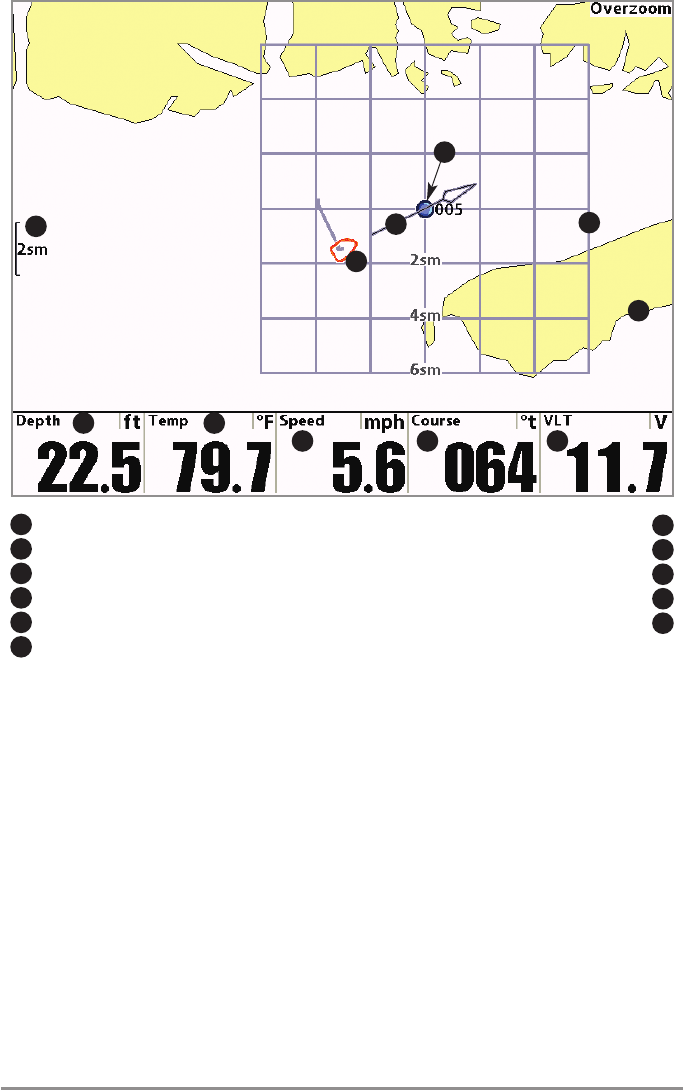
Introduction to Navigation 82
Chart View with Grid
12
3 4
Depth
1
Temp:
water surface temperature
2
Speed:
speed of boat
3
Course:
the current direction the boat is traveling measured in degrees from North
4
VLT:
Voltage
5
Cartography
6
5
Waypoint Trolling Grid
7
Waypoint for Grid
8
Course Projection Line
9
Boat Icon
10
Map Scale
11
6
7
9
11
10
8

83 Introduction to Navigation
Save, Edit, or Delete a Route
Save the current route: While you are navigating, the current route can be saved. From the
Navigation X-Press™ Menu, select Save Current Route, and press the RIGHT Cursor key.
Navigation will continue.
Create a route: From the Routes submenu, select Create and press the RIGHT Cursor key. A
Route Edit dialog box will be displayed with an empty route. You can name the route, add
waypoints to the route from the saved waypoints list, and order the waypoints in the route using
the 4-WAY Cursor Control key to move between fields.
Edit a saved route: From the Routes submenu, select Edit and press the RIGHT Cursor key. A
Route Edit dialog box will be displayed. Select the route you want to edit and press the RIGHT
Cursor key. Re-name the route or change, delete, or re-order the waypoints used in the route.
Edit waypoint order in a route: From the Route Edit dialog box, highlight a waypoint in the In
Route list, and press the RIGHT Cursor key to access the Waypoint In Route submenu. From this
submenu, you can move the waypoint up or down in the route order or delete it from the list.
Delete a saved route: From the Routes submenu, select Delete and press the RIGHT Cursor key.
Select the route you want to delete and press the RIGHT Cursor key. You will be asked to confirm
your choice by pressing the RIGHT Cursor key again before the route is deleted.
Travel a saved route: From the Routes submenu, select Travel, and press the RIGHT Cursor key.
The saved routes list will appear. Select the route you want to travel, and press the RIGHT Cursor
key to make this route the current route and begin navigation. You may also travel the route in
forward or reverse order by changing the Direction setting in the saved routes list.
Route Info: From the Routes submenu, select Info, and press the RIGHT Cursor key. The saved
routes list will appear. Select a route, and press the RIGHT Cursor key. The following information
will be displayed for the route you select: The waypoints in the route, with the distance and
bearing from each waypoint to the next, as well as the distance and bearing from the current
position to the first waypoint in the route.
Save or Clear a Current Track
Save the current track: From the Navigation X-Press™ Menu, select Save Current Track, and
press the RIGHT Cursor key. The track will remain on the display but will change from black to
gray. To remove the track completely from the display, see Edit, Delete, or Hide Saved Tracks.
NOTE: When you save a track, a name is automatically assigned. The track name consists of a
date/time stamp, but can be re-named later (see Edit, Delete, or Hide Saved Tracks).
Clear the current track: From the Navigation X-Press™ Menu, select Clear Current Track, and press
the RIGHT Cursor key. The track will be removed from the display and permanently deleted.
Display the Routes submenu: From any view, press the MENU key twice to display the Main
Menu, then press the RIGHT Cursor key to select the Navigation tab. Press the DOWN Cursor
key until Routes is highlighted, and press the RIGHT Cursor key to display the Routes submenu.

Introduction to Navigation 84
Edit, Delete, or Hide Saved Tracks
Display the Saved Tracks Submenu: From any view, press the MENU key twice to display the
Main Menu, then press the RIGHT Cursor key to select the Navigation tab. Select Saved Tracks,
and press the RIGHT Cursor key to display the Saved Tracks submenu.
Edit a saved track: From the Saved Tracks submenu, select Edit, and press the RIGHT Cursor key
to display the saved tracks list. Select the track you want to edit and press the RIGHT Cursor key.
Delete a saved track: From the Saved Tracks submenu, select Delete, and press the RIGHT
Cursor key to display the saved tracks list. Select the track you want to delete and press the
RIGHT Cursor key. You will be asked to confirm deletion before the track is permanently deleted.
Hide or display a saved track: From the Saved Tracks submenu, select Edit, and press the
RIGHT Cursor key to display the saved tracks list. Select the track you want to hide or display
and press the RIGHT Cursor key to display the Edit Track window. Press the DOWN Cursor key
to select Visibility, and then press the RIGHT Cursor key. Use the UP or DOWN Cursor key to
select Hidden or Visible. Save your changes, and press the EXIT key to return to the Saved Tracks
submenu.
When the Edit Track dialog box appears, use the Cursor keys to move between fields. In the Name
field, the UP and DOWN Cursor keys change the letter or number. All upper and lower case letters
are available, as well as digits 0-9 and some punctuation characters. You can exit the Name field
with the LEFT and RIGHT Cursor keys or by pressing the EXIT key. Select Save and press the RIGHT
Cursor key to save your changes.

85 Introduction to Navigation - MOB
Man Overboard (MOB) Navigation
As soon as you know that you have a man overboard (MOB), you should activate MOB
navigation to maximize the chances for a successful rescue. MOB navigation allows you to
create an MOB waypoint to locate the point at which your man went overboard and the relation
of the boat to that point.
Activate MOB navigation: Press and hold the GOTO key for more than 1.5 seconds to activate
the Man Overboard (MOB) function.
When MOB is activated, a MOB waypoint is created at the boat's current position, regardless of
whether the chart cursor is active or not. The MOB waypoint has a large, distinctive icon. Once
MOB is activated, any current navigation will be cancelled and the current route will be
discarded without user notification. MOB navigation will begin immediately, and the MOB View
will show the following:
• The view will switch to the Chart View, and the elapsed time since MOB was activated
will be displayed.
• A line will be drawn from the boat's current position to the MOB waypoint, and the MOB
waypoint will be targeted.
• The latitude/longitude position of the MOB waypoint will be displayed in an additional
information box.
Cancel MOB Navigation: From the Navigation X-Press™ Menu, select Cancel MOB, and press
the RIGHT Cursor key. Canceling MOB navigation removes the route and any waypoints created
using the GOTO key but does not remove any saved routes from memory.
It is not possible to re-activate MOB or modify the current route without first canceling MOB
navigation. The Off Course trigger is also disabled and the Off Course Alarm circle is not drawn.
Any press of the GOTO key, or selection of a GOTO menu option, will cause an error beep and
a short message will be displayed that will disappear after 2 seconds.

Introduction to Navigation - MOB 86
MOB Navigation
12
3 4
Depth
1
XTE (Cross Track Error):
Distance of Boat from Route
2
Speed:
speed of boat
3
Course:
the current direction the boat is traveling measured
in degrees from North
4
Bearing:
Direction to Destination Waypoint measured in
degrees from North
5
5
Position
where Man Overboard was activated
6
Elapsed Time
since MOB was activated
7
MOB Waypoint
8
Target
Surrounding MOB Waypoint
9
Course Projection Line
10
Map Scale
11
67
8
11
9
10

87 The Menu System
The Menu System
The Menu System is divided into easy-to-use menu modules as follows:
•Start-Up Options Menu: Press the MENU key during the power on sequence to view
the Start-Up Options Menu. From the Start-Up Options Menu, you can choose the
following Fishfinder Modes: Normal, Simulator, and System Status.
•X-Press™ Menu: The X-Press™ Menu provides a shortcut to the most frequently-used
settings, and the options on the X-Press™ Menu correspond with the current view.
•Main Menu: The Main Menu is a standard set of menu settings which are organized
under the following tabbed headings: Alarms, Sonar, Navigation, Chart, Setup, Views,
and Accessories.
NOTE: The X-Press™ Menu(s) and the Main Menu options can also be expanded or simplified by
setting the User Mode to Advanced or Normal (see Main Menu: User Mode).
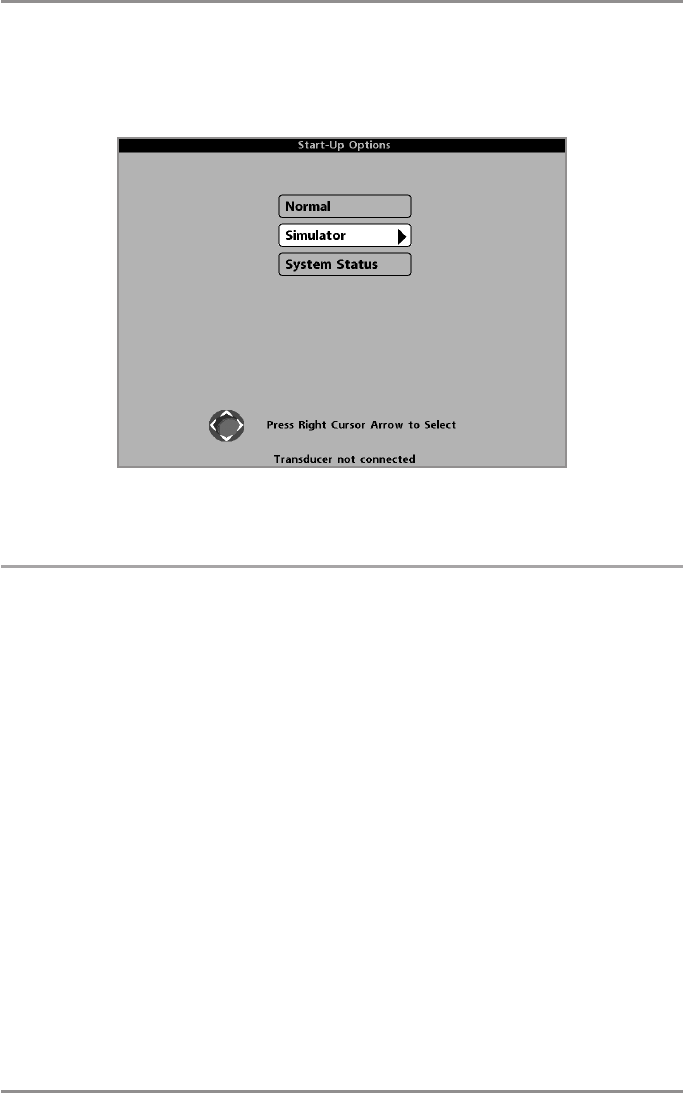
Start-Up Options Menu 88
Start-Up Options Menu
Press the MENU key during the power on sequence to view the Start-Up Options Menu, and
select one of the modes described on the following pages. Also, see Power On the Control Head
for more information.
Normal
Use Normal for on-the-water operation with a transducer connected. If a functioning
transducer is connected, Normal operation will be selected automatically at power up, and your
Fishing System can be used on the water.
To exit Normal operation, power off your Fishing System.
Start-Up Options Menu
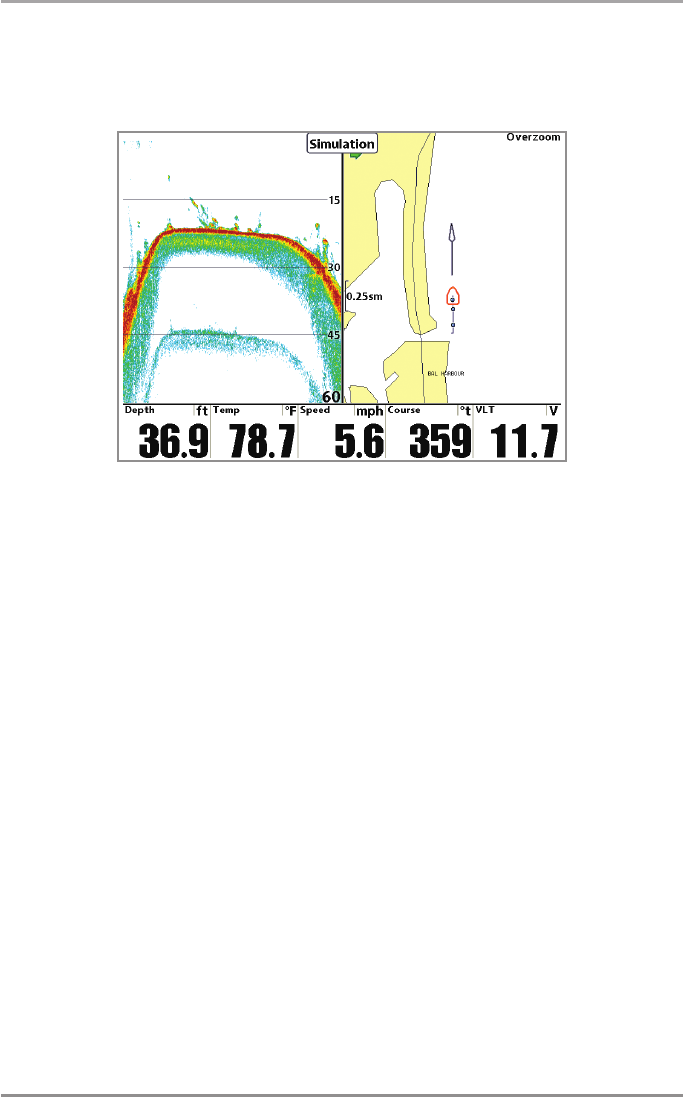
89 Start-Up Options Menu
Simulator
Use Simulator to learn how to use your Fishfinder before taking your boat on the water. The
Simulator is a very powerful tool that provides a randomly-updated display which simulates on
the water operation.
We recommend going through this manual while using the Simulator, since all of the menus
function and affect the display in the same way as they would in Normal operation. Any menu
changes you make will be saved for later use.
• A message will appear often on the display to indicate Simulator mode.
•To exit Simulator, power off your Fishfinder.
NOTE: It is important to select Simulator manually from the Start-Up Options Menu as opposed to
letting the Fishfinder enter Simulator automatically (as it will if a transducer is not connected and you
do nothing during power up). See Power On the Control Head for more information.
Simulator
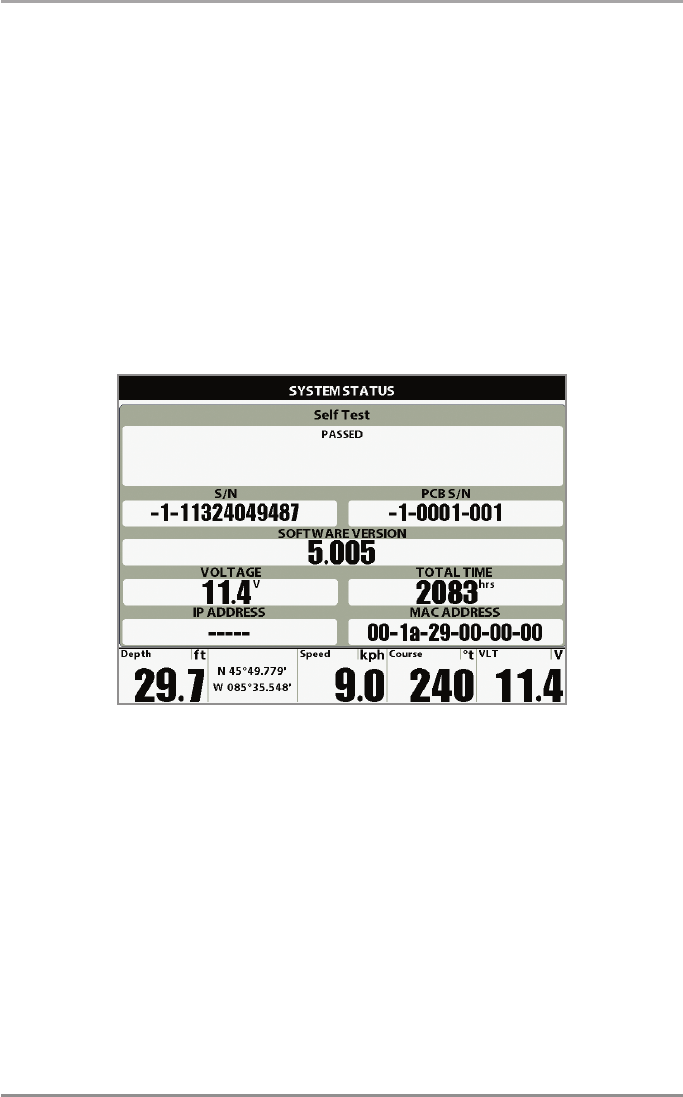
Start-Up Options Menu 90
System Status
Use System Status to view system connections and to conduct a unit self-test.
After you select System Status from the Start-Up Options Menu, press the VIEW key to display
the following options:
• Self Test
• Accessory Test
• GPS Diagnostic View
To exit System Status, power off your Fishfinder.
Self Test displays results from the internal diagnostic self test, including unit serial number,
Printed Circuit Board (PCB) serial number, software revision, total hours of operation, and the
input voltage. IP and MAC addresses are also displayed.
Self Test Screen

91 Start-Up Options Menu
Accessory Test lists the accessories connected to the system.
NOTE: The speed accessory will be detected only if the paddlewheel has moved since your Fishfinder
was powered up.
Accessory Test Screen
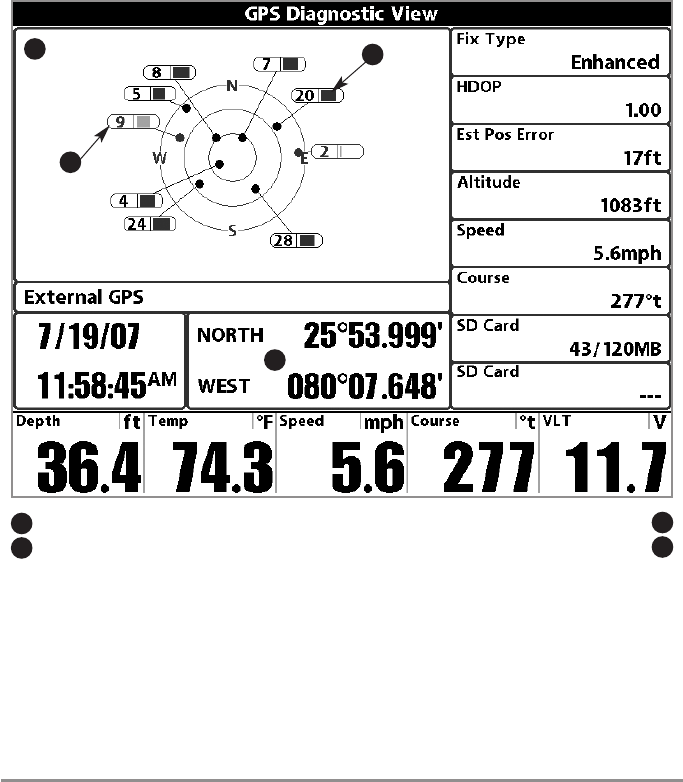
Start-Up Options Menu 92
GPS Diagnostic View shows a sky chart and numerical data from the GPS receiver. The sky chart
shows the location of each visible GPS satellite with its satellite number and a signal strength bar.
A dark gray bar indicates that the satellite is being used to determine your current position. A light
gray bar indicates that the satellite is being monitored, but is not yet being used.
This view also reports the current position, local time and date, and other numeric information.
The current GPS Fix Type is reported as No Fix, 2D Fix, 3D Fix, or Enhanced. An Enhanced fix has
been augmented using information from WAAS, EGNOS, or MSAS. A 3D or Enhanced Fix is
required for navigation. HDOP (the Horizontal Dilution of Precision) is a GPS system parameter
which depends on the current satellite configuration. HDOP is used to calculate the Estimated
Position Error.
NOTE: This view is only available when a GPS Receiver is attached to the control head.
Sky Chart Satellite Being Monitored
1
Satellite Being Used
2
3
Current Latitude and Longitude
4
GPS Diagnostic View
12
3
4
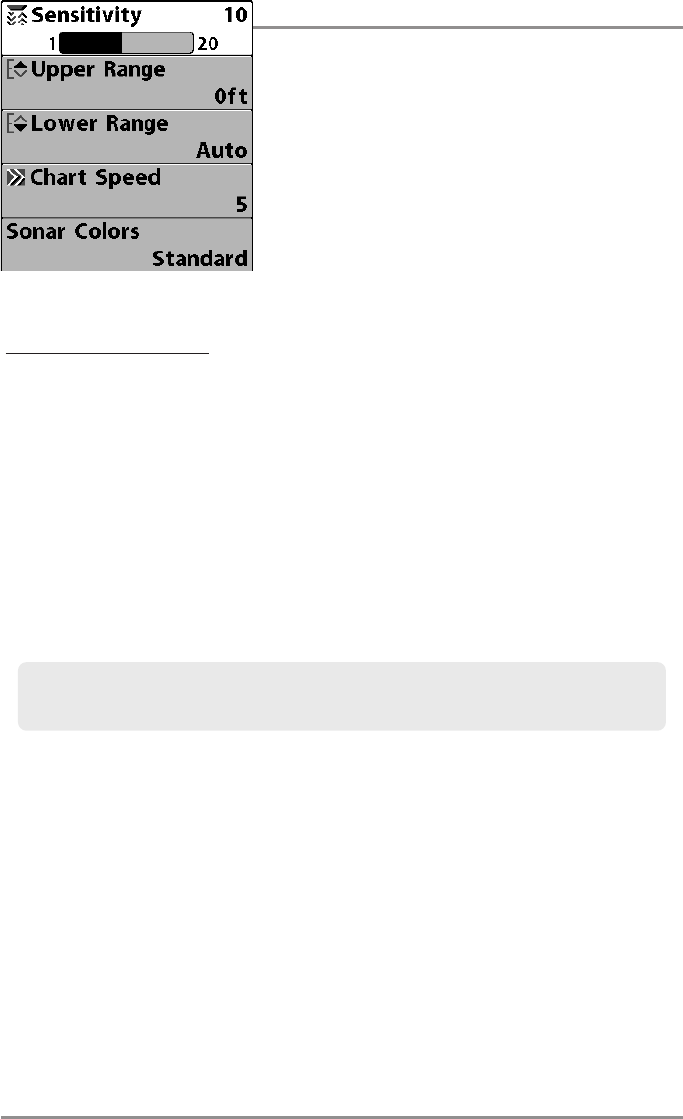
93 X-Press™ Menu
X-Press™ Menu
The X-Press™ Menu provides a shortcut to your most
frequently-used settings. The options provided on the
X-Press™ Menu correspond with the current view. For
example, if you are in a Sonar View and press the MENU
key once, the Sonar X-Press™ Menu will display.
To use an X-Press™ Menu:
1. In any view, press the MENU key once.
2. Press the UP or DOWN Cursor keys to highlight an X-Press™ Menu option, then use the
RIGHT or LEFT Cursor keys to change the menu setting.
NOTE: The X-Press™ Menu will collapse temporarily and the screen will update if it is affected by
your menu setting change, which allows you to see the effects of your change immediately.
3. Reactivate the X-Press™ Menu by pressing the UP or DOWN Cursor keys.
Total Screen Update™-When you change any menu settings that affect the current view, the
view will update immediately (i.e. you don’t have to exit the menu to apply the change to the
screen).
X-Press™ Menu
Menu options can be simplified or expanded by setting the User Mode to Normal or Advanced.
See Main Menu: User Mode for details.

Main Menu 94
Main Menu
The Main Menu provides the standard set of menu
options, including the settings that are changed less
frequently. The Main Menu is organized under the
following tabs to help you find a specific menu item
quickly: Alarms, Sonar, Navigation, Chart, Setup, Views,
and Accessories.
NOTE: Menu options can be expanded or simplified by setting
the User Mode to Advanced or Normal. See Main Menu: User
Mode for details.
To use the Main Menu:
1. In any view, press the MENU key twice.
2. Press the RIGHT or LEFT Cursor keys to highlight a menu tab.
3. Press the DOWN or UP Cursor keys to select a specific menu option under that tab.
4. Press the RIGHT or LEFT Cursor keys again to change a menu setting.
• A down arrow at the bottom of a menu means that you can scroll to additional
menu options using the DOWN Cursor key.
• A right or left arrow on a menu option means that you can use the RIGHT or LEFT
Cursor keys to make changes or to see more information.
• Press the EXIT key to move quickly to the top of the tab.
Main Menu System
Normal User Mode
Total Screen Update™-When you change any menu settings that affect the current view, the
view will update immediately (i.e. you don’t have to exit the menu to apply the change to the
screen).
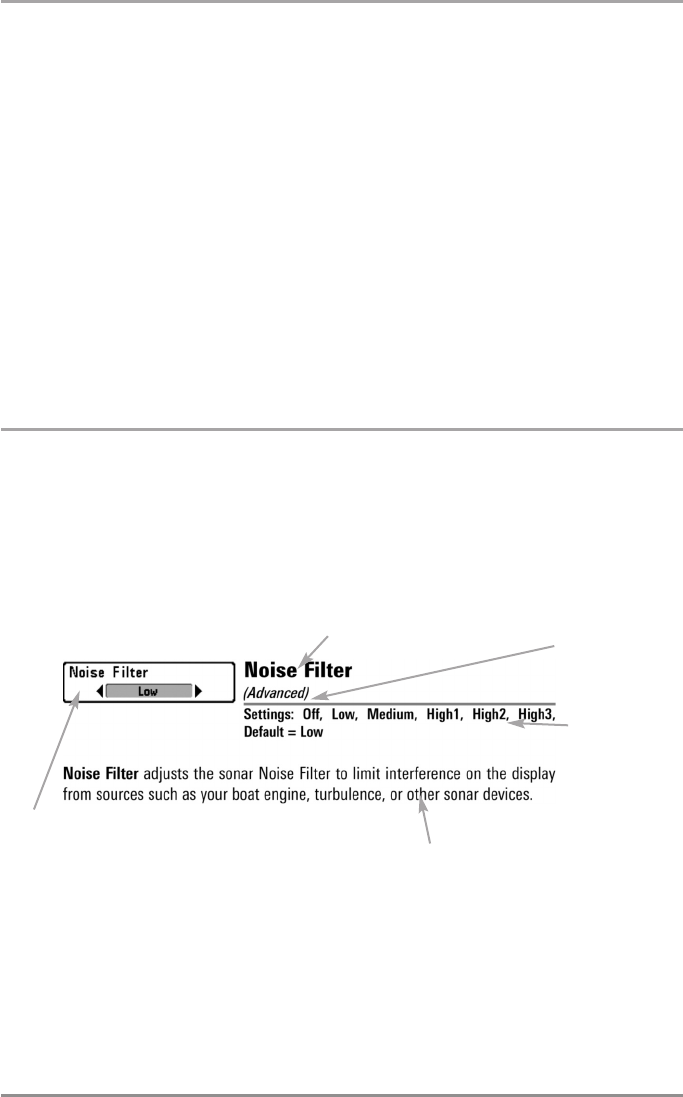
95 Menu Quick Tips
Quick Tips for the Main Menu
•From any menu option on a menu tab, press the EXIT key to jump directly to the top of
the tab.
•From the bottom of a menu tab, press the DOWN Cursor key to jump directly to the top
of the tab.
•From the top of a menu tab, press the LEFT or RIGHT Cursor keys to scroll to the next
tab. You can also jump to the beginning or end of the tab rotation by repeatedly pressing
the RIGHT or LEFT Cursor keys.
• If there is a down arrow at the bottom of a menu tab, press the DOWN Cursor key to
scroll to additional menu options.
• If there is a right or left arrow on a menu option, press the RIGHT or LEFT Cursor keys
to make setting changes or see more information.
• If you press MENU or EXIT to leave the Main Menu and then return to the Main Menu
at a later time, the menu will open to the same tab as the last time the Main Menu was
displayed.
Note for all Menu Settings
The settings in all menus are adjusted in the same way. Simply use the 4-WAY Cursor Control
key to highlight a menu option, and then change the settings or activate the option (see Main
Menu or X-Press™ Menu).
Below is an example of how the menu options are described in this manual. Each description
shows the menu option appearance, the available settings, and the specific control head
settings required (i.e. advanced user mode, international only, view, navigation, or accessory).
Menu Option Name
Available Menu
Settings
and Default
Setting Description
Menu Option as it
appears on the screen
Setup User Mode
and other control
head requirements

Menu Quick Tips 96
User Mode (Normal or Advanced)
Menu options can be simplified or expanded by setting your Fishing System User Mode to
Normal or Advanced.
Normal Mode is provided for users who want greater simplicity and fewer menu choices.
Advanced Mode is provided for users who want the highest level of control over the Fishing
System. Several menu settings are added to the Main Menu when the User Mode is changed
to Advanced. Advanced mode is the default setting when you first power on your Humminbird®
Fishing System.
To change the User Mode setting:
1. Press the MENU key twice to access the Main Menu.
2. Press the RIGHT Cursor key until the Setup tab is selected.
3. Press the DOWN Cursor key to highlight User Mode on the Setup main menu.
4. Press the LEFT or RIGHT Cursor keys to change the User Mode setting. (Normal,
Advanced, Default = Advanced)
NOTE: Any changes made while in Advanced Mode will remain in effect after you switch back to
Normal Mode.
For example, the Select Readouts menu option is available when the User Mode is set to Advanced.
If you change the Select Readouts settings while operating in Advanced User mode, the Select
Readouts you choose will continue to display on the screen even if you switch back to Normal User
Mode.
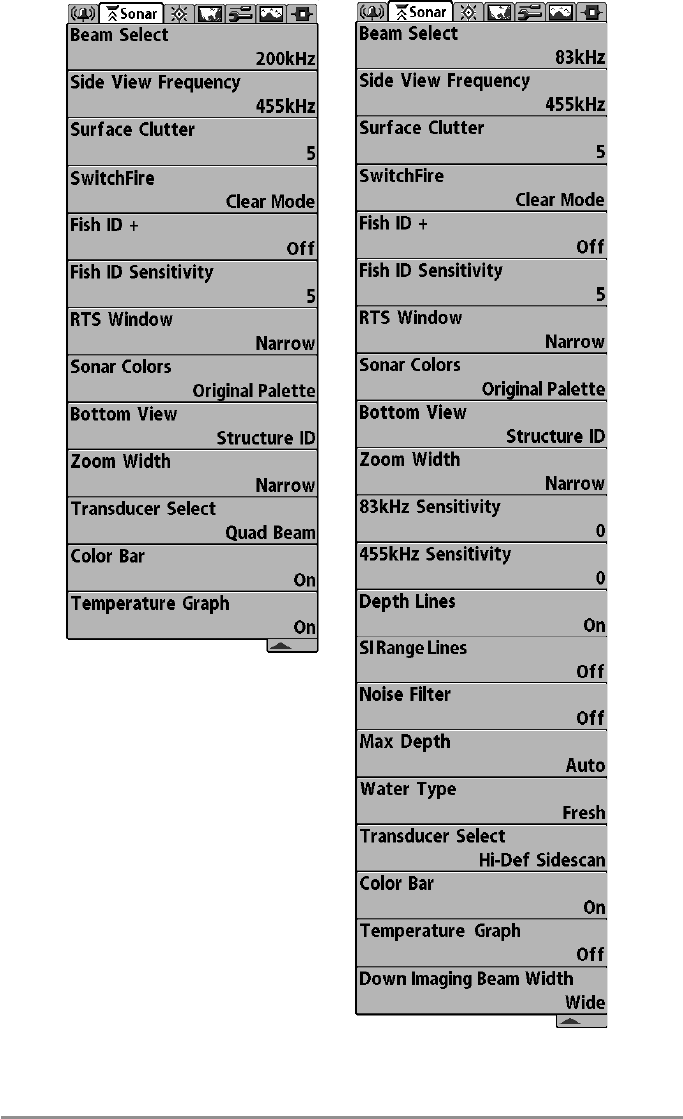
97 Menu Quick Tips
1198c SI
Sonar Tab, Normal Mode
1198c SI
Sonar Tab, Advanced Mode
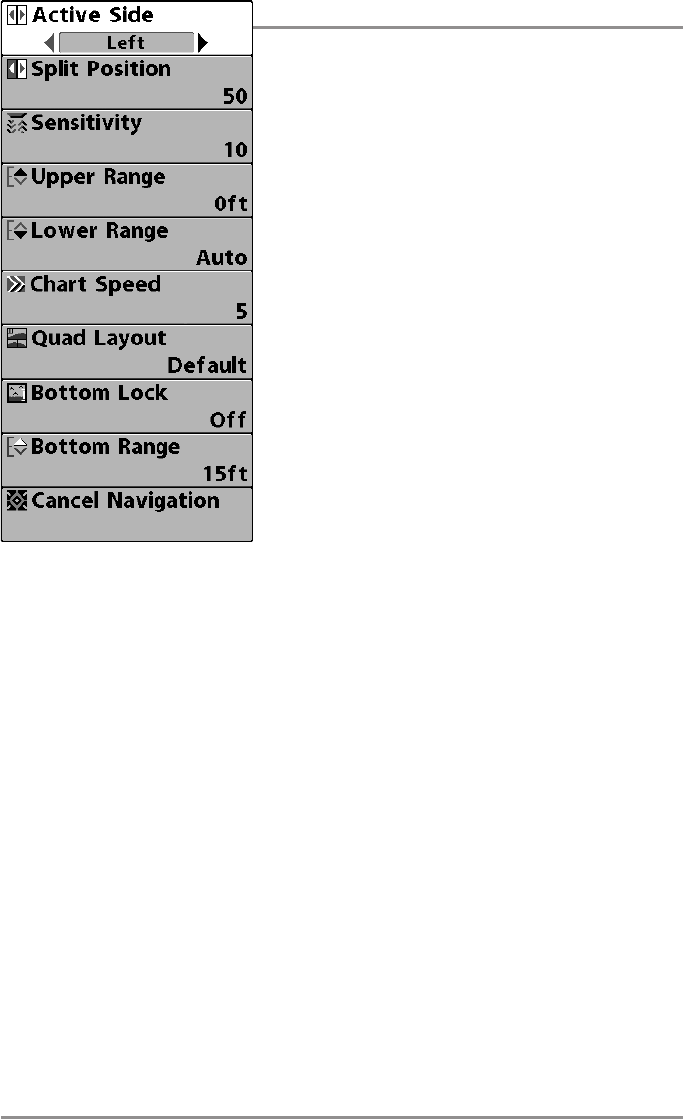
Sonar X-Press™ Menu 98
Sonar X-Press™ Menu
The Sonar X-Press™ Menu provides a shortcut to your
most frequently-used settings. Press the MENU key once
while in any of the Sonar Views to access the Sonar
X-Press™ Menu.
NOTE: Menu options can be expanded or simplified by setting
the User Mode to Advanced or Normal. See Main Menu: User
Mode for details.
NOTE: Quad Layout only appears in Side Beam View when the
optional-purchase QuadraBeam PLUS™ transducer is attached
and selected.
NOTE: Menu options are determined by your Humminbird®
model. See the following pages for full menu descriptions.
Sonar X-Press™ Menu

99 Sonar X-Press™ Menu
Active Side
(Combo Views only)
Settings: Left, Right; Default = Left
Active Side allows you to select a side of the screen in Combo View. After you choose an active
side, you can apply menu settings and key commands to the view you’ve selected. The Active
Side menu option is only available when a Combo View is on the screen (see Views: Combo
Views).
• A green arrow on the Combo View points to the active side.
• When a menu is displayed in the active side, the non-active side of the screen will be
grayed out.
Split Position
(Combo Views only)
Settings: Left, 30, 40, 50, 60, 70, Right; Default = Various
Split Position sets the size of the left side of the Combo View. Each Combo View can be set
individually. The Split Position menu option is only available when a Combo View is on the
screen (see Views: Combo Views).
• The number setting indicates the percentage taken up by the left side of the Combo
View.
• Selecting Left sets the left side of the screen to its smallest setting.

Sonar X-Press™ Menu 100
Sensitivity
Settings: Low = 1, High = 20; Default = 10
Sensitivity controls how much detail is shown on the display and will adjust the sensitivity of
all sonar frequencies.
Decrease the sensitivity to eliminate the clutter from the
display that is sometimes present in murky or muddy water.
If Sensitivity is adjusted too low, the display may not show
many sonar returns that could be fish.
When operating in very clear water or greater depths,
increase the sensitivity to see weaker returns that may be of
interest. If the sensitivity is adjusted too high, the display
may become too cluttered.
NOTE: The Sensitivity setting is a global setting and will adjust
the sensitivity of all sonar frequencies.
.
Sensitivity at Low
Sensitivity at Medium
Sensitivity at High

101 Sonar X-Press™ Menu
Upper Range
(Advanced: Sonar, Split Sonar, and Active Sonar Side Views only)
Settings: 0 to 1490 feet or 0 to 497 meters [International models only];
Default = 0
Upper Range sets the shallowest depth range that will be displayed on the Sonar, Split Sonar,
and Active Sonar Side Views. Upper Range is often used with Lower Range.
NOTE: A minimum distance of 10 feet will be maintained between the Upper and Lower Range
regardless of the manual settings entered.
Lower Range
Settings: Auto, 10 to 1500 feet, 3 to 500 meters [International Models
only]; Default = Auto
Lower Range sets the deepest depth range that will be displayed by the unit.
Auto: The Lower Range will be adjusted by the unit to follow the bottom automatically. Auto is
the default setting.
Manual: You can adjust the Lower Range to lock the unit on a particular depth. will be
displayed in the lower right corner of the screen to indicate the unit is in Manual mode. Adjust
the Upper and Lower Range together to view a specific depth range, especially when looking
for fish or bottom structure.
NOTE: A minimum distance of 10 feet will be maintained between the Upper and Lower Range
regardless of the settings entered manually.
Chart Speed
Settings: 1-10, where 1 = Slow, 10 = Fastest; Default = 5
Chart Speed determines the speed at which the sonar information moves across the display,
and consequently the amount of detail shown.
A faster speed shows more information and is preferred by most anglers; however, the sonar
information moves across the display quickly. A slower speed keeps the information on the
display longer, but the bottom and fish details become compressed and may be difficult to
interpret. Regardless of the Chart Speed setting, the RTS Window™ will update at the maximum
rate possible for the depth conditions.
For example, if you are fishing in 60 feet of water but are only interested in the first 30 feet
(surface to a depth of 30 feet) you should set the Lower Depth Range limit to 30. The display
will show the 0 to 30 foot range, which allows you to see a more detailed view than you would
see if the display went all the way to the bottom.
M
For example, if you are only interested in the area between 20 and 50 feet deep, you should
set the Upper Depth Range to 20 and the Lower Depth Range to 50. The Sonar View will then
show the 30 foot area between 20 and 50, and will not show the surface or the bottom
(assuming the bottom is deeper than 50 feet), and will show greater detail for that area
between 20 and 50 feet.
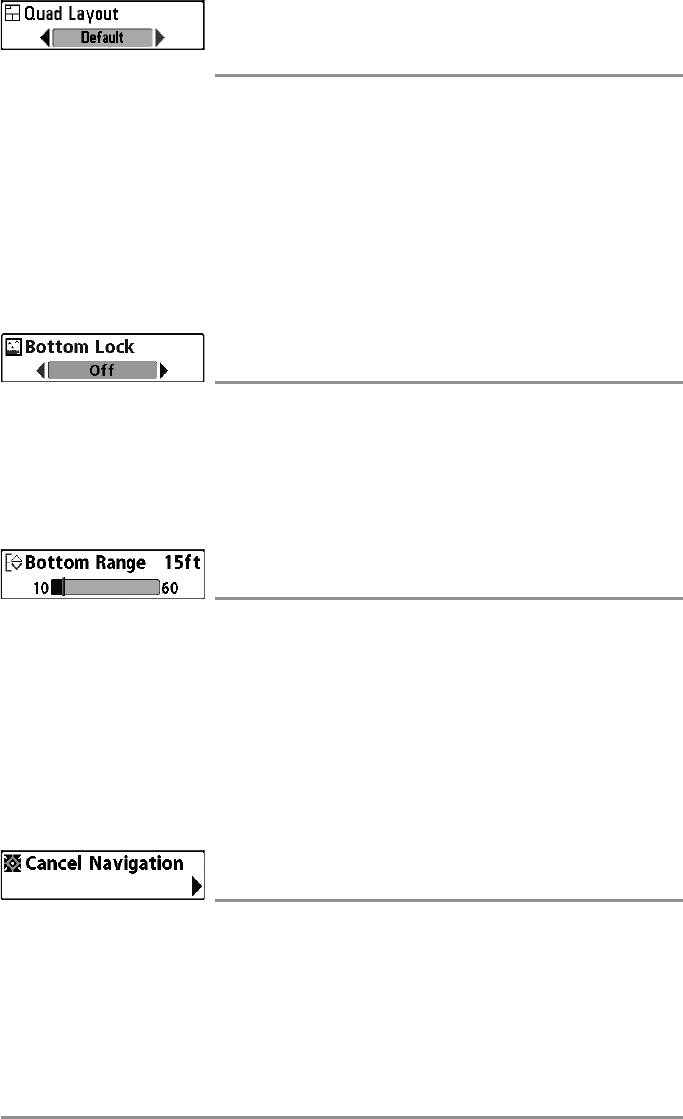
Sonar X-Press™ Menu 102
Quad Layout
(with optional-purchase QuadraBeam PLUS™ Transducer,
Side Beam View only)
Settings: Default, Classic, Slanted; Default = Default
Quad Layout allows you to choose how sonar information is displayed in the Side Beam View.
The Side Beam View displays sonar data from the left and right 455 kHz beams, as well as the
200 kHz down-looking beam. The sonar data can be displayed in any of the following layouts by
changing the Quad Layout setting: Default, Classic, and Slanted. See Views: Side Beam View
for more information.
NOTE: Quad Layout is only available when an optional-purchase QuadraBeam PLUS™ transducer is
attached and the Side Beam View is active (see Sonar Menu Tab: Transducer Select).
Bottom Lock
(Sonar Zoom View only)
Settings: Off, On; Default = Off
Bottom Lock changes the mode of the zoomed view in the Sonar Zoom View. Bottom Lock
continuously graphs the bottom at a constant point on the display regardless of changes in
depth. This “flattens“ out the bottom contour but is effective at showing fish on or near the
bottom.
Bottom Range
(Sonar Zoom View only, when Bottom Lock is On)
Settings: 10 - 60 feet, 2-10 fathoms, or 3-20 meters [International
Models only]; Default = 15 feet
Bottom Range allows you to control how much of the water column, measured up from the
bottom, is shown in the Sonar Zoom View. Choose a small value to see low-lying bottom
structure or details of the bottom return. Choose a larger value to see large structure in deeper
water.
NOTE: It is possible to set the Bottom Range to be greater than the depth. In this case, you may see
surface clutter in a wavy band that mirrors changes in the depth.
Cancel Navigation
(only when Navigating)
Settings: Press the RIGHT Cursor key and follow screen instructions.
Cancel Navigation discards the current route and exits Navigation Mode. This menu option will
only appear when you are currently navigating a route. This will not delete a previously-saved
route.

103 Side Imaging® X-Press™ Menu
Side Imaging® X-Press™ Menu
(Side Imaging®Views only [1198c SI])
The Side Imaging® X-Press™ Menu provides a shortcut to
your most frequently-used settings. Press the MENU key
once while in any of the Side Imaging® Views to access the
Side Imaging® X-Press™ Menu.
NOTE: Menu options can be expanded or simplified by setting
the User Mode to Advanced or Normal. See Main Menu: User
Mode for details.
Side Imaging® X-Press™ Menu

Side Imaging® X-Press™ Menu 104
Active Side
(Combo Views only)
Settings: Left, Right; Default = Left
Active Side allows you to select a side of the screen in Combo View. After you choose an active
side, you can apply menu settings and key commands to the view you’ve selected. The Active
Side menu option is only available when a Combo View is on the screen (see Views: Combo
Views).
• A green arrow on the Combo View points to the active side.
• When a menu is displayed in the active side, the non-active side of the screen will be
grayed out.
Split Position
(Combo Views only)
Settings: Left, 30, 40, 50, 60, 70, Right; Default = Various
Split Position sets the size of the left side of the Combo View. Each Combo View can be set
individually. The Split Position menu option is only available when a Combo View is on the
screen (see Views: Combo Views).
• The number setting indicates the percentage taken up by the left side of the Combo
View.
• Selecting Left sets the left side of the screen to its smallest setting.
SI Side
Settings: Left, Both, Right; Default = Both
SI Side sets which transducer beam from the Side Imaging® beams will be shown on the
display.
SI Sensitivity
Settings: Auto, 1 to 20, where Low = 1, High = 20; Default = 10
SI Sensitivity controls how much detail is shown on the display.
Increase the SI Sensitivity to reveal weaker returns that may be of interest, especially in very
clear water or greater depths. A high SI Sensitivity setting shows more sonar returns from small
baitfish and suspended debris in the water; however if the SI Sensitivity is adjusted too high,
the display may become too cluttered.
Decrease the SI Sensitivity to eliminate the clutter from the display that is sometimes present
in murky or muddy water. If SI Sensitivity is adjusted too low, the display may not show many
sonar returns that could be fish.
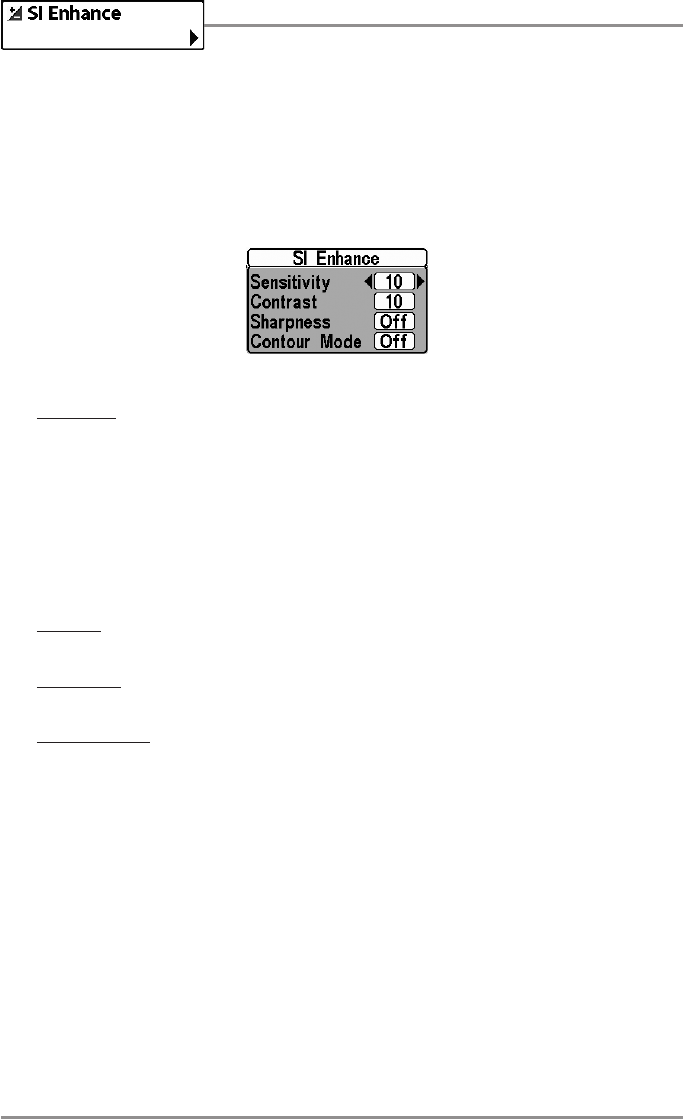
105 Side Imaging® X-Press™ Menu
SI Enhance
Settings: Press the RIGHT Cursor key.
SI Enhance allows you to adjust your Side Imaging® View in four categories: Sensitivity,
Contrast, Sharpness, and Contour Mode.
Whether you’re searching the Side Imaging® data for fish or certain bottom contour, the most
effective settings will vary with the situation. The display will update as you adjust each
category. SI Enhance can also be used during Recording Playback (see Snapshot and
Recording View).
•Sensitivity - Controls how much detail is shown on the display. When operating in very
clear water or greater depths, increased sensitivity shows weaker returns that may be
of interest. Decreasing the sensitivity eliminates the clutter from the display that
is sometimes present in murky or muddy water. (1 to 20, where Low = 1, High = 20,
Default = 10)
NOTE: The Sensitivity can be adjusted from the SI Enhance dialog box or the Side Imaging® X-Press™
Menu. The Sensitivity setting is provided here so that you can easily adjust the Side Imaging® data with
the other settings. See Side Imaging®X-Press™ Menu: SI Sensitivity for more information.
•Contrast:Accents the light and dark parts of the Side Imaging® data to provide greater
definition. (1-20, Default = 10)
•Sharpness: Filters the view and sharpens the edges of the Side Imaging® data. (Low (L),
Medium (M), High (H), Default = Off)
•Contour Mode: Controls how the water column is displayed in the Side Imaging® Views.
In the normal display with the Contour Mode off, the water column is displayed on the
view. The location of a target on the display is based on the slant range to the target.
When Contour Mode is turned on, the bottom is graphed at a constant point on the
display, regardless of changes in depth. The Side Imaging® beams are divided by a
vertical line. The water column is removed from the view, which allows the display to
show targets at their linear horizontal distance. The location of a target may be easier to
interpret when the water column is removed. (Off, On; Default = Off)
NOTE: If both SI Range Lines and Contour Mode are turned on, the SI Range Lines will remain
on the display, but the individual range numbers are not available (see Sonar Menu Tab: SI
Range Lines).
SI Enhance Submenu
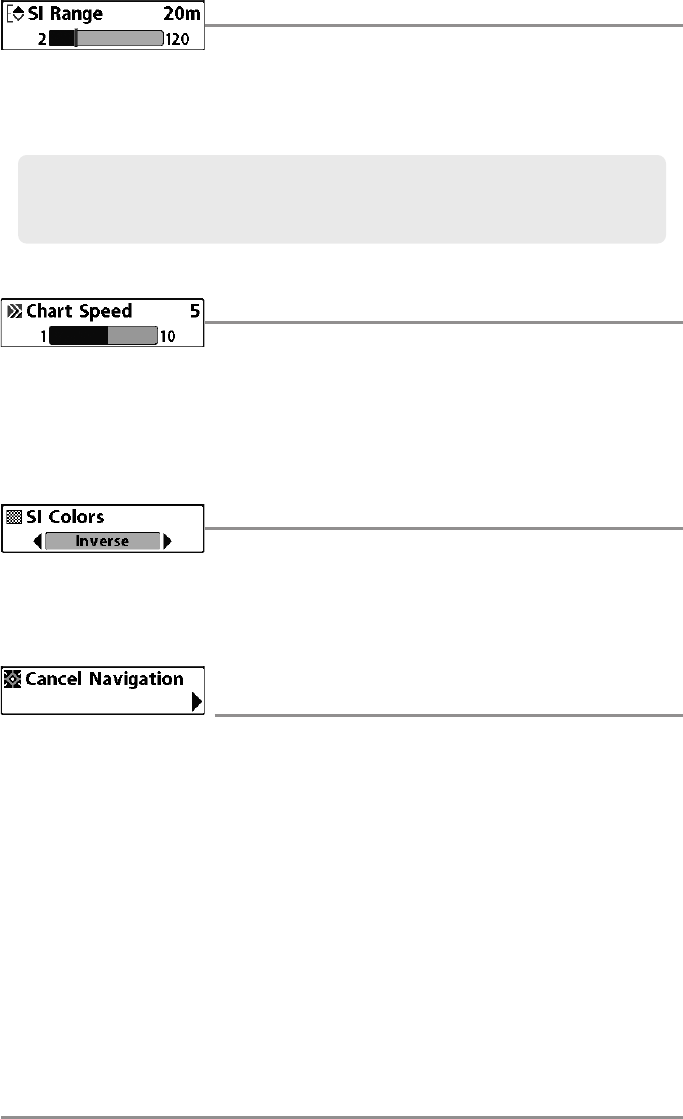
Side Imaging® X-Press™ Menu 106
SI Range
Settings: 6 to 360 feet, or 2 to 120 meters [International Models only];
Default = 150 feet, 50 meters
SI Range sets the deepest range that will be displayed in the Side Imaging® views. The range
must be set manually.
Chart Speed
Settings: 1- 10, where 1 = Slow, 10 Fastest, Default = 5
Chart Speed determines the speed at which the side sonar information moves down the display,
and consequently the amount of detail shown. A faster speed shows more information in the
Side Imaging® Views and is preferred by most anglers; however, the sonar information moves
across the display quickly. A slower speed keeps the information on the display longer, which
allows you to see an entire area.
SI Colors
Settings: Blue, Amber 1, Amber 2, Brown, Green, Inverse, Gray,
Green/Red, Default = Blue
SI Colors allows you to select which color palette you would like to use for the Side Imaging®
display.
Cancel Navigation
(only when Navigating)
Settings: Press the RIGHT Cursor key and follow screen instructions.
Cancel Navigation discards the current route and exits Navigation Mode. This menu option will
only appear when you are currently navigating a route. This will not delete a previously-saved
route.
Choose a low range number to focus on a shorter distance of the water column and see greater
detail on the screen. Choose a higher range number to view farther into the water and see an
overview of details on the screen.
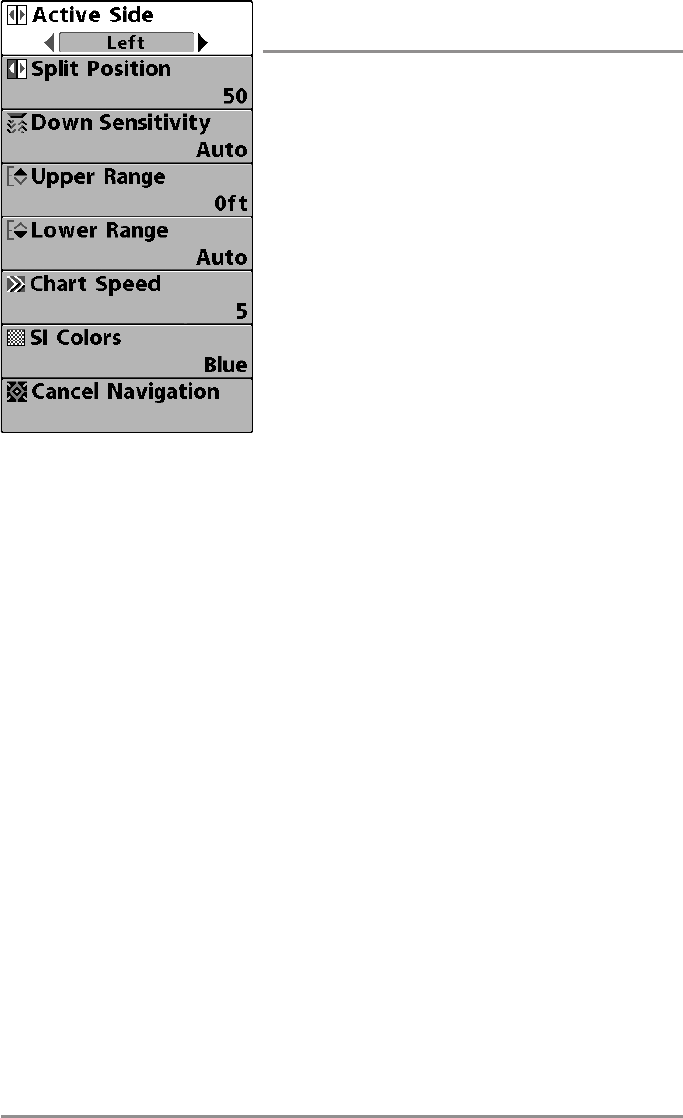
107 Down Imaging™ X-Press™ Menu
Down Imaging™ X-Press™ Menu
(Down Imaging™Views only [1158c DI and 1198c SI])
The Down Imaging™ X-Press™ Menu provides a shortcut
to your most frequently-used settings. Press the MENU key
once while in any of the Down Imaging™ Views to access
the Down Imaging™ X-Press™ Menu.
NOTE: Menu options can be expanded or simplified by setting
the User Mode to Advanced or Normal. See Main Menu: User
Mode for details.
NOTE: Menu options are determined by your Humminbird®
model. See the following pages for full menu descriptions.
1198c SI
Down Imaging™ X-Press™ Menu
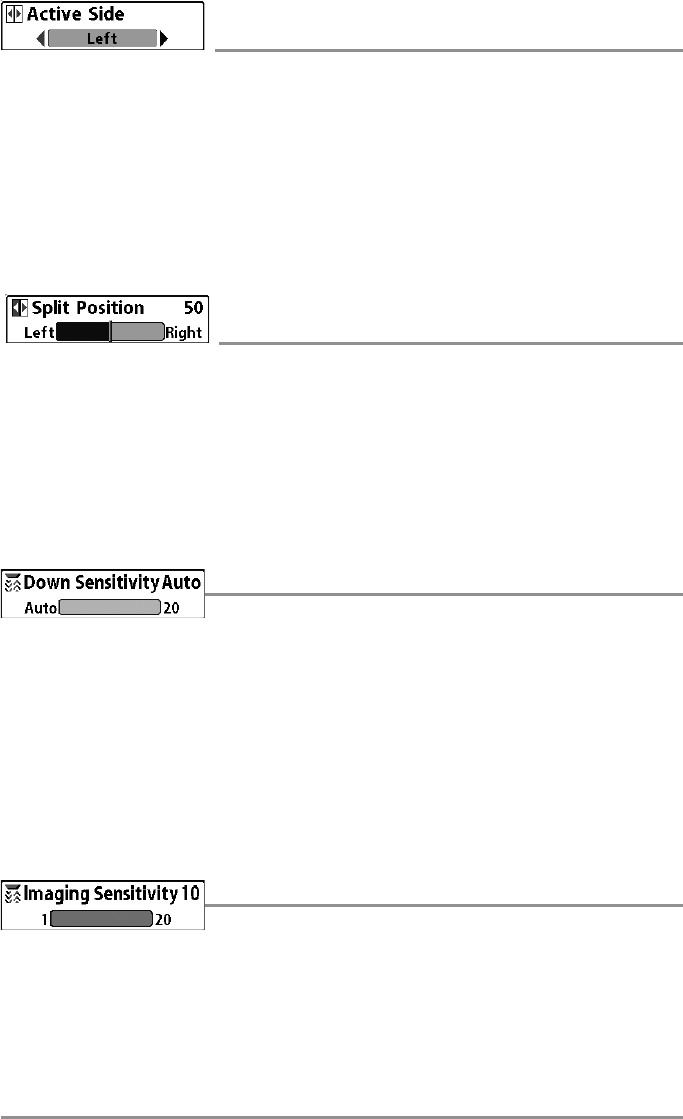
Down Imaging™ X-Press™ Menu 108
Active Side
(Combo Views only)
Settings: Left, Right; Default = Left
Active Side allows you to select a side of the screen in Combo View. After you choose an active
side, you can apply menu settings and key commands to the view you’ve selected. The Active
Side menu option is only available when a Combo View is on the screen (see Views: Combo
Views).
• A green arrow on the Combo View points to the active side.
• When a menu is displayed in the active side, the non-active side of the screen will be
grayed out.
Split Position
(Combo Views only)
Settings: Left, 30, 40, 50, 60, 70, Right; Default = Various
Split Position sets the size of the left side of the Combo View. Each Combo View can be set
individually. The Split Position menu option is only available when a Combo View is on the
screen (see Views: Combo Views).
• The number setting indicates the percentage taken up by the left side of the Combo
View.
• Selecting Left sets the left side of the screen to its smallest setting.
Down Sensitivity
(1198c SI only)
Settings: Auto, 1 to 20, where Low = 1, High = 20; Default = 10
Down Sensitivity controls how much detail is shown on the display.
Increase the Down Sensitivity to reveal weaker returns that may be of interest, especially in
very clear water or greater depths. A high Down Imaging™ Sensitivity setting shows more sonar
returns from small baitfish and suspended debris in the water; however if the Down Imaging™
Sensitivity is adjusted too high, the display may become too cluttered.
Decrease the Down Sensitivity to eliminate the clutter from the display that is sometimes
present in murky or muddy water. If Down Imaging™ Sensitivity is adjusted too low, the display
may not show many sonar returns that could be fish.
Imaging Sensitivity
(1158c DI only)
Settings: Auto, 1 to 20, where Low = 1, High = 20; Default = 10
Imaging Sensitivity controls how the sonar returns are displayed on the Down Imaging™
Views.
Increase the Imaging Sensitivity to reveal weaker returns that may be of interest, especially in
very clear water or greater depths. A high imaging sensitivity setting shows more sonar returns
from small baitfish and suspended debris in the water; however if the sensitivity is adjusted too
high, the display may become too cluttered.
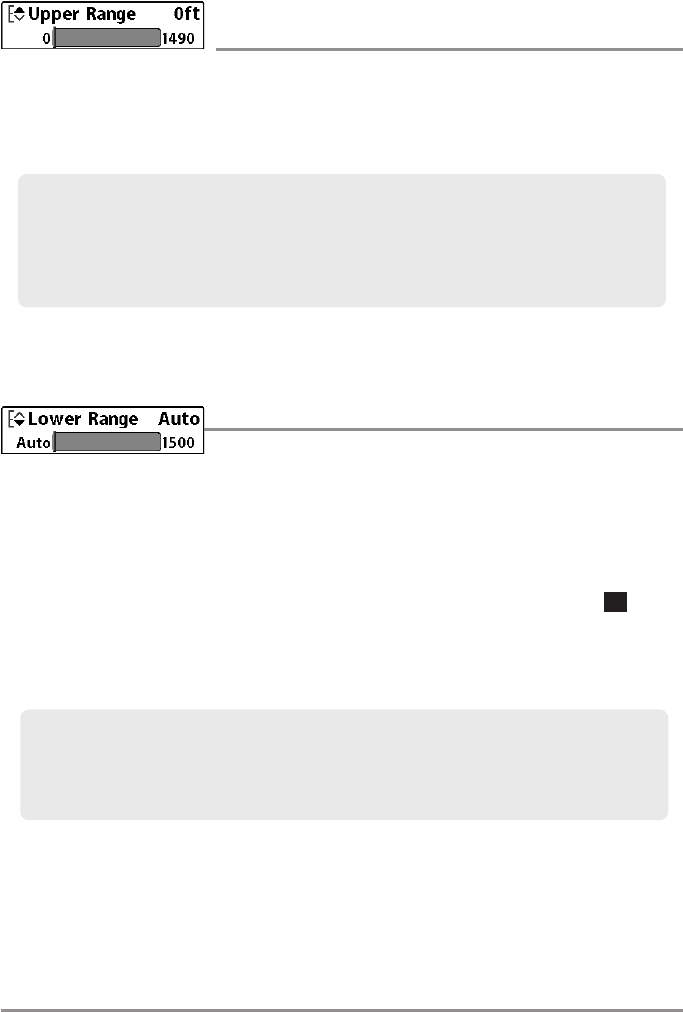
109 Down Imaging™ X-Press™ Menu
Decrease the Imaging Sensitivity to eliminate the clutter from the display that is sometimes
present in murky or muddy water. If the sensitivity is adjusted too low, the display may not show
many sonar returns that could be fish.
Upper Range
(Advanced: Down Imaging™Views only)
Settings: 0 to 1490 feet or 0 to 497 meters [International models only],
Default = 0 ft
Upper Range sets the shallowest depth range that will be displayed on the Down Imaging™
Views. Upper Range is often used with Lower Range.
NOTE: A minimum distance of 10 feet will be maintained between the Upper and Lower Range
regardless of the manual settings entered.
Lower Range
Settings: Auto, 10 to 1500 feet, 3 to 500 meters [International Models
only]; Default = Auto
Lower Range sets the deepest depth range that will be displayed by the unit.
Auto: The Lower Range will be adjusted by the unit to follow the bottom automatically. Auto is
the default setting.
Manual: You can adjust the Lower Range to lock the unit on a particular depth. will be
displayed in the lower right corner of the screen to indicate the unit is in Manual mode. Adjust
the Upper and Lower Range together to view a specific depth range, especially when looking
for fish or bottom structure.
NOTE: A minimum distance of 10 feet will be maintained between the Upper and Lower Range
regardless of the settings entered manually.
For example, if you are fishing in 60 feet of water but are only interested in the first 30 feet
(surface to a depth of 30 feet) you should set the Lower Depth Range limit to 30. The display
will show the 0 to 30 foot range, which allows you to see a more detailed view than you would
see if the display went all the way to the bottom.
For example, if you are only interested in the area between 20 and 50 feet deep, you should
set the Upper Depth Range to 20 and the Lower Depth Range to 50. The Down Imaging™ View
will then show the 30 foot area between 20 and 50, and will not show the surface or the
bottom (assuming the bottom is deeper than 50 feet), and will show greater detail for that area
between 20 and 50 feet.
M

Down Imaging™ X-Press™ Menu 110
Chart Speed
Settings: 1-10, where 1 = Slow, 10 = Fastest; Default = 5
Chart Speed determines the speed at which the sonar information moves across the display,
and consequently the amount of detail shown.
A faster speed shows more information and is preferred by most anglers; however, the sonar
information moves across the display quickly. A slower speed keeps the information on the
display longer, but the bottom and fish details become compressed and may be difficult to
interpret.
SI Colors
(1198c SI only)
Settings: Blue, Amber 1, Amber 2, Brown, Green, Inverse, Gray,
Green/Red; Default = Blue
SI Colors allows you to select which color palette you would like to use for the Side Imaging®
and Down Imaging™ display.
Imaging Colors (1158c DI only)
Settings: Blue, Amber 1, Amber 2, Brown, Green, Inverse, Gray,
Green/Red; Default = Blue
Imaging Colors allows you to select which color palette you would like to use for the Down
Imaging™ display.
Cancel Navigation
(only when Navigating)
Settings: Press the RIGHT Cursor key and follow screen instructions.
Cancel Navigation discards the current route and exits Navigation Mode. This menu option will
only appear when you are currently navigating a route. This will not delete a previously-saved
route.

111 Navigation X-Press™ Menu
Navigation X-Press™ Menu
The Navigation X-Press™ Menu provides a shortcut to
your most frequently-used settings. Press the MENU key
once while in the Bird's Eye View, Chart Views, or Chart
Combo Views to access the Navigation X-Press™ Menu.
NOTE: Menu choices will vary depending on system settings,
such as whether you are currently navigating.
NOTE: To see the Navigation X-Press™Menu in a Combo View,
change the Active Side setting to the side you want to adjust.
Navigation X-Press™ Menu

Navigation X-Press™ Menu 112
Active Side
(Combo Views only)
Settings: Left, Right, Default = Left
Active Side allows you to select a side of the screen in Combo View. After you choose an active
side, you can apply menu settings and key commands to the view you’ve selected. The Active
Side menu option is only available when a Combo View is on the screen (see Views: Combo
Views).
• A green arrow on the Combo View points to the active side.
• When a menu is displayed in the active side, the non-active side of the screen will be
grayed out.
Split Position
(Combo Views only)
Settings: Left, 30, 40, 50, 60, 70, Right; Default = Various
Split Position sets the size of the left side of the Combo View. Each Combo View can be set
individually. The Split Position menu option is only available when a Combo View is on the
screen (see Views: Combo Views).
• The number setting indicates the percentage taken up by the left side of the Combo
View.
• Selecting Left sets the left side of the screen to its smallest setting.
Waypoint [Name]
(Only with an active cursor on a waypoint)
Settings: Edit, Delete, Target, Grid
Waypoint [Name] allows you to view the Waypoints submenu for the waypoint under your
cursor. You can move the cursor onto an existing waypoint and press the MENU key once, or use
Cursor to Waypoint to select a waypoint from the saved waypoints list.
NOTE: See Introduction to Navigation for more Waypoints information.
The Waypoint Submenu contains the following menu options:
Edit allows you to edit the Name, Position (Latitude and Longitude), and select the Icon
that will be used to represent the waypoint in the Chart and Combo Views.
Delete allows you to delete a waypoint from the saved waypoints list.
Target allows you to apply a target to a waypoint selected from the saved waypoints list.
Grid allows you to apply a trolling grid to a waypoint selected from the saved waypoints
list.
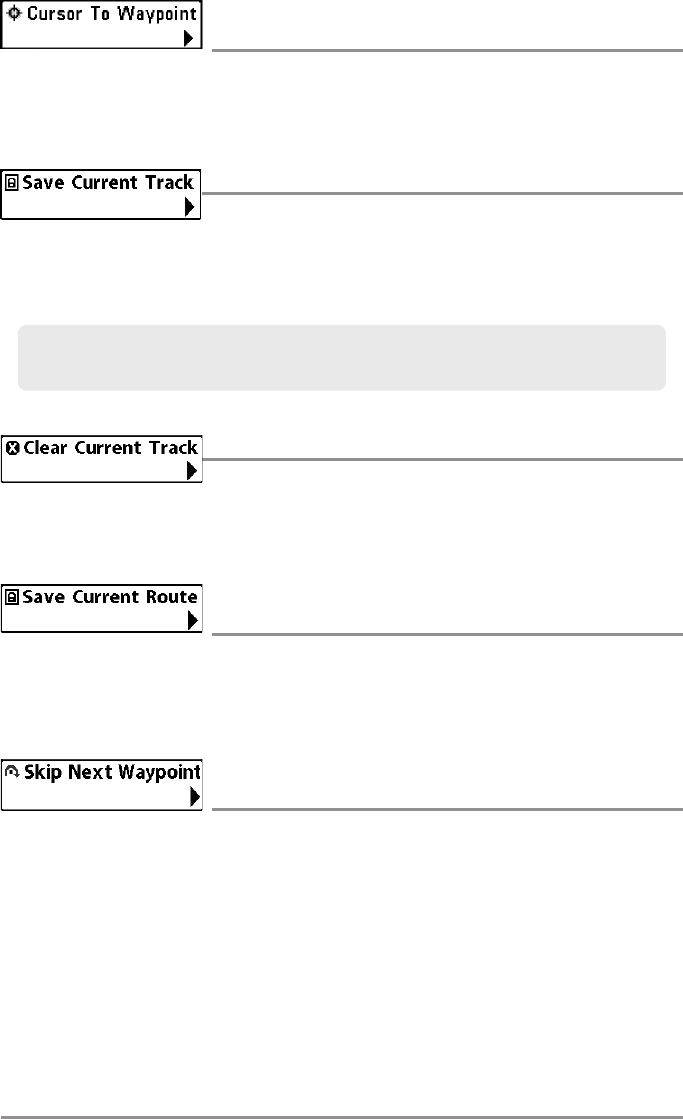
113 Navigation X-Press™ Menu
Cursor to Waypoint
(Chart or Combo View only)
Settings: Press the RIGHT Cursor key and follow screen instructions.
Cursor to Waypoint allows you to quickly move the cursor to any saved waypoint so that you
can locate it or edit it. This X-Press™ Menu option only appears if you have saved waypoints.
Save Current Track
Settings: Press the RIGHT Cursor key and follow screen instructions.
Save Current Track allows you to save the current track on the display. After the current track
is saved, a new current track is started. Save Current Track appears on the Navigation X-Press™
Menu after navigation is stopped.
Clear Current Track
Settings: Press the RIGHT Cursor key and follow screen instructions.
Clear Current Track allows you to clear the current track on the display and start a new track
at the present position.
Save Current Route
(only when Navigating)
Settings: Press the RIGHT Cursor key and follow screen instructions.
Save Current Route allows you to save the current route being displayed. This menu option will
only appear when you are currently navigating a route.
Skip Next Waypoint
(only when Navigating)
Settings: Press the RIGHT Cursor key and follow screen instructions.
Skip Next Waypoint removes the next waypoint from the current route. This menu option will
only appear when you are currently navigating a route.
NOTE: To save the depth information with the current track, it is important to save the track and also
edit the name before powering off the control head.
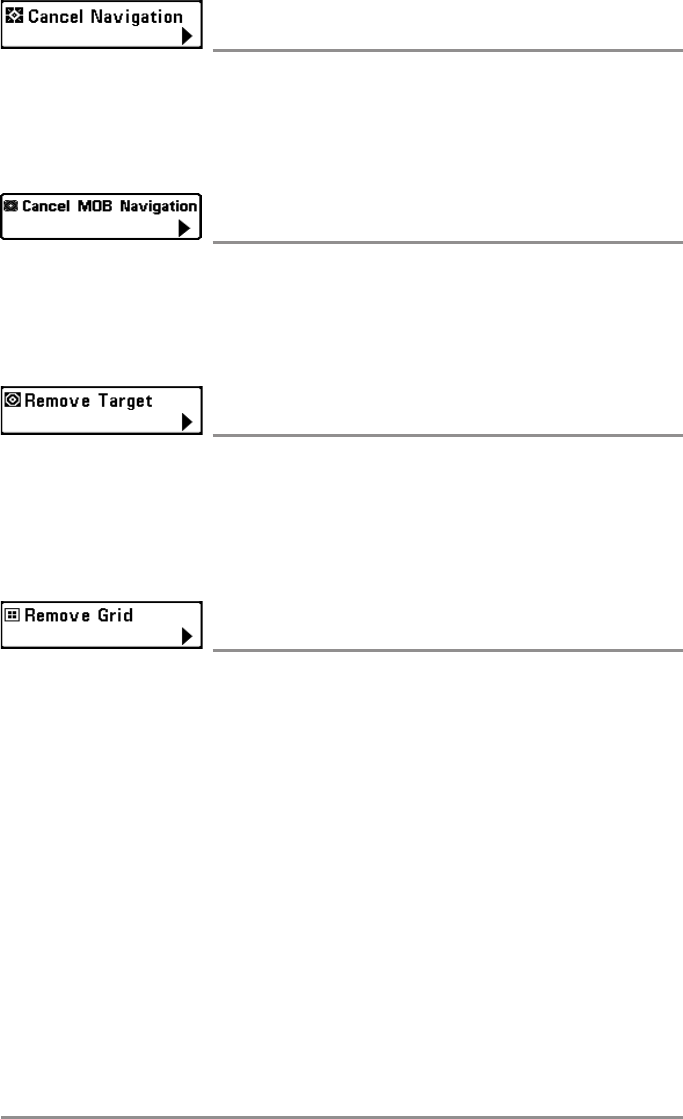
Navigation X-Press™ Menu 114
Cancel Navigation
(only when Navigating)
Settings: Press the RIGHT Cursor key and follow screen instructions.
Cancel Navigation discards the current route and exits Navigation Mode. This menu option will
only appear when you are currently navigating a route. This will not delete a previously-saved
route.
Cancel MOB Navigation
(only when MOB Navigation is activated)
Settings: Press the RIGHT Cursor key and follow screen instructions.
Cancel MOB Navigation removes the Man Overboard (MOB) waypoint and exits Man
Overboard mode. This menu option will only appear when you are currently navigating in Man
Overboard mode.
Remove Target
(only if a Target is Active)
Settings: Press the RIGHT Cursor key to activate.
Remove Target removes the waypoint target from the display. This menu option will only appear
when a target has already been applied to a waypoint.
NOTE: See Introduction to Navigation: Add a Waypoint Target or Trolling Grid for more information.
Remove Grid
(only if a Grid is Active)
Settings: Press the RIGHT Cursor key to activate.
Remove Grid removes the waypoint grid from the display. This menu option will only appear
when a grid has already been applied to a waypoint.
NOTE: See Introduction to Navigation: Add a Waypoint Target or Trolling Grid for more
information.
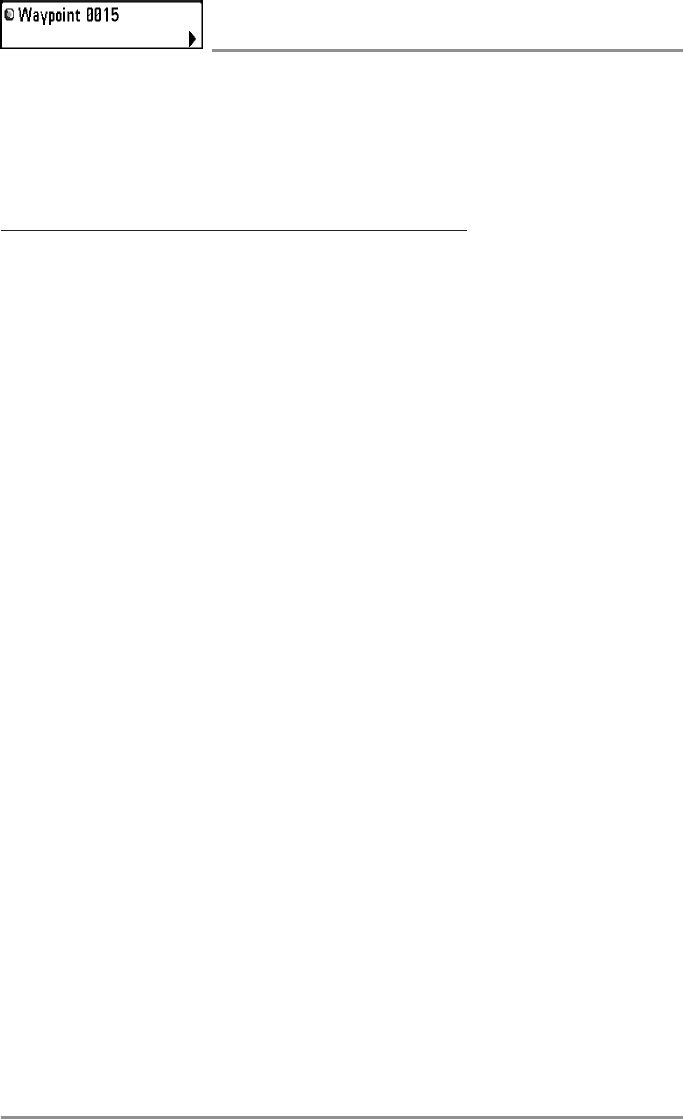
115 Navigation X-Press™ Menu
Waypoint [Name]
(Most recently-created waypoint)
Settings: Edit, Delete, Go To, Target, Grid
Waypoint [Name] allows you to view the waypoints submenu for the most recently created
waypoint. You must have pressed the MARK key at least once since you last powered up the
Fishfinder for this menu option to appear.
NOTE: See Introduction to Navigation for more information.
The Waypoint Submenu contains the following menu options:
Edit allows you to edit the Name, Position (Latitude and Longitude), and select the Icon
that will be used to represent the waypoint in the Chart and Combo Views.
Delete allows you to delete a waypoint from the saved waypoints list.
Go To allows you to select a waypoint and start navigation toward that waypoint, or add
that waypoint to the end of the current route.
Target allows you to apply a target to a waypoint selected from the saved waypoints list.
Grid allows you to apply a trolling grid to a waypoint selected from the saved waypoints
list.

Snapshot & Recording X-Press™ Menu 116
Snapshot and Recording
X-Press™ Menu
(Snapshot and Recording View only)
The Snapshot and Recording X-Press™ Menu provides
access to the snapshot management and sonar recording
functions. Press the MENU key once while in the Snapshot
and Recording View to access the Snapshot and Recording
X-Press™ Menu.
NOTE: For more information, see Views: Snapshot and
Recording View.
Snapshot and Recording
X-Press™ Menu

117 Snapshot & Recording X-Press™ Menu
Start Recording
(optional-purchase SD Card, Snapshot and Recording View only)
Settings: Press the RIGHT Cursor key to activate.
Start Recording allows you to start sonar recording from the Snapshot and Recording View. This
menu option is only available when an optional-purchase SD card is installed and Snapshot and
Recording View is on the screen.
Stop Recording
(optional-purchase SD Card only)
Settings: Press the RIGHT Cursor key to activate.
Stop Recording allows you to stop sonar recording. This menu option is only available when an
optional-purchase SD card is installed and the control head is actively recording.
Delete Image
(optional-purchase SD Card, Snapshot and Recording View only)
Settings: Press the RIGHT Cursor key and follow screen instructions.
Delete Image allows you to delete a single screen capture image. This menu option is only
available when an optional-purchase SD card is installed, Snapshot and Recording View is on
the screen, and you have selected an image thumbnail.
Delete All Images
(optional-purchase SD Card, Snapshot and Recording View only)
Settings: Press the RIGHT Cursor key and follow screen instructions.
Delete All Images allows you to delete all the images at once. This menu option is only available
when an optional-purchase SD card is installed and Snapshot and Recording View is on the
screen.
Delete Recording
(optional-purchase SD Card, Snapshot and Recording View only)
Settings: Press the RIGHT Cursor key and follow screen instructions.
Delete Recording allows you to delete a single sonar recording. This menu option is only
available when an optional-purchase SD card is installed, Snapshot and Recording View is on
the screen, and you have selected a recording file.

Snapshot & Recording X-Press™ Menu 118
Delete All Recordings
(optional-purchase SD Card, Snapshot and Recording View only)
Settings: Press the RIGHT Cursor key and follow screen instructions.
Delete All Recordings allows you to delete all the recordings at once. This menu option is only
available when an optional-purchase SD card is installed and Snapshot and Recording View is
on the screen.
Pings Per Second
(optional-purchase SD Card, Snapshot and Recording View only)
Settings: 1-10, AUTO, Default = AUTO
Pings Per Second allows you to specify the ping rate for an active sonar recording.
NOTE: Pings Per Second is available when an optional-purchase SD card is installed, Snapshot and
Recording View is on the screen, and the control head is actively recording (not playing back).
Auto is the default setting for Pings Per Second and automatically adjusts the ping rate for best
recording quality. If there is limited memory on your SD card, you can slow the ping rate by
setting the Pings Per Second manually, but the recording will capture less sonar detail. For
maximum performance, keep the Pings Per Second setting on Auto.
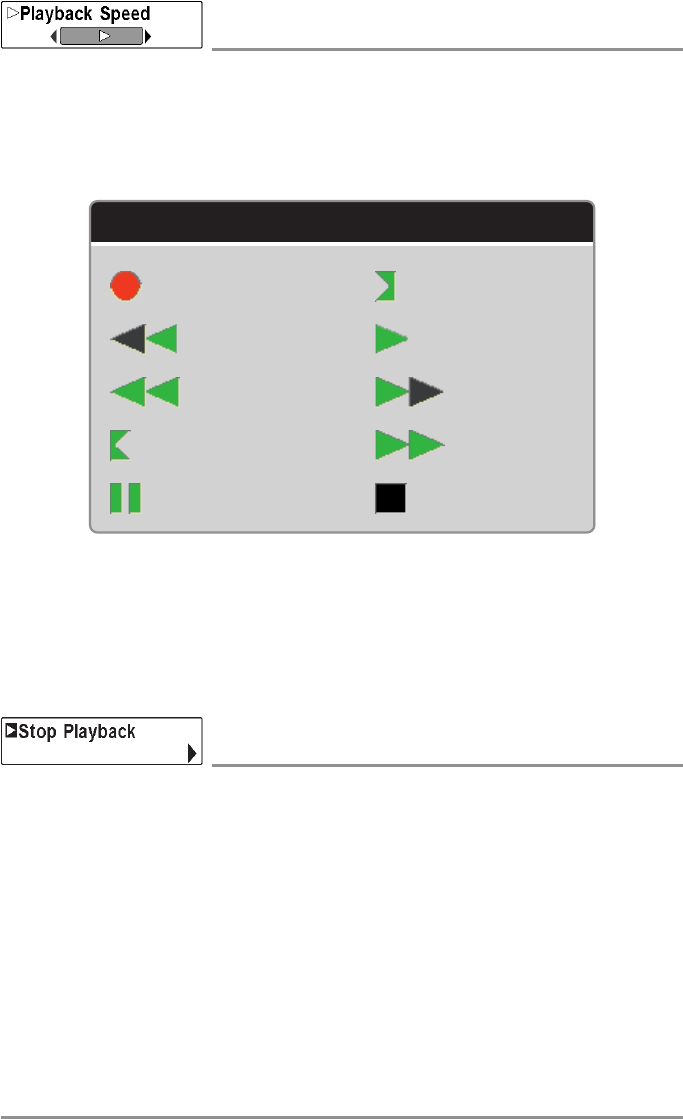
119 Snapshot & Recording X-Press™ Menu
Playback Speed
(optional-purchase SD Card, Snapshot and Recording View only)
Settings: Record, Rewind1, Rewind2, Slow Play Reverse, Pause, Slow
Play, Normal Play, Fast Forward1, Fast Forward2, Stop
Playback Speed allows you to specify the playback speed for a sonar recording from the
Snapshot and Recording View. This menu option is only available when an optional-purchase
SD card is installed and Recording Playback is active.
NOTE: You can also change playback speed in the Snapshot and Recording View using the LEFT and RIGHT
Cursor keys, although you cannot skip to the beginning or end of a recording using these keys.
NOTE: Sonar chart speed is increased during Fast Forward and reversed during Rewind. This may result in
a reduced quality sonar image, since at higher speeds, not every sonar return can be processed.
Stop Playback
(optional-purchase SD Card only)
Settings: Press the RIGHT Cursor key to activate.
Stop Playback allows you to stop playback of a sonar recording from any view. This menu option
is only available when an optional-purchase SD card is installed and Recording Playback is
active.
NOTE: During playback, the amount of time/memory left to play is indicated by the status bar. For more
information, see Views: Snapshot and Recording View.
Playback Speed Icons:
Record Slow Play
Rewind, Reverse Normal Play
Rewind2 Fast Forward
Slow Play Reverse Fast Forward2
Pause Stop

Alarms Menu Tab 120
Alarms Menu Tab
From any view, press the MENU key twice to access the
Main Menu System. The Alarms tab will be the default
selection.
NOTE: When an alarm is triggered, you can silence it by pressing
any key. The alarm will be silenced, and will not be triggered again
until a new instance of the alarm condition is detected.
Alarms Menu
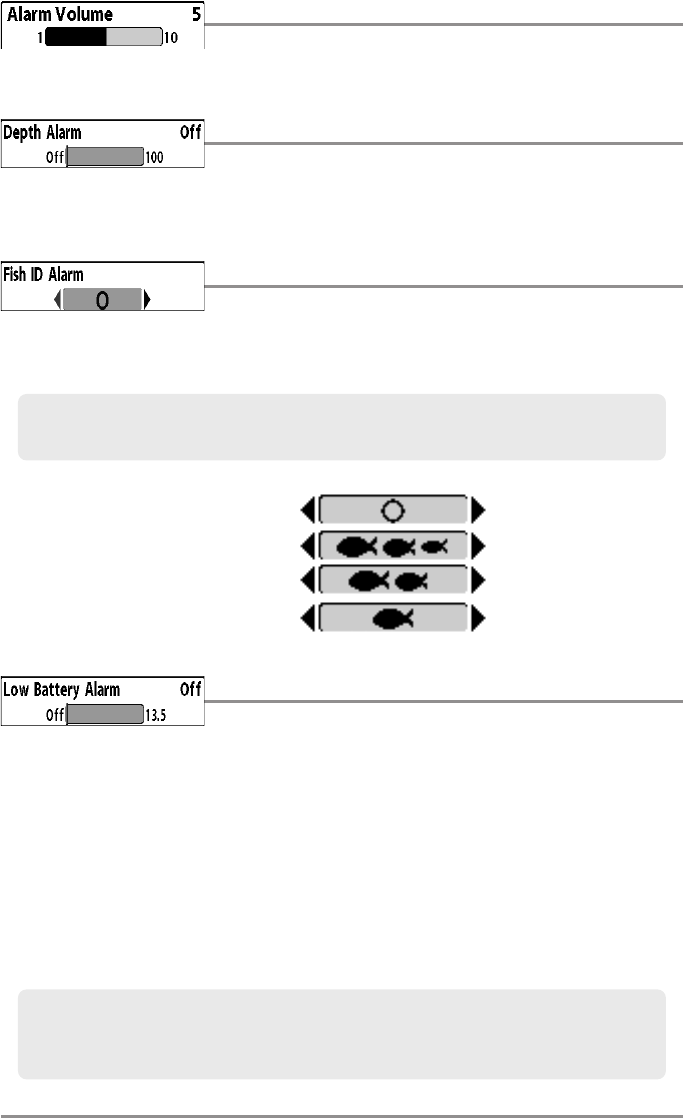
121 Alarms Menu Tab
Alarm Volume
Settings: Mute, 1 - 10; Default = 5
Alarm Volume allows you to adjust the volume of the alarms.
Depth Alarm
Settings: Off, 1 to 100 feet, or 0.5 to 30 meters [International Models
only]; Default = Off
Depth Alarm sounds when the depth becomes equal to or less than the menu setting.
Fish ID Alarm
Settings: Off, All, Large/Medium, Large; Default = Off
Fish ID Alarm sounds when the Fishfinder detects fish that correspond to the alarm setting.
Fish ID Alarm will only sound if Fish ID+™ is on.
Low Battery Alarm
Settings: Off, 8.5V - 13.5V; Default = Off
Low Battery Alarm sounds when the input battery voltage is equal to or less than the menu
setting. The battery alarm will only sound for the battery that is connected to the Fishfinder. The
Low Battery Alarm should be set to warn you when the battery voltage drops below the safety
margin that you have determined.
The Fishing System will detect when the connected battery voltage is too low or too high, and
it will display Input Voltage Low or Input Voltage High messages if these limits are exceeded. If
you turn on the Low Battery Alarm using the Alarms Main Menu, the unit will use your settings.
If you do not turn on the Low Battery Alarm, the unit will use the following limits: 7.5 to 7.9 VDC
(low) and 21 to 21.2 VDC (high).
For example, if you are running a trolling motor (battery operated), you would want to set the
Low Battery Alarm to sound before the battery voltage drops too low for it to be used to start
your main, gasoline-powered engine.
For example, if you've set the Fish ID Alarm to sound for Large fish only, the Fish ID alarm will
sound when a large-sized fish is detected.
Off
All
Large/Medium
Large

Alarms Menu Tab 122
Aux. Temp Alarm
(with optional-purchase Temp. probe or Temp/Speed only)
Settings: Off, 33-120 [Fahrenheit], 0-50 [Celsius], Default = Off
Aux Temp Alarm sounds when the water temperature from the Paddlewheel/Temperature Probe
detected by the Fishing System reaches the Aux Temp Alarm setting, which is set in degrees
Fahrenheit or Celsius [International Models only].
Temp. Alarm
Settings: Off, 33-120 Fahrenheit, 0-50 Celsius [International Models
only]; Default = Off
Temp. Alarm sounds when the water temperature detected by the Fishfinder reaches the Temp.
Alarm setting, which is either set in degrees Fahrenheit or Celsius [International Models only].
Off Course Alarm
Settings: Off, 25 to 3000 feet, 10 to 1000 meters [International Models
only]; Default = 300 feet, 100 meters
Off Course Alarm allows you to set how far the boat is allowed to move off course before the
Off Course Alarm will sound during navigation.
Off Course Alarm
Arrival Alarm Circle
1
Off Course Limits
2
1
2
For example, if the Aux Temp Alarm is set to 58 degrees Fahrenheit, and the water temperature
falls from 60 degrees to 58 degrees, the Aux Temp Alarm will sound. Similarly, if the water
temperature rises from 56 degrees to 58 degrees, the Temp Alarm will also sound.
For example, if the Temp. Alarm is set to 58 degrees Fahrenheit, and the water temperature falls
from 60 degrees to 58 degrees, the Temp. Alarm will sound. Similarly, if the water temperature
rises from 56 degrees to 58 degrees, the Temp. Alarm will also sound.
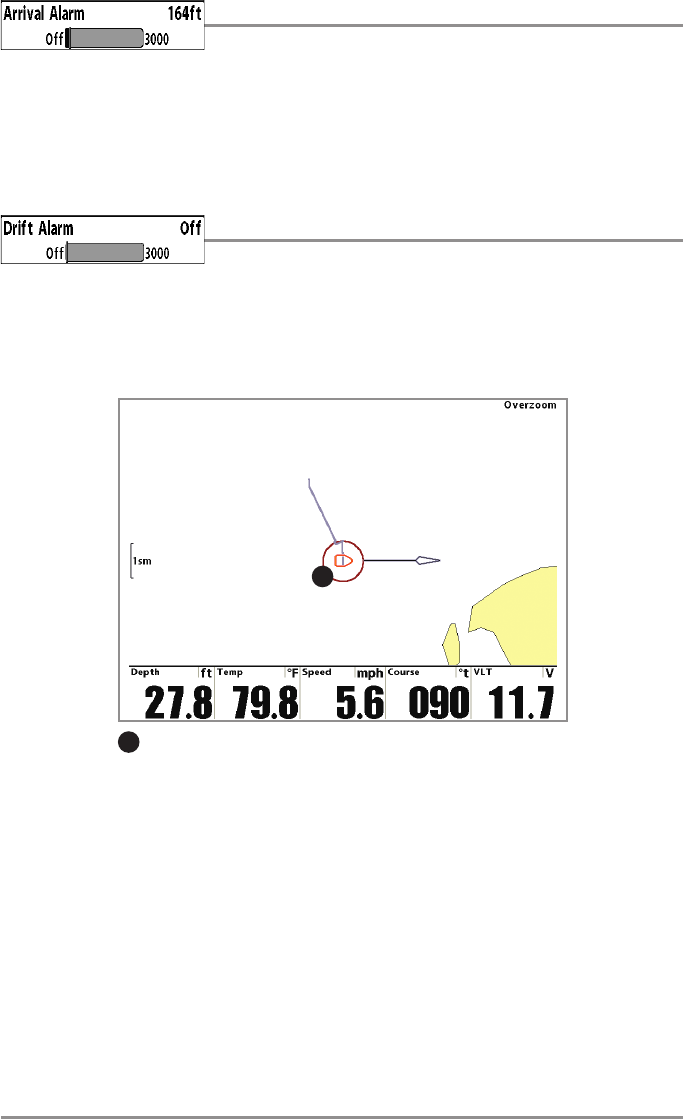
123 Alarms Menu Tab
Arrival Alarm
Settings: Off, 25 to 3000 feet, 10 to 1000 meters [International Models
only]; Default = 150 feet, 50 meters
Arrival Alarm sounds when the boat has either exceeded the distance to the destination
waypoint, or has entered the Arrival Alarm Circle, based on the menu setting when navigating.
Arrival Alarm allows you to set how close the boat must be to the destination waypoint before
the Arrival Alarm will sound.
Drift Alarm
Settings; Off, 25 to 3000 feet, 10 to 1000 meters [International Models
only]; Default = Off
Drift Alarm allows you to set the size of a perimeter around the boat’s anchored position. If the
anchored boat drifts outside of that perimeter, the Drift Alarm will sound.
Drift Alarm
Drift Alarm Circle
1
1
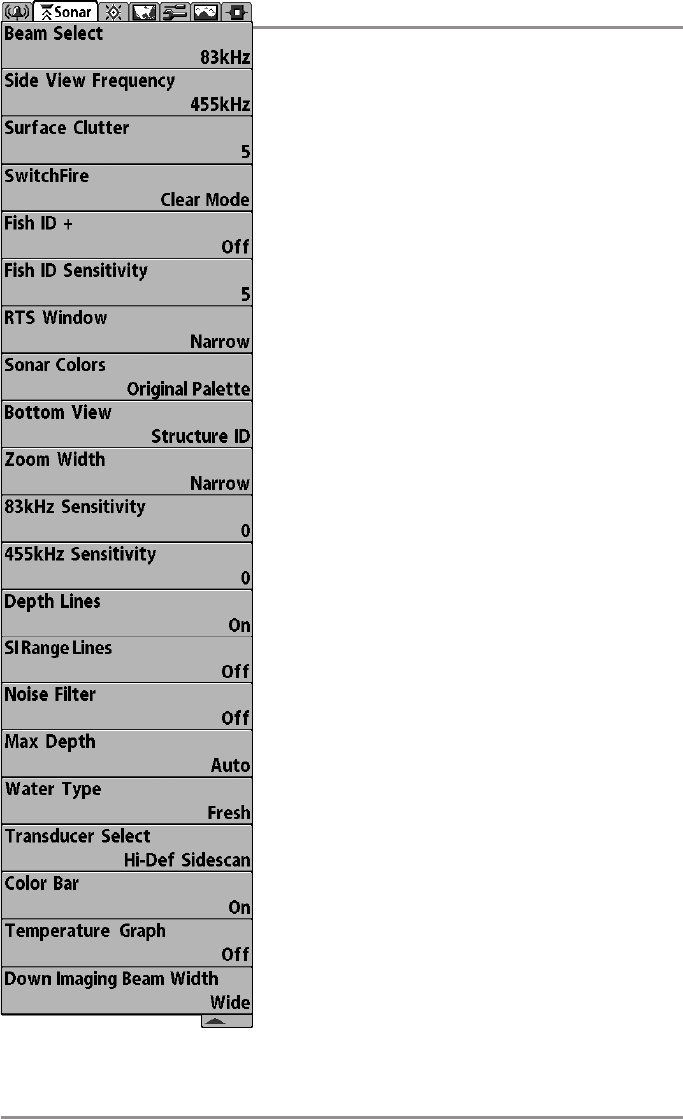
Sonar Menu Tab 124
Sonar Menu Tab
Press the MENU key twice to access the Main Menu and
then press the RIGHT Cursor key until the Sonar tab is
selected.
NOTE: Menu options can be expanded or simplified by setting the
User Mode to Advanced or Normal. See Main Menu: User Mode
for details.
NOTE: The Sonar Menu Tab will change to display menu options
that correspond with the selected transducer (see Transducer
Select).
NOTE: Menu options are determined by your Humminbird® model.
See the following pages for full menu descriptions.
1198c SI
Sonar Menu (Advanced)
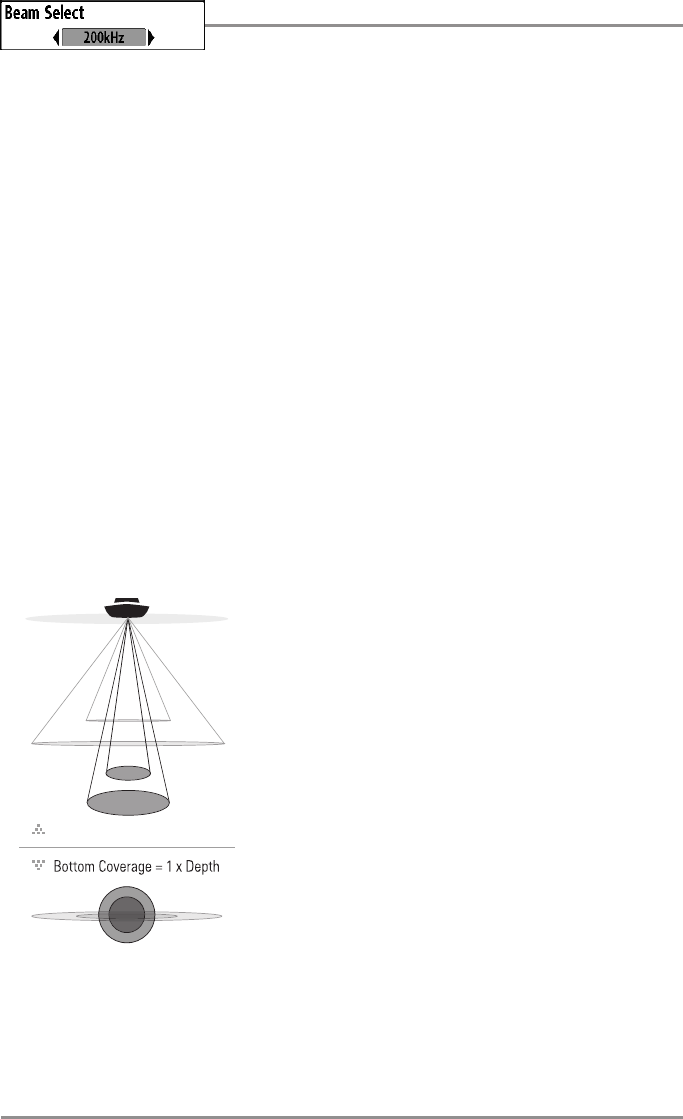
125 Sonar Menu Tab
Beam Select
Settings: DualBeam PLUS™ and Side Imaging®: 200/83 kHz, 200 kHz,
83 kHz, Down Imaging™: 200 kHz, 455 kHz; Default = 200 kHz
Beam Select sets which sonar returns from the DualBeam PLUS™transducer will be displayed
on the screen. The available beam frequencies are determined by your Humminbird® model.
DualBeam PLUS™ models (1158c) and Side Imaging® models (1198c SI) allow you to choose
200/83 kHz, 200 kHz, or 83 kHz.
• When set to 200/83 kHz, the returns from both beams are blended by starting with the
83 kHz wide beam return, dimming it, and then overlaying it with the 200 kHz narrow
beam return. The darker 200 kHz narrow beam sonar returns will stand out from the
paler 83 kHz wide beam sonar returns. The Split Sonar View continues to display the
sonar returns from each beam in their respective windows. The blended information is
shown in the Sonar View and the Sonar Zoom View. The RTS Window™ in the Sonar
View will only show the returns from the 200 kHz narrow beam.
• When set to 200 kHz, only the returns from the 200 kHz narrow beam will be displayed
in the Sonar View and the Sonar Zoom View. The Split Sonar View will continue to
display returns from both beams in their respective windows. The RTS Window™ in the
Sonar View will display the returns from the 200 kHz narrow beam.
• When set to 83 kHz, the returns from the 83 kHz wide beam will be displayed in the
Sonar View and the Sonar Zoom View. The Split Sonar View will continue to display
returns from both beams in their respective windows. The RTS Window™ will display the
returns from the 83 kHz wide beam.
The Down Imaging™ models (1158c DI) allow you to
choose 200 kHz or 455 kHz for conical sonar coverage in
the traditional sonar views.
• When set to 200 kHz, only the returns from the 200
kHz (25°) beam will be displayed in the Down
Imaging™ Views.
• When set to 455 kHz, only the returns from the 455
kHz (16°) narrow beam will be displayed in the Down
Imaging™ Views
75 Degree Total Coverage
16°
25°
455kHz
200kHz
75°
455kHz
45° 800kHz
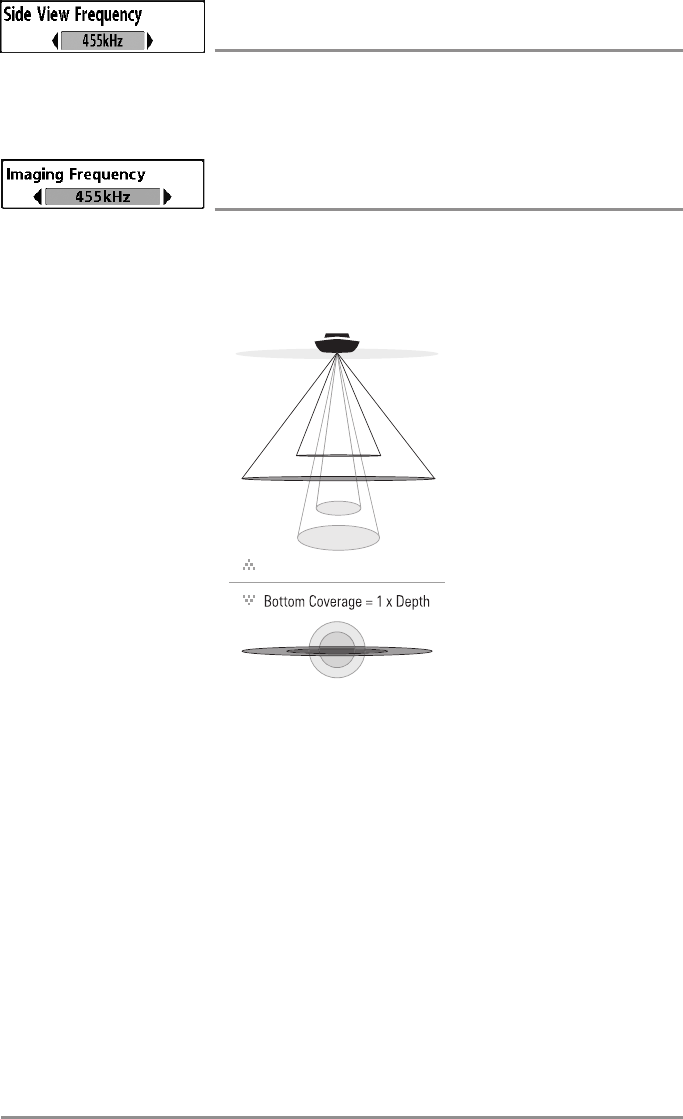
Side View Frequency
(1198c SI only)
Settings: 800 kHz or 455 kHz; Default = 455 kHz
Side View Frequency allows you to select which frequency to apply to the Side Imaging® beams
(800 kHz or 455 kHz).
Imaging Frequency
(1158c DI only)
Settings: 800 kHz, 455 kHz; Default = 455 kHz
Imaging Frequency allows you to select which frequency to apply to the Down Imaging™
beams (455 kHz or 800 kHz). For the best overall image quality and depth, select 455 kHz. For
the sharpest image (but limited depth capability), select 800 kHz.
75 Degree Total Coverage
16°
25°
455kHz
200kHz
75°
455kHz
45° 800kHz
Sonar Menu Tab 126

127 Sonar Menu Tab
Surface Clutter
Settings: Low = 1 to High = 10; Default = 5
Surface Clutter adjusts the filter that removes surface clutter noise caused by algae and
aeration. The lower the setting, the less surface clutter will be displayed.
SwitchFire™
Settings: Max Mode, Clear Mode; Default = Clear Mode
SwitchFire™ controls how the sonar returns are displayed in the Sonar Views.
Choose Max Mode to see only raw sonar returns on the display. When Max Mode is selected,
you will see the maximum sonar information available within the transducer beam, so more fish
arches and better jig tracking are shown.
Choose Clear Mode to see less clutter and more fish size accuracy on the display. When Clear
Mode is selected, the clutter is filtered, and sonar returns are interpreted to provide more details
about the objects within the transducer beam, regardless of their location. In other words, a
large arch on the display means a large fish has been detected.
Surface
Clutter
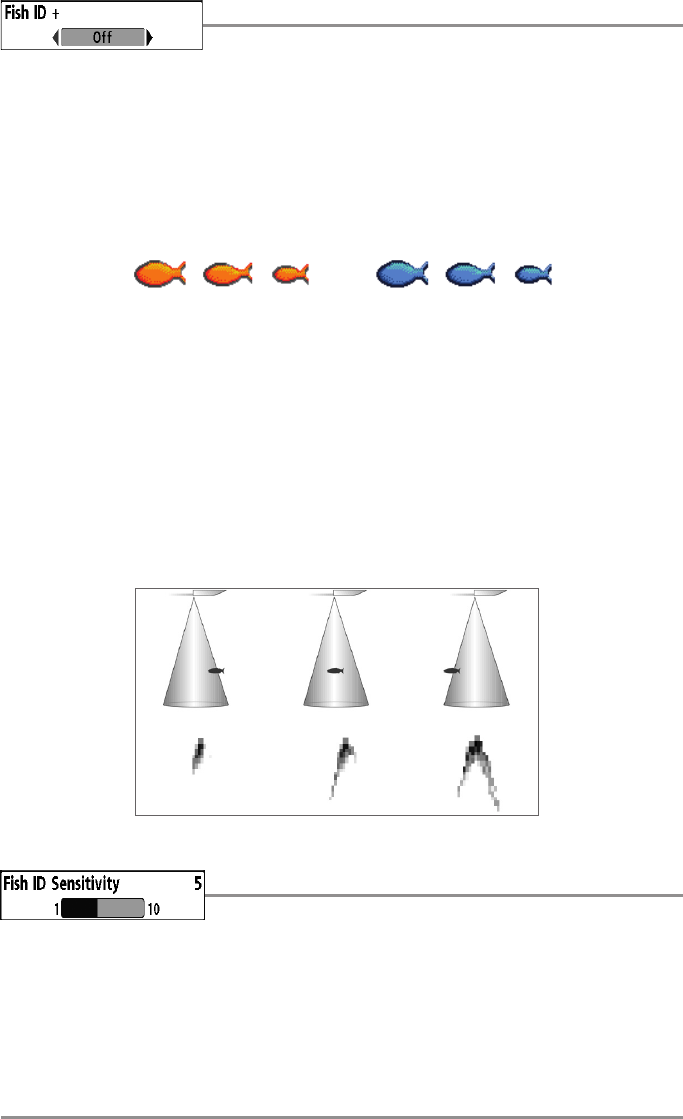
Sonar Menu Tab 128
Fish ID+™
Settings: Off, On; Default = Off
Fish ID+™ uses advanced signal processing to interpret sonar returns and will display a Fish
Symbol when very selective requirements are met. When a fish is detected, a fish icon and its depth
are displayed above the return that has been classified as being a fish. Three different fish size icons
represent the intensity of the sonar return and provide an indicator of relative fish size.
In DualBeam PLUS™ models (1158c, 1198c SI), targets detected in the 200 kHz narrow beam
are represented as orange fish symbols, and targets detected in the 83 kHz wide beam are
represented as blue fish symbols.
In the 1158c DI, targets detected in the 455 kHz conical beam are represented as orange fish
symbols, and targets detected in the 200 kHz conical beam are represented as blue fish symbols.
When Fish ID+™ is turned off, the Fishfinder shows only the raw sonar returns on the display.
These returns will often result in “arches“ forming on the display, indicating potential targets.
Due to the transducer beam angle, the distance to a fish decreases as the fish moves into the
beam, and then increases as it moves out again, creating a Fish Arch when this distance change
is shown on the display. Boat speed, chart speed, and the position of the fish within the sonar
beam greatly affect the shape of the arch.
Fish ID Sensitivity
Settings: Low = 1, High = 10; Default = 5
Fish ID Sensitivity adjusts the threshold of the Fish ID+™ detection algorithms. Selecting a
higher setting allows weaker returns to be displayed as fish. This is useful for identifying smaller
fish species or baitfish. Selecting a lower setting displays fewer fish from weak sonar returns.
This is helpful when seeking larger species of fish.
Fish ID Sensitivity is used in conjunction with Fish ID+™. Fish ID+™ must be On for Fish ID
Sensitivity to affect the ability of the Fishfinder to identify sonar returns as fish.
Narrow beam
orange fish symbols
Wide beam
blue fish symbols
Transducer Cone and Fish Arches
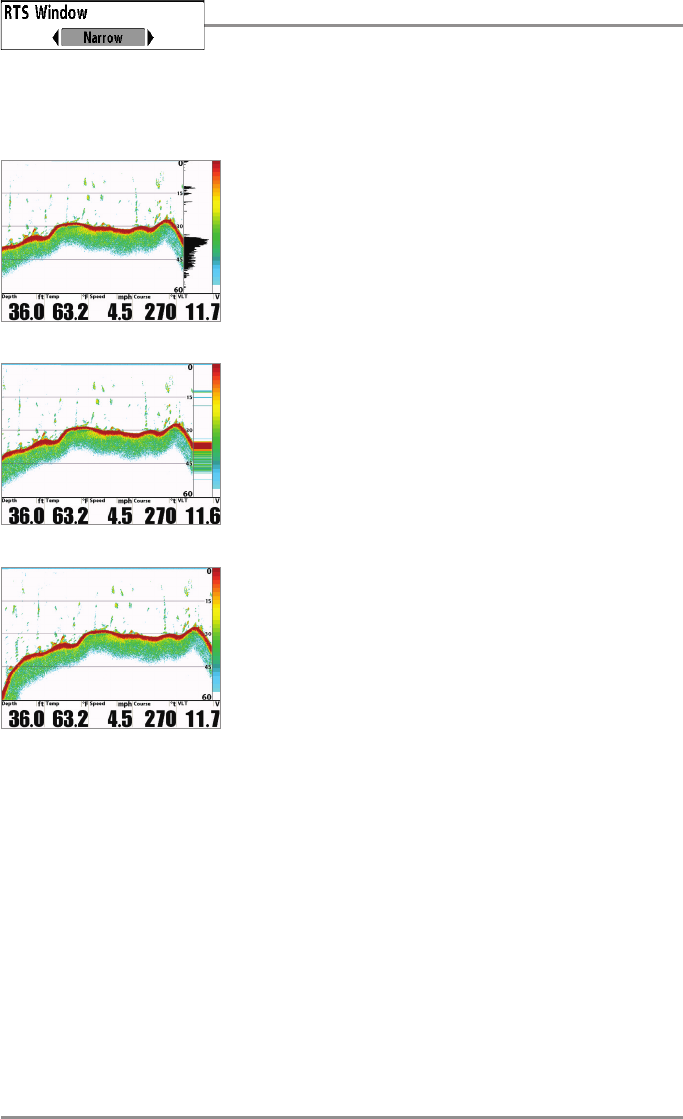
129 Sonar Menu Tab
Real Time Sonar (RTS™) Window
Settings: Wide, Narrow, Off; Default = Narrow
RTS Window™ sets the RTS Window™ to Wide or Narrow, or turns it off in the Sonar View. The
RTS Window™ always updates at the fastest rate possible and only displays returns that are
within the transducer beam. See What’s on the Sonar Display for more information.
NOTE: The Wide RTS Window™ does not use grayscale.
RTS Window™ (Wide)
RTS Window™ (Narrow)
RTS Window™ (Off)
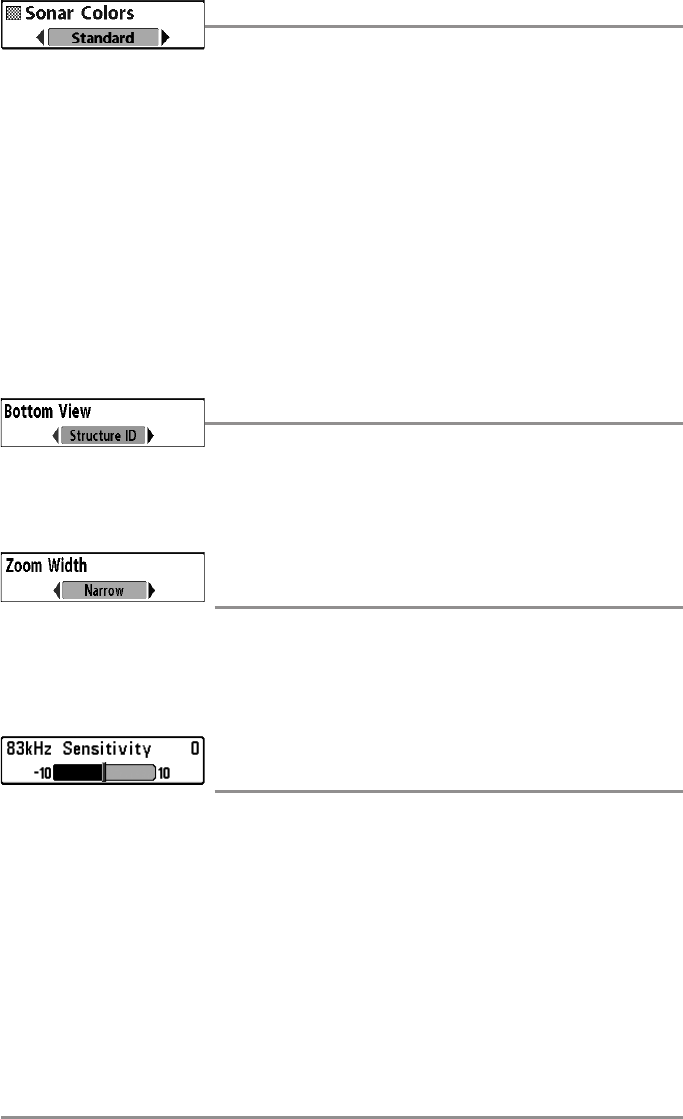
Sonar Menu Tab 130
Sonar Colors
Settings: Gray, Green, Inverse, Original Palette, Palette 1, Palette 2,
Palette 3; Default = Original Palette
Sonar Colors allows you to select which color palette you would like to use for the display. The
palette you choose will be applied to the Sonar Views.
•Gray: Light Gray (weak) to Black (strong)
•Green: Dark Green (weak) to Light Green (strong)
•Inverse: Black (weak) to White (strong)
•Original Palette: Cyan (weak) to Red (strong)
•Palette 1: Navy Blue (weak), Purple (medium), Yellow (strong)
•Palette 2: Navy Blue (weak), Green (medium), Yellow (strong)
•Palette 3: Navy Blue (weak) to Red (strong)
Bottom View
Settings: Structure ID, WhiteLine; Default = Structure ID
Bottom View selects the method used to represent bottom and structure on the display. See
What’s on the Sonar Display: Sonar Bottom Presentation for more information.
Zoom Width
(Sonar Zoom View only)
Settings: Narrow, Medium, Wide; Default = Wide
Zoom Width adjusts the width of the zoomed view on the Sonar Zoom View, which is on the
left side of the display. See Views: Sonar Zoom View for more information.
83 kHz Sensitivity
(Advanced, DualBeam PLUS™ Sonar only)
Settings: -10 to +10, Default = 0
83 kHz Sensitivity changes the sensitivity of the 83 kHz beam. Increasing the 83 kHz Sensitivity
will display additional weak returns, and decreasing the 83 kHz Sensitivity will display fewer
weak returns.
NOTE: 83 kHz Sensitivity is particularly useful for adjusting the sensitivity of the 83 kHz sonar returns
in the 200/83kHz Split Sonar View. The 83kHz sensitivity can be adjusted without affecting the
sensitivity of the 200 kHz returns shown in the 200 kHz sonar window.
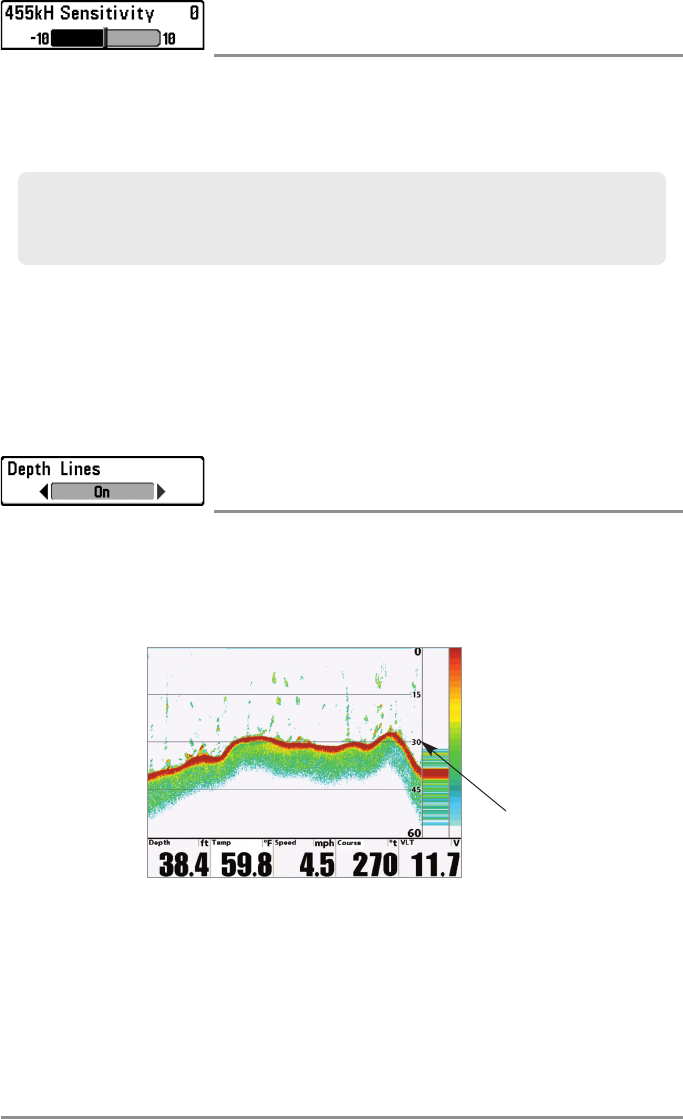
131 Sonar Menu Tab
455 kHz Sensitivity
(Advanced, with optional purchase QuadraBeam PLUS™ transducer)
Settings: -10 to +10, Default = 0
455 kHz Sensitivity adjusts the sensitivity of the 455 kHz beam. Increase the sensitivity to
display additional weak returns and decrease the sensitivity to display fewer weak returns.
The 455 kHz Sensitivity menu option is available when a QuadraBeam PLUS™ transducer is
attached to the Fishing System, User Mode is set to Advanced (see Setup Menu Tab: User
Mode), and Transducer Select is set to QuadraBeam (see Sonar Menu Tab: Transducer Select).
NOTE: Visit our Web site at humminbird.com to order this accessory online or contact our Customer
Resource Center at 1-800-633-1468.
Depth Lines
(Advanced)
Settings: Off, On; Default = On
Depth Lines divide the display into four equal sections which are separated by three horizontal
depth lines. The depth of each line is displayed along the depth scale. You can turn Depth Lines
On or Off.
NOTE: 455 kHz Sensitivity is particularly useful for adjusting the sensitivity of the 455 kHz sonar
returns in the Side Beam View. The 455 kHz sensitivity can be adjusted without affecting the
sensitivity of the 200 kHz returns shown in the 200 kHz sonar window.
Depth
Lines
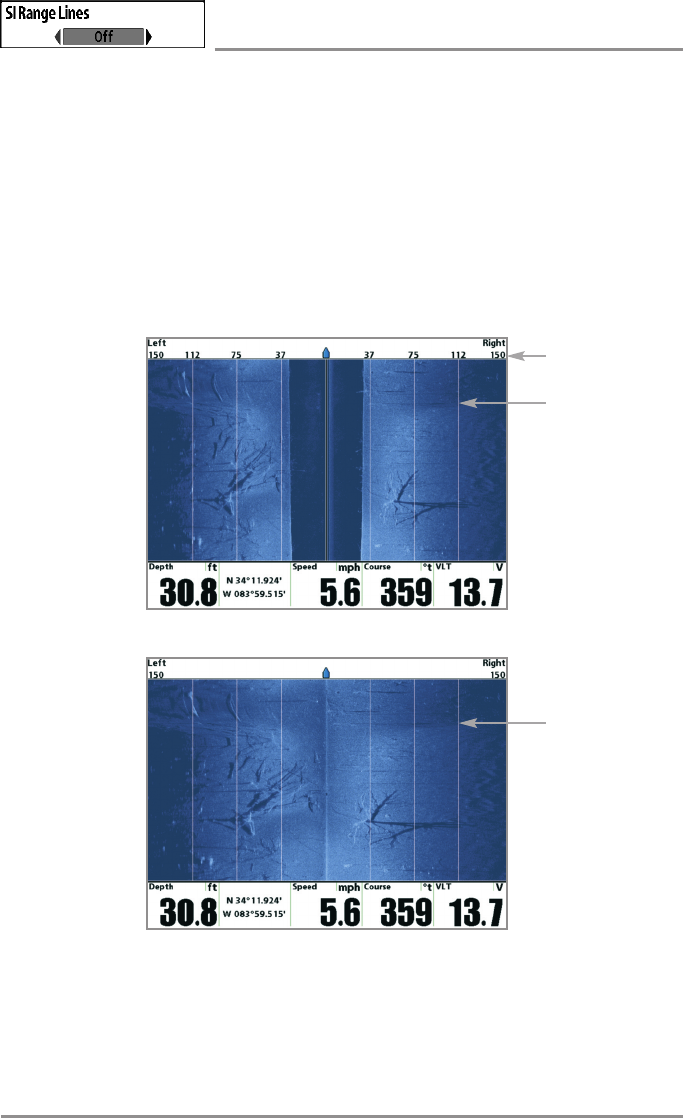
Sonar Menu Tab 132
SI Range Lines
(Advanced, Side Imaging® View only)
Settings: Off, On; Default = Off
SI Range Lines divide each side beam range into four equal sections on the display. SI Range
Lines can be used to interpret the location of objects on the display. You can turn SI Range Lines
On (visible) or Off (hidden).
NOTE: The range numbers are estimated and should not be used for measurement.
NOTE: If both SI Range Lines and Contour Mode are turned on, the SI Range Lines will remain on the
display, but the individual range numbers are not available (see Side Imaging® X-Press™ Menu: SI
Enhance).
SI Range Lines (with Contour Mode Off)
Range Numbers
SI Range Lines
SI Range Lines (with Contour Mode On)
SI Range Lines

133 Sonar Menu Tab
Noise Filter
(Advanced)
Settings: Off, Low, Medium, High 1, High 2, High 3; Default = Low
Noise Filter adjusts the sonar Noise Filter to limit interference on the display from sources such
as your boat engine, turbulence, or other sonar devices.
The Off setting removes all filtering. Low, Medium, and High 1, High 2, High 3 settings add
progressive filtering of the sonar returns. High 1, High 2, and High 3 are useful when there is
excessive trolling motor noise, but in some deep water situations, the High settings may actually
hinder your unit’s ability to find the bottom.
Max Depth
(Advanced)
Settings: Auto, 10 to 1500 feet; 3 to 500 meters [International models
only], Default = Auto
Max Depth controls the maximum depth of operation. When Max Depth is set to Auto, the
Fishfinder will acquire bottom readings as needed (within the capacity of the unit). When Max
Depth is set to match your fishing maximum depth, your Fishfinder will not attempt to acquire
sonar data below that depth, so more detail will be shown on the screen.
NOTE: If the bottom is deeper than the Max Depth setting, the digital depth readout will flash,
indicating that the Fishfinder cannot locate the bottom.
Water Type
(Advanced)
Settings: Fresh, Salt (shallow), Salt (deep); Default = Fresh
Water Type configures your unit for operation in fresh or salt water. In salt water, you can also
choose the shallow or deep setting.
Water Type affects the accuracy of deep water depth readings. In salt water, what would be
considered a large fish might be 2 to 10 times bigger than a large fish in fresh water (depending
on the type of fish you are seeking). The salt water setting allows for a greater range in fish size
adjustment to account for this difference.
Max Depth controls the down beam reading. The SI Range (Side Imaging® Range) controls the
side beams and down beam reading at the same time. If SI Range is set to a deeper range than
the Max Depth setting, your 1198c SI Combo will default to the SI Range setting. For example,
if you set the Max Depth to 50 feet and then set the SI Range to 150 feet, your unit will acquire
bottom readings from 150 feet (see Side Imaging® X-Press™Menu: SI Range).
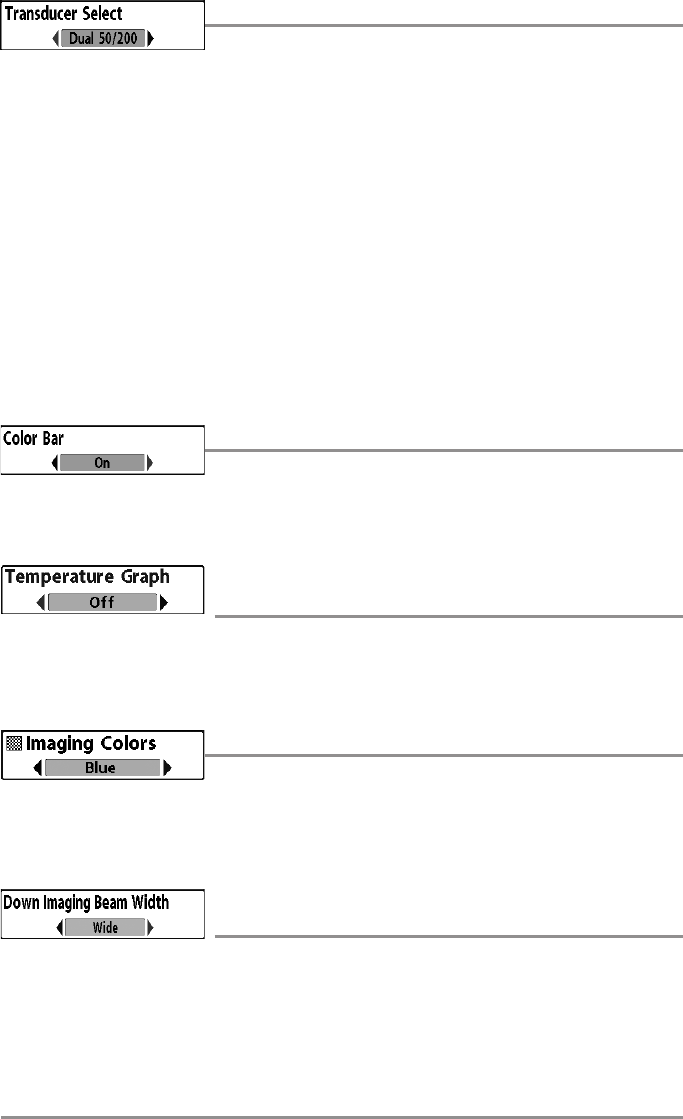
Sonar Menu Tab 134
Transducer Select
Settings: Various
Transducer Select allows you to select which transducer you want to use. The transducer
setting must correspond to the transducer type connected to your system.
•1198c SI: Hi-Def Sidescan is the default selection. The Compact Sidescan, Sidescan,
QuadraBeam PLUS™, Dual Beam, Dual 50/200 kHz, and Universal Sonar require a
separate purchase.
•1158c: Dual Beam is the default selection. The QuadraBeam PLUS™, Dual 50/200 kHz
and Universal Sonar 2 transducers require a separate purchase. The 1158c does not
support High-Definition Sidescan, Compact Sidescan, or Sidescan transducers.
•1158c DI: Down Imaging™ is the default selection. The Dual 50/200 kHz, Dual 83/200
kHz, and Universal Sonar 2 transducers require a separate purchase. The 1158c DI does
not support High-Definition Sidescan, Compact Sidescan, or Sidescan transducers.
NOTE: To purchase transducers, visit our Web site at humminbird.com or call our Customer Resource
Center at 1-800-633-1468.
Color Bar
Settings: Off, On; Default = On
Color Bar allows you to display or suppress the display of the color bar shown in the full screen
Sonar View.
Temperature Graph
(Sonar View only, with Temperature input)
Settings: Off, On, Default = On
Temperature Graph allows you to display or suppress a water temperature graph over the main
Sonar View to show temperature changes correlated to recent sonar history.
Imaging Colors (1158c DI only)
Settings: Blue, Amber 1, Amber 2, Brown, Green, Inverse, Gray,
Green/Red; Default = Blue
Imaging Colors allows you to select which color palette you would like to use for the Down
Imaging™ display.
Down Imaging™ Beam Width
(Advanced, 1198c SI only)
Settings: Narrow, Medium, Wide; Default = Wide
Down Imaging™ Beam Width controls the width of the beam (side to side) for the Down
Imaging™ View and sets the amount of information shown on the display.
To see only the data directly under your boat, select Narrow. Medium reveals more information,
while Wide displays the maximum information available from the Down Imaging™ beam width.

135 Navigation Menu Tab
Navigation Menu Tab
Press the MENU key twice to access the Main Menu, then
press the RIGHT Cursor key until the Navigation tab is
selected.
NOTE: Menu options will vary depending on system settings,
such as whether you are currently navigating.
NOTE: Menu options can be expanded or simplified by setting
the User Mode to Advanced or Normal. See Main Menu: User
Mode for details.
NOTE: Menu options are determined by your Humminbird®
model. See the following pages for full menu descriptions.
Navigation Menu (Advanced)

Navigation Menu Tab 136
Current Track
Settings: Save, Clear, Appearance
Current Track allows you to view the Current Track submenu. See Introduction to Navigation:
Save or Clear a Current Track for more information.
The Current Track Submenu contains the following menu options:
Save allows you to save the current track.
Clear allows you to delete the current track.
Appearance allows you to change the style and color of the current track. (Breadcrumb
Trail, Dashed Line, Solid Line or Wide Line, and if a line, the color of the line, or Color By
Depth).
If you choose Color By Depth, you cannot choose one color to represent the track; a
color range will represent the different depths on the track instead, from light green
(shallowest) to black (deepest). You can change the depth range associated with black
by using Track Color Range menu setting (see Navigation Menu Tab: Track Color
Range).
Saved Tracks
Settings: Edit, Delete, Default
Saved Tracks allows you view the Saved Tracks submenu. See Introduction to Navigation: Edit,
Delete, or Hide Saved Tracks for more information.
The Saved Tracks Submenu contains the following menu options:
Edit allows you to select a saved track and change its Name, Visibility (hidden or visible),
Style, and Color (for track line styles only).
Delete allows you to delete a track from the saved tracks list.
Default sets the default appearance of your tracks, including Visibility (hidden or visible),
Style, and Color (for track line styles only).
NOTE: To save the depth information with the Current Track, it is important to save the track and also
edit the name before powering off the control head.
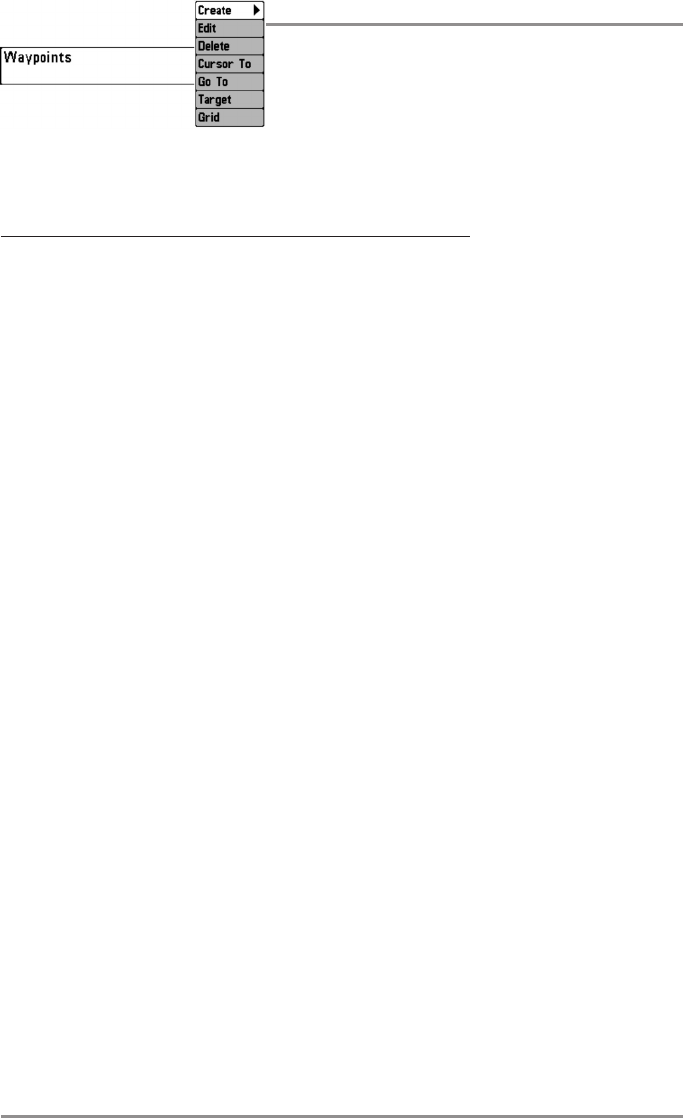
137 Navigation Menu Tab
Waypoints
Settings: Create, Edit, Delete, Cursor To, Go To, Target, Grid
Waypoints allows you to view the Waypoints submenu. See Introduction to Navigation for more
information.
The Waypoints Submenu contains the following menu options:
Create allows you to create a new waypoint, name it, and edit it immediately. The current
boat position will be used as the default, but you can set the coordinates to any valid
position. The icon used to represent the waypoint in the Chart and Combo Views can also
be changed.
Edit allows you to choose from the saved waypoints list, and then edit the Name and
Position (Latitude and Longitude), as well as assign an Icon to represent the waypoint in the
Chart and Combo Views.
Delete allows you to delete a waypoint from the saved waypoints list.
Cursor To allows you to move the cursor quickly to a waypoint from the saved waypoints
list.
Go To allows you to select a waypoint and start navigation toward that waypoint or add that
waypoint to the end of the current route.
Target allows you to apply a target to a waypoint selected from the saved waypoints list.
Grid allows you to apply a trolling grid to a waypoint selected from the saved waypoints list.
NOTE: Only one waypoint can have either a target or a grid applied to it at one time. If you apply a
target or a grid to a new waypoint, the original waypoint will lose its target or grid.
NOTE: The spacing of the rings on the waypoint target and the spacing of the gridlines on the
trolling grid is the same as the length of the scale bar on the left edge of the display. Zooming in or
out will decrease or increase the spacing, respectively.
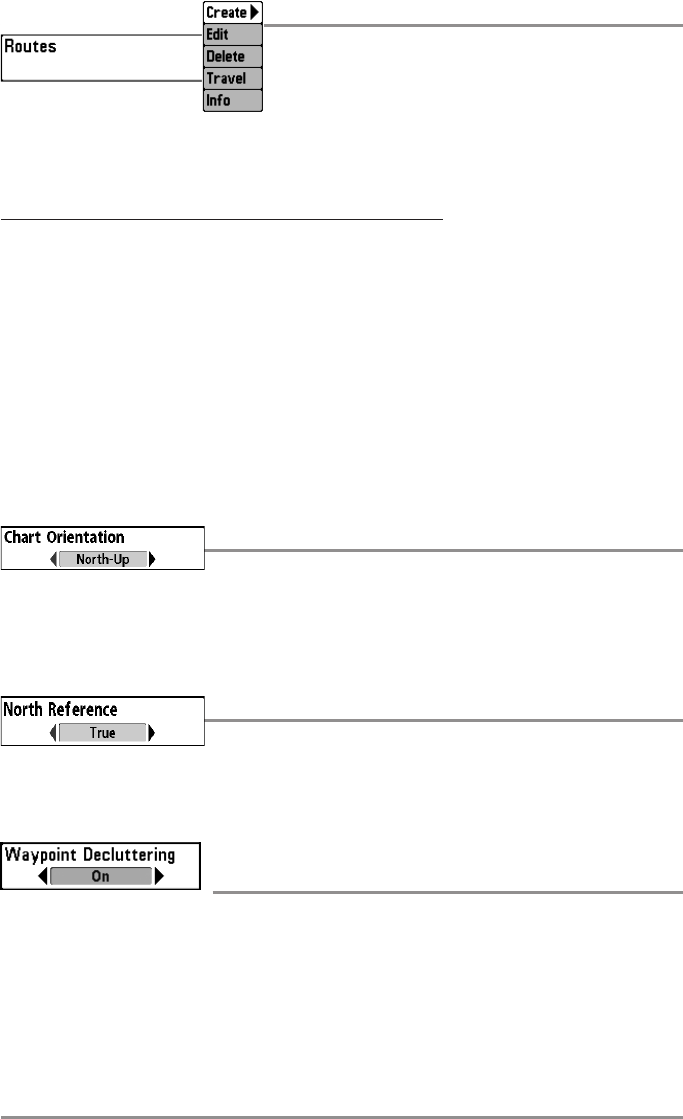
Navigation Menu Tab 138
Routes
Settings: Create, Edit, Delete, Travel, Info
Routes allows you to view the Routes submenu. See Introduction to Navigation: Save, Edit, or
Delete a Route for more information.
The Routes Submenu contains the following menu options:
Create allows you to create a new route from an empty route, name it, and add saved
waypoints to it immediately. You can also change the waypoint order of the route from
this menu.
Edit allows you to select a saved route and change its name and the waypoints in it.
Delete allows you to delete a route from the saved routes list.
Travel allows you to choose a route from the saved routes list and use it as your current
route. Routes can be traveled in either the forward or reverse direction. When you select
a route, navigation begins immediately.
Info provides information about the route you choose from the saved routes list,
including the distance and bearing from each waypoint to the next.
Chart Orientation
Settings: North-Up, Course-Up; Default = North-Up
Chart Orientation allows you to select whether the Chart and Combo Views should be drawn
North-Up or Course-Up. The Chart Orientation setting does not apply to the Bird’s Eye View (see
Viewing Cartography).
North Reference
Settings: True, Magnetic; Default = True
North Reference allows you to have bearings displayed with one of two orientations: True North
or Magnetic North.
Waypoint Decluttering
(Advanced)
Settings: Off, On; Default = On
Waypoint Decluttering allows you to set the declutter feature On or Off. When two or more
waypoints overlap, or are displayed close together on a chart view, the screen will automatically
declutter—waypoint names will shorten and the waypoint icons will change into small blue
icons. Select Off to display waypoints at regular size.

139 Navigation Menu Tab
Trolling Grid Rotation
Settings: 0° to 89°, Default = 0°
Trolling Grid Rotation allows you to set the orientation of the trolling grid in degrees, where a
setting of 0° displays a standard North, South, East, West alignment. See Introduction to
Navigation: Add a Waypoint Target or Trolling Grid for information.
NOTE: This feature may appear as either Trolling Grid Rotation or Grid Rotation, depending on your
model.
Trackpoint Interval
Settings: 1 second, 5 seconds, 10 seconds, 15 seconds, 30 seconds, or
60 seconds; Default = 1 second
Trackpoint Interval allows you to select the time period between trackpoints. The current track
can only contain up to 20,000 trackpoints, so longer time periods cause the track to extend back
further in time, but will be less detailed.
Trackpoint Interval works in conjunction with Track Min Distance. Both conditions must be met
before a trackpoint is added to the current track. During slow travel or drift, setting both
Trackpoint Interval and Track Min Distance to small values will allow you to increase the track
resolution.
Track Min Distance
(Advanced)
Settings: 1 to 300 feet, or 1 to 100 meters [International Units only];
Default = 16 feet, 5 meters
Track Min Distance allows you to set a minimum distance of travel before a trackpoint is added
to the track.
Track Min Distance works in conjunction with Trackpoint Interval. Both conditions must be met
before a trackpoint is added to the current track. During slow travel or drift, setting both
Trackpoint Interval and Track Min Distance to small values will allow you to increase the track
resolution.
Track Color Range
Settings: 50 to 3000* feet or 20 to 1000 meters [International Units only],
Default = 50 feet, 20 meters
Track Color Range allows you to set the depth range that will be displayed as black, the deepest
depth, when Color By Depth is selected as the style for the current track (see Navigation Menu
Tab: Current Track).
*NOTE: Only an optional-purchase transducer with a 50 kHz frequency will allow you to track to 3000 feet.
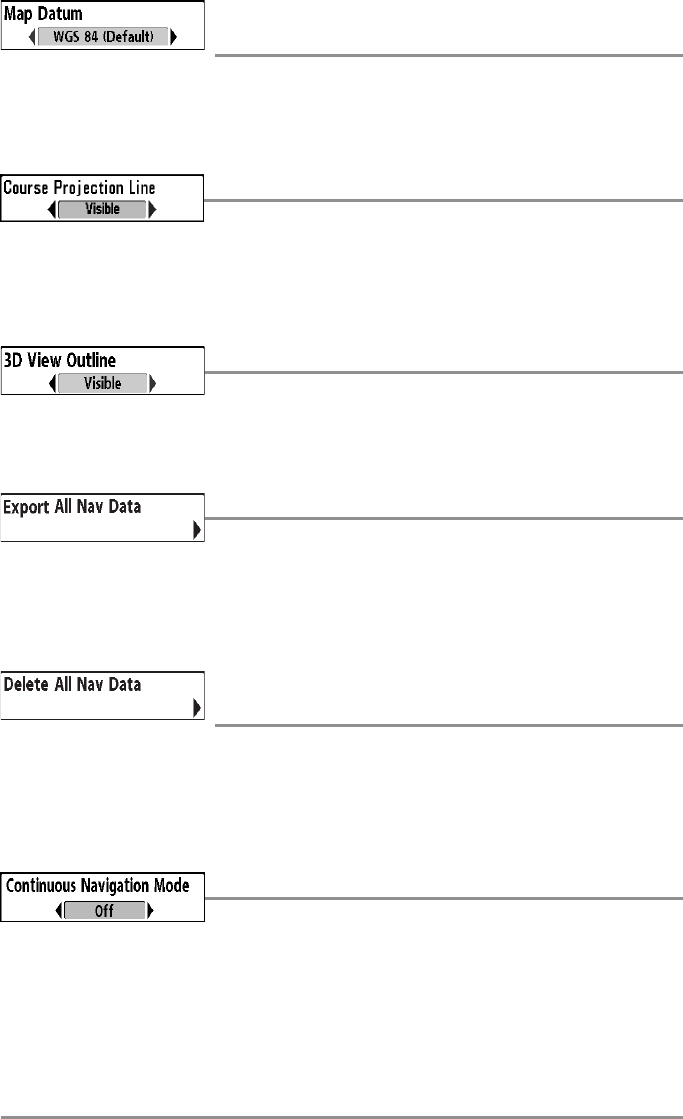
Navigation Menu Tab 140
Map Datum
(Advanced)
Settings: Various, Default = WGS 84
Map Datum allows you to change the map coordinate system used by the Fishfinder to match
those of a paper map.
Course Projection Line
Settings: Hidden, Visible; Default = Visible
Course Projection Line allows you to display or hide an arrow extending from the bow of the
boat that projects your current course, and shows where the boat will go if you continue on your
present course.
3D View Outline
Settings: Hidden, Visible, Default = Visible
3D View Outline allows you to display or hide an outline on the Chart side of the Chart or Bird's
Eye Combo Views that shows what you're viewing on the Bird's Eye side of the view.
Export All Nav Data
Settings: Press the RIGHT Cursor key and follow screen instructions.
Export All Nav Data allows you to export all saved Tracks, Waypoints, and Routes to an SD card.
If an MMC card isn’t installed, an error message will be displayed. Insert the MMC card and try
again. See SD Memory Card Slots for more information.
Delete All Nav Data
(Advanced)
Settings: Press the RIGHT Cursor key and follow screen instructions.
This menu option should be used with caution!
Delete All Nav Data allows you to delete all saved Tracks, Waypoints, and Routes.
Continuous Navigation Mode
Settings: Off, On, Default = Off
Continuous Navigation Mode allows you to continue to navigate and fish around a particular
waypoint, even if you pass over it multiple times.
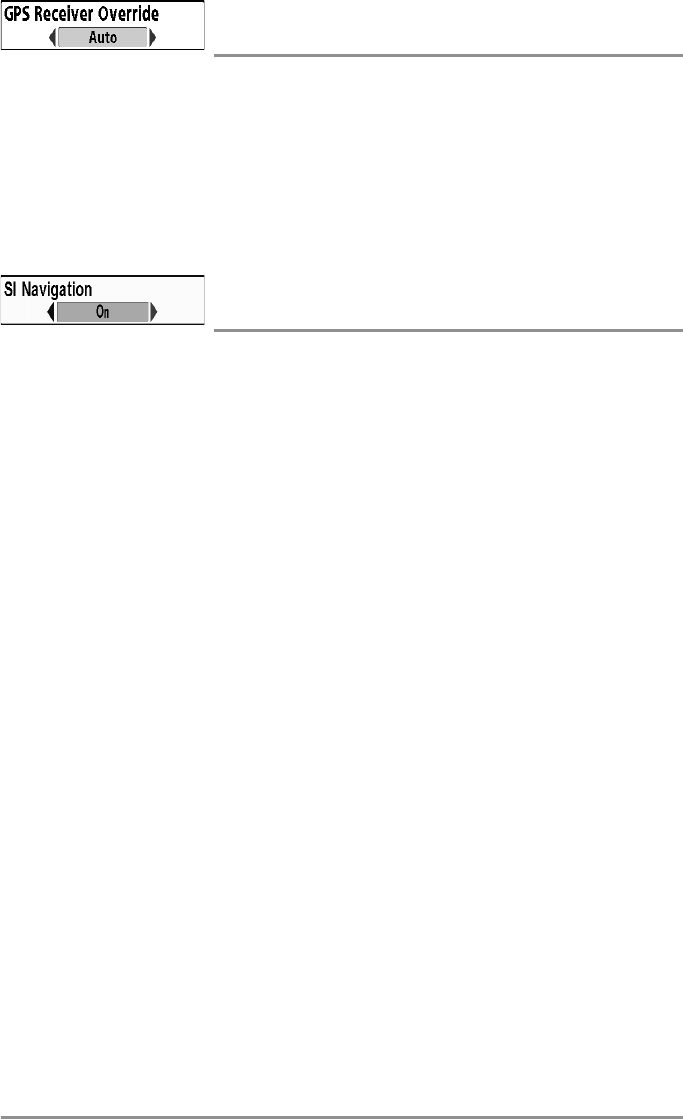
141 Navigation Menu Tab
GPS Receiver Override
(Advanced)
Settings: Internal, External, Auto; Default = Auto
GPS Receiver Override allows you to set which GPS receiver to use if you have multiple GPS
receivers plugged into the system. These multiple GPS receivers may be internal, external, or
connected via the InterLink™. If you select Auto, your unit will select a GPS receiver
automatically.
NOTE: If only one GPS receiver is plugged into your system, then Auto will be the only option shown.
SI Navigation
(Side Imaging® models only [1198c SI])
Settings: Off, On, Default = On
SI Navigation controls how the boat icon is displayed in Side Imaging® Views. If SI Navigation
is turned on, the boat icon indicates the direction the boat needs to turn to reach the next
waypoint during navigation. The boat icon color will also change to orange.
If SI Navigation is turned Off, the boat icon will not change during navigation although you can
still mark waypoints and start navigation from a Side Imaging® View. See Side Imaging® View
and Introduction to Navigation for more information.
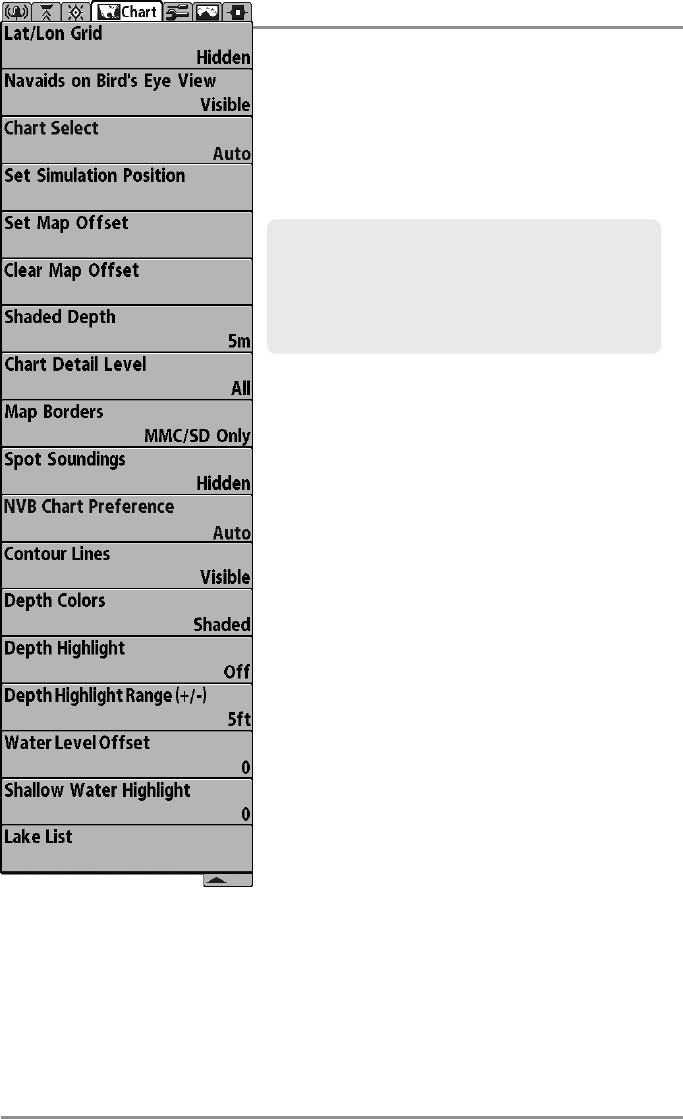
Chart Menu Tab 142
Chart Menu Tab
Press the MENU key twice to access the Main Menu and
then press the RIGHT Cursor key until the Chart tab is
selected.
NOTE: Menu options can be expanded or simplified by setting
the User Mode to Advanced or Normal. See Main Menu: User
Mode for details.
NOTE: When a map from an optional-purchase SD card is
installed, the Chart Menu Tab will change to display menu
options that correspond with the active chart. To manually
select a chart card, see Chart Select. Also, see Add Maps
to the Fishing System for more information.
Chart Menu, Advanced
(shown with optional Navionics®
and LakeMaster® menu options)

143 Chart Menu Tab
Lat/Lon Grid
Settings: Hidden, Visible, Default = Hidden
Lat/Lon Grid allows you to display or hide a grid showing latitude and longitude lines.
Navaids on Bird’s Eye View
Settings: Hidden, Visible, Default = Visible
Navaids on Bird's Eye View allows you to display or hide additional navigational aids in Bird’s
Eye View, such as lights and buoys.
NOTE: You will see more navigational aids with an optional-purchase SD card.
Chart Select
Settings: Auto, Contour XD, Left Chart Card, Right Chart Card;
Default = Auto
Chart Select allows you to choose which chart to use if you have built-in charts or a map card.
If you select Auto, your unit will select a chart automatically. Select Right to use the SD card
installed in the right card slot, and select Left to use the SD card installed in the left card slot
(see SD Memory Card Slots: Add Maps to Your Fishing System).
NOTE: The SD Cards require a separate purchase. For more information, visit our Web site at
humminbird.com or contact our Customer Resource Center at 1-800-633-1468.
Set Simulation Position
(Advanced)
Settings: Press the RIGHT Cursor key and follow screen instructions to
activate.
Set Simulation Position allows you to set the position of the boat used in the Simulator. Press
any arrow on the 4-WAY Cursor Control key to activate the cursor and move it to the coordinates
where you want start the simulation. Then confirm the position using the Set Simulation menu
setting.
NOTE: The cursor must be active in order for this procedure to work. If the cursor was not active before
you began this procedure, an error message will appear. Exit the menu, set the cursor, then try again.
z
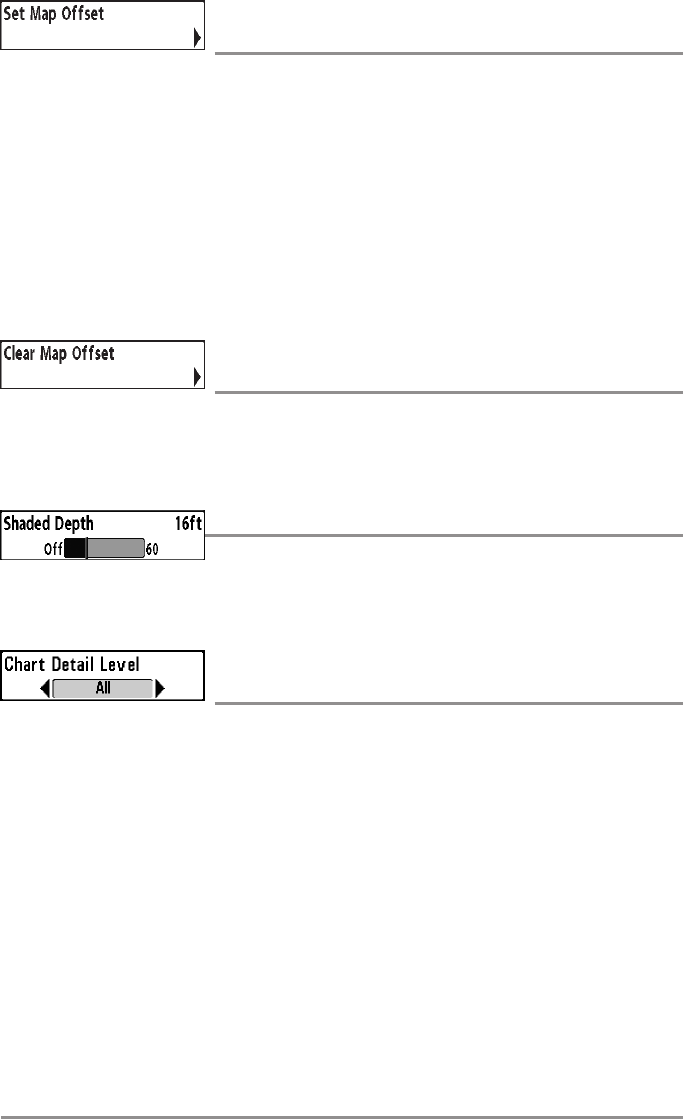
Chart Menu Tab 144
Set Map Offset
(Advanced)
Settings: Press the RIGHT Cursor key and follow screen instructions to
activate.
Set Map Offset allows you to change the map offset used by your Fishing System. Press the 4-
WAY Cursor Control key to activate the cursor and move it to the location where the Map Offset
will be applied. Then, confirm the map offset position using the Set Map Offset menu setting.
The Map Offset will be applied to all maps and not just the map that requires the correction. The
Map Offset should be cleared if a different map is to be used.
NOTE: The cursor must be active in order for this procedure to work. If the cursor was not active before
you began this procedure, an error message will appear. Exit the menu, set the cursor, then try again.
Clear Map Offset
(Advanced)
Settings: Follow screen instructions to activate.
Clear Map Offset allows you to clear the Map Offset. The Clear Map Offset menu option is
available when Map Offset is active.
Shaded Depth
Settings: Off, 1 to 180 feet, or 1 to 60 meters [International Units only],
Default = 15 ft, 5 m
Shaded Depth allows you to change the depth used for shading on the Chart Views.
Chart Detail Level
(optional-purchase Navionics® charts only)
Settings: Basic, Navigation, Underwater, All, Custom; Default = All
Chart Detail Level allows you to select how much chart detail you want displayed on the
Navigation Views.
NOTE: Some chart details are only available with optional-purchase SD cards.
Basic shows land areas, ports, obstructions, and restricted areas.
Navigation shows navaids, landmarks, ferryways, and navigation routes in addition to
the Basic information.
Underwater shows depth contours, fishing areas, underwater wrecks, tides and
currents in addition to the Basic and Navigation information.
All shows roads, buildings, railways, and other notations in addition to the Basic,
Navigation, and Underwater information.
Custom (Advanced user mode) allows you to display or hide chart layers on the
Navigation Views. The available chart layers include Navigable Canals, Boundaries,
Restricted Areas, Coastline, Bridges, etc.
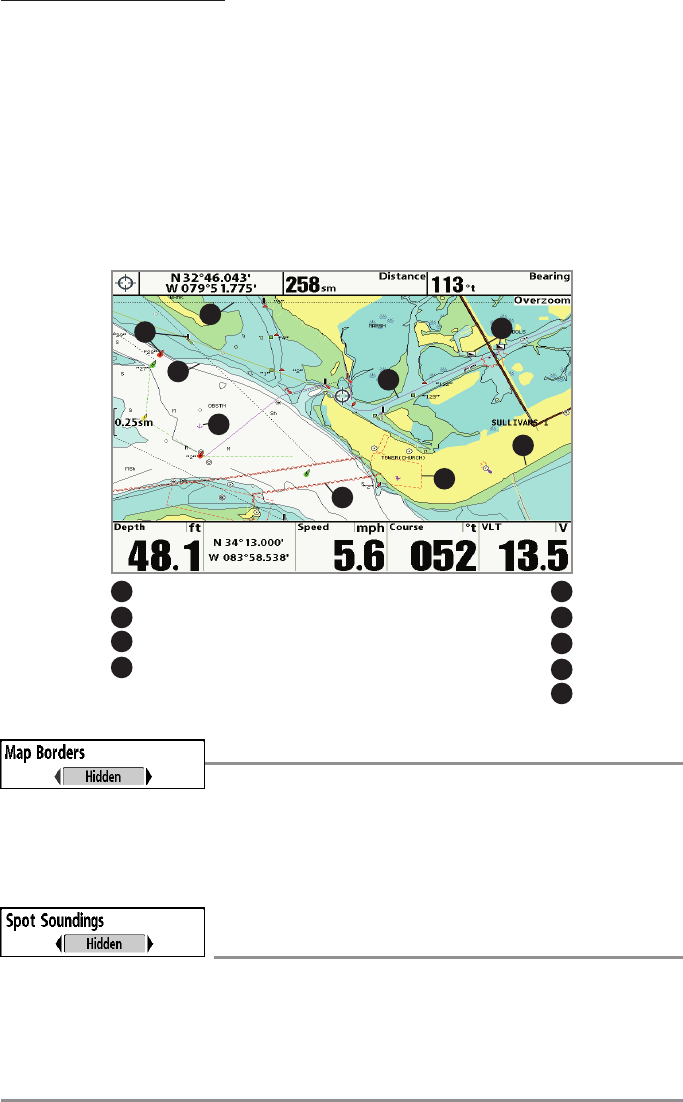
145 Chart Menu Tab
To customize the chart layers:
1. Select Chart Detail Level from the Chart Menu Tab. Press the RIGHT Cursor key to select
Custom. Selecting Custom adds the Custom Chart Layers menu to the Chart menu.
2. Press the DOWN Cursor key to select Custom Chart Layers, and press the RIGHT Cursor
key to access the submenu.
3. Use the 4-WAY Cursor key to select a layer and turn it on (visible) or off (hidden). All
changes take place immediately.
Map Borders
Settings: Hidden, MMC/SD Only, All Visible; Default = MMC/SD Only
Map Borders allows you to display or hide map borders. The dotted lines of a Map Border
indicate an area which contains a different map. Use the 4-WAY Cursor Control key to move the
active cursor within a map border, and press the ZOOM + key to view the different map.
Spot Soundings
(optional-purchase Navionics® charts only)
Settings: Hidden, Visible, Default = Hidden
Spot Soundings allows you to display or hide spot soundings, which are depth measurements
shown on the chart.
NOTE: Spot Soundings are only available with optional-purchase SD cards.
Map Borders, shown with optional-purchase
Navionics® Cartography with Custom Chart Layers
Map Borders
1
1
3
2
4
5
6
7
8
9
Bridge
2
Anchorage Area
3
Restricted Area
4
Coastline
6
Isolated Dangers: Boat Ramps
5
Recom. Route
7
Drying Lines
8
Navaids
9
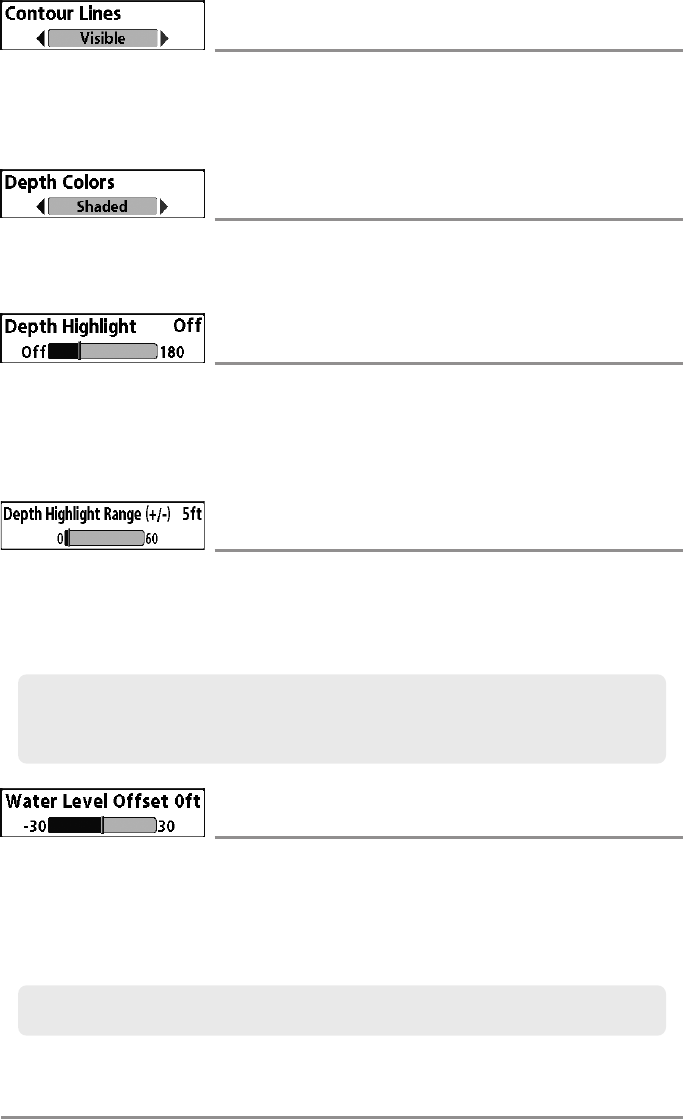
Chart Menu Tab 146
Contour Lines
(optional-purchase LakeMaster® charts only)
Settings: Hidden, Visible; Default = Visible
Contour Lines sets whether the water contour lines are visible or hidden in the Chart Views.
Contour Lines are also affected by the Water Level Offset setting.
Depth Colors
(optional-purchase LakeMaster® charts only)
Settings: Off, 1-10; Default = Off
Depth Color sets the depth shading in the Chart views to Off or Shaded.
Depth Highlight
(optional-purchase LakeMaster® charts only)
Settings: Off, 1 - 180 feet, 1 - 30 fathoms, 1 - 60 meters (International
Models only); Default = Off
Depth Highlight allows you to highlight a depth setting in the chart views. The depth you set
will be highlighted in green. Use Depth Highlight with Depth Highlight Range.
Depth Highlight Range (+/-)
(optional-purchase LakeMaster® charts only)
Settings: 0 - 60 feet, 0 - 30 fathoms, 0 - 20 meters (International Models
only); Default = 5 feet, 2 meters
Depth Highlight Range adjusts the range on each side of the highlighted depth, when a Depth
Highlight is active in the chart views.
Water Level Offset
(optional-purchase LakeMaster® charts only)
Settings: -30 to +30 feet, -5 to +5 fathoms, -10 to +10 meters
(International Models only); Default = 0
Water Level Offset allows you to change the level of the water being read from the control
head. The displayed numbers on the Contour Lines will adjust from the Water Level Offset
setting, and the water level offset will be highlighted in dark brown.
For example, if the lake is down 5 feet, set the Water Level Offset setting to -5.
For example, if you know a certain fish is holding at 18 - 20 feet, you can set the Depth Highlight
at 19 feet, and the Depth Highlight Range a +/- 1 foot. The view will show a green band from
18 - 20 feet.
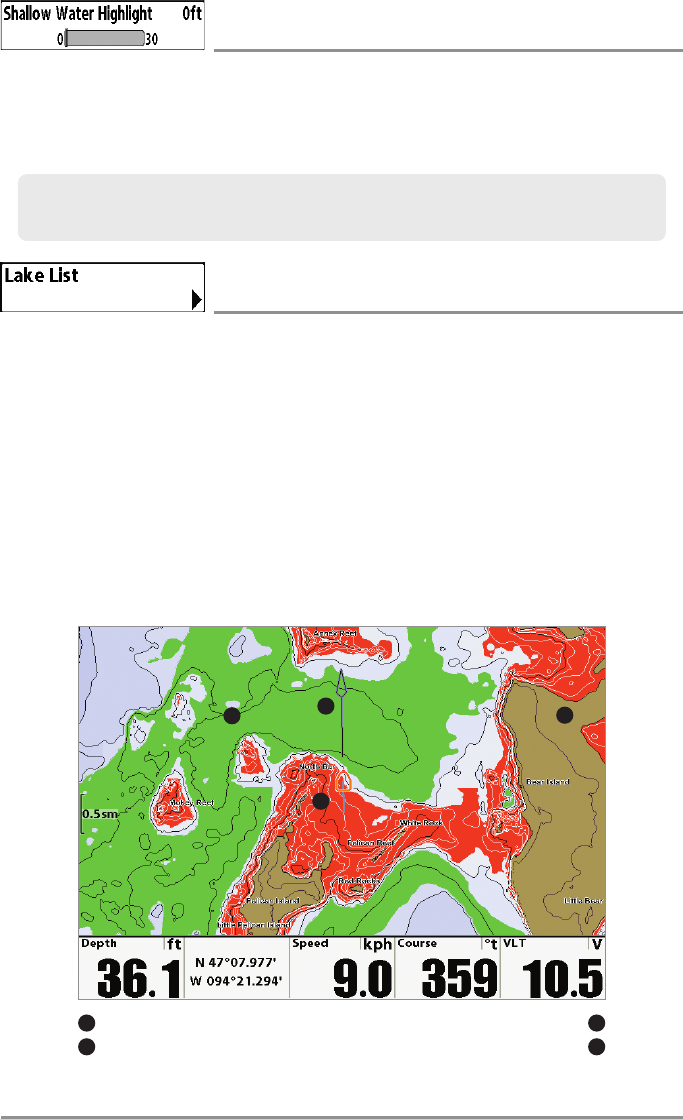
147 Chart Menu Tab
Shallow Water Highlight
(optional-purchase LakeMaster® charts only)
Settings: 0 - 30 feet, 0 - 5 fathoms, 0 - 10 meters (International Models
only); Default = 0
Shallow Water Highlight allows you to select a minimum shallow depth setting so that the
depth is highlighted in red in the Chart Views.
Lake List
(optional-purchase LakeMaster® charts only)
Settings: Press the RIGHT Cursor key to activate.
Lake List allows you to view the list of lakes included on the installed SD card.
Sort By: Highlight Sort By, and use the RIGHT or LEFT Cursor keys to select a sort option
for the list.
Scroll: Use the UP or DOWN Cursor keys to scroll through the list. As each lake is
highlighted, you can view information about the lake in the white box displayed on the
screen.
Cursor To: Highlight a lake on the list and press the RIGHT Cursor key to move the active
cursor to the location you’ve chosen. You can then mark waypoints, or press the GOTO
key to start navigation toward a waypoint, or press the INFO key for more information.
Chart View with LakeMaster®
Water Level Offset
1
Depth Highlight
2
Contour Lines
3
Shallow Water Highlight
4
1
2
4
3
For example, if your boat has a draft of 3 feet, set the Shallow Water Highlight feature to 3 feet,
and the unit will draw a red band from 0 - 3 feet. Use this setting with Water Level Offset.

Setup Menu Tab 148
Setup Menu Tab
From any view, press the MENU key twice to access the
tabbed Main Menu, then press the RIGHT Cursor key until
the Setup tab is selected.
NOTE: Menu options will vary depending on which accessories
are attached to the unit.
NOTE: Menu options can be expanded or simplified by setting
the User Mode to Advanced or Normal. See Main Menu: User
Mode for details.
Setup Menu (Advanced)

149 Setup Menu Tab
Sound Volume
Settings: Mute, 1 - 10, Default = 5
Sound Volume allows you to control the volume of all sounds emitted by the control head
(except for the volume of the alarms, which is controlled by Alarm Volume Control).
Units - Depth
Settings: Domestic Models: Feet, Fathoms; International Models: Meters;
Default = Feet/Meters
Units - Depth selects the units of measure for all depth-related readouts.
Units - Temp
(International only)
Settings: Celsius, Fahrenheit; Default = Celsius
Units - Temp selects the units of measure for all temperature-related readouts. International
Models only.
Units - Distance
(with Speed input only)
Settings: Domestic Models: Statute Miles, Nautical Miles,
Default = Statute Miles; International Models: Meters/Kilometers,
Meters/Nautical Miles, Feet/Statute Miles, Feet/Nautical Miles,
Default = Meters/Kilometers
Units - Distance selects the units of measure for all distance-related readouts, and will appear
in the menu if a Temp/Speed Accessory is connected and the paddlewheel has moved at least
once, or if the GPS Receiver is connected.
Units - Speed
(with Speed input only)
Settings: Domestic Models: mph, kts; International Models: kph;
Default = mph/kph
Units - Speed selects the units of measure for speed-related readouts, and will appear in the
menu if a Temp/Speed Accessory is connected and the paddlewheel has moved at least once, or
if the GPS Receiver is connected.
User Mode
Settings: Normal, Advanced; Default = Advanced
User Mode sets the menu system to Normal or Advanced. When set to Normal, the basic set
of menu options are shown in the menu system. When set to Advanced (default setting),
additional menu options are added to the menu system. See Main Menu: User Mode for
details.
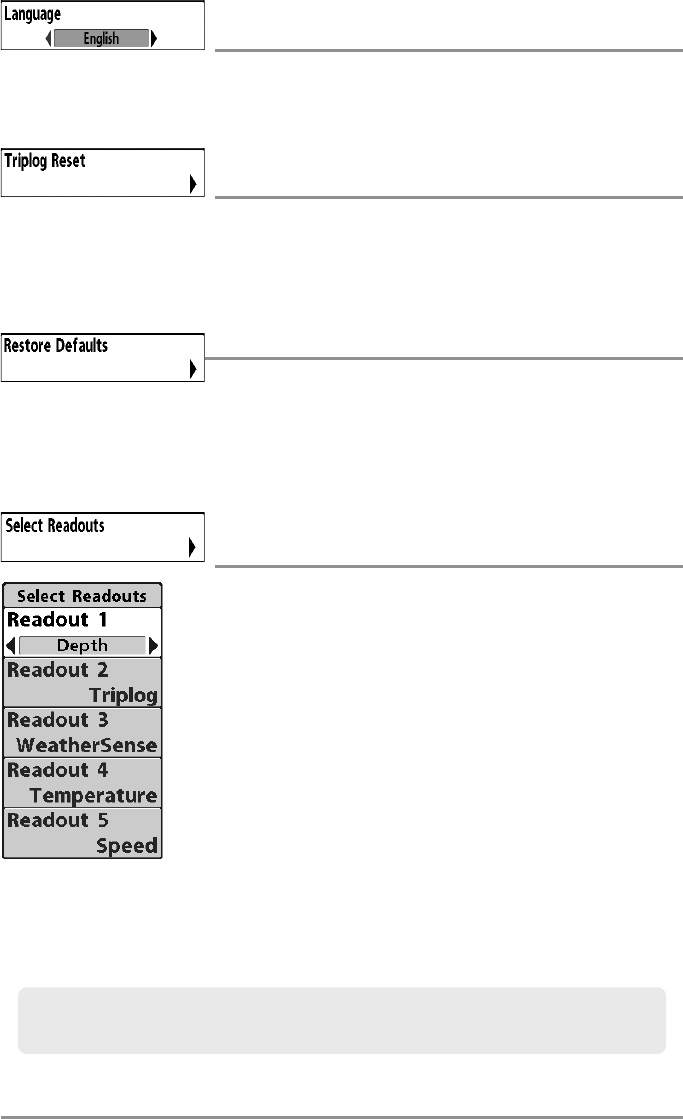
150
Setup Menu Tab
Language
(International Models only)
Settings: Various, Default = English
Language selects the display language for menus. International Models only.
Triplog Reset
(with Speed input only)
Settings: Press the RIGHT Cursor key and follow screen instructions to
activate.
Triplog Reset resets the Triplog to zero. The Triplog provides the following information: timer for
elapsed time, distance traveled since last reset, and average speed.
Restore Defaults
Settings: Press the RIGHT Cursor key and follow screen instructions to
activate.
Use this menu choice with caution!
Restore Defaults resets ALL menu settings to their factory defaults.
Select Readouts
(Advanced, Non-navigation Mode)
Select Readouts sets individual digital readouts on all the views
that can display readouts. This feature allows you to select what
information will be displayed in each of a variable number of
fixed-position readouts arranged at the bottom of the screen. To
leave the data window blank, select Off. See Views to change the
Select Readouts.
•Data windows can display readouts from supported
accessories such as a Speed accessory.
•All views share the same set of 5 readouts that can be set
one way for navigation mode using Select Nav Readouts and
another way for non-navigation mode using Select Readouts.
Non-navigation readouts are automatically replaced on the
display when navigating. However, Navigating readouts can
have any type of information in them allowing you to see
navigation or standard information while navigating. To set
Navigation readouts, see Select Nav Readouts.
Select Readouts
NOTE: The availability of the digital readout information corresponds with the view selected, the
accessory attached, and whether or not you are navigating.
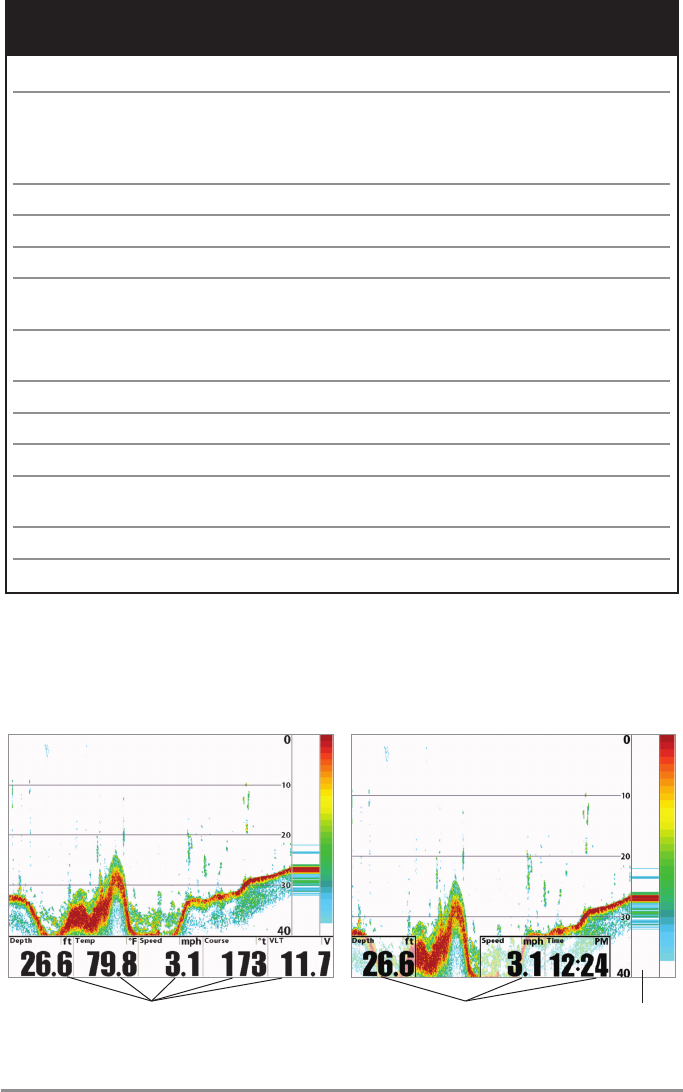
151 Setup Menu Tab
Each readout position can be empty or contain one of the following:
NOTE: You can set a second set of 5 readouts with navigation mode settings as well, so that, when you
are navigating, these views contain navigation data instead of the regular settings. See Setup Menu Tab:
Select Nav Readouts for more information.
NOTE: Some readout boxes are limited to display non-navigation information only.
NOTE: When the readout under the water column is turned off (as shown in the illustration), the sonar
display will expand to fill the screen.
Default Sonar View Custom Sonar View
Digital Readouts Digital Readouts Readout Off
Aux. Temp The current detected water temperature from an optional-purchase Temperature Probe or Temp/Speed accessory.
Course Course is the current direction the boat is traveling measured in degrees from North (i.e. 321°, where 000° is
North, 090° East, 180° is South, 270° is West). When the Course Over Ground is equal to Bearing, the boat is
said to be “On Course” and will arrive at the destination in the most efficient manner. See the Glossary for more
information.
Depth Displays the depth of the water.
Off Suppresses the readout so that no data shows in that position.
Position Position is the current location (latitude, longitude) determined by GPS.
Speed Speed is the measurement of the boat’s progress across a given distance, and is the speed measurement provided
by GPS; accurate destination times can be derived from this measurement. See the Glossary for more information.
Speed N Temp 1 Displays the water temperature and current speed measured at the depth of the downrigger when using an
optional-purchase Speed-n-Temp sensor with a downrigger and the CannonLink™ accessory.
Temp The current detected water temperature from an optional-purchase Temperature Probe or Temp/Speed accessory.
Time The current time.
Time + Date The current time and date.
Triplog Displays the triplog, which measures the elapsed time since last reset, the distance traveled since last reset, and
average speed during timed interval.
Voltage Power supplied to the control head.
Water Speed The current speed of the water as it flows past the boat.
5 Selectable Readouts; Non-Navigation Mode
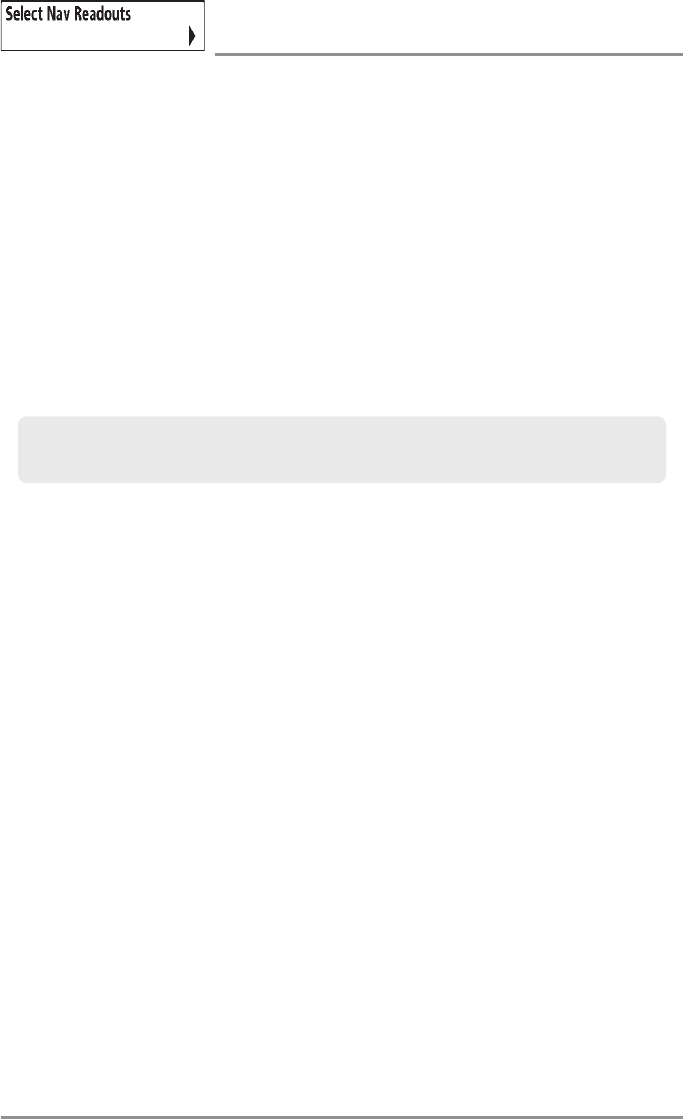
152
Setup Menu Tab
Select Nav Readouts
(Advanced, Navigation Mode)
Select Nav Readouts sets the individual digital readouts that will be used only during
navigation. This feature allows you to select what information will be displayed in each of a
variable number of fixed-position readouts arranged at the bottom of the screen on various
views. To leave the data window blank, select Off. See Views to change the Select Nav
Readouts.
•Readout positions can also display information from supported accessories such as
Temp/Speed.
•All views share the same set of 5 readouts that can be set one way for navigation mode
using Select Nav Readouts and another way for non-navigation mode using Select
Readouts. Non-navigation readouts are automatically replaced on the display when
navigating. However, Navigating readouts can have any type of information in them
allowing you to see navigation or standard information while navigating. To set Non-
Navigation readouts, see Setup Menu Tab: Select Readouts.
NOTE: The availability of the digital readout information corresponds with the view selected, the
accessory attached, and whether or not you are navigating.

153 Setup Menu Tab
Each readout position can either be empty or contain one of the items from the following table:
Bearing Bearing is the direction to a destination waypoint measured in degrees from North (i.e. 321°, where 000° is
North, 090° East, 180° is South, 270° is West).
CMG/SMG Course Made Good/Speed Made Good. Course Made Good is the angle between the starting point on a route and
the current position of the boat. The goal is to have CMG and Track equal to the same number. See the Course
Made Good illustration. Speed Made Good is the distance from the starting waypoint on the route divided by the
time elapsed since starting navigation on the route.
Course Course is the current direction the boat is traveling measured in degrees from North (i.e. 321°, where 000° is
North, 090° East, 180° is South, 270° is West). When the Course Over Ground is equal to Bearing, the boat is
said to be “On Course” and will arrive at the destination in the most efficient manner. See the Glossary for more
information.
Depth Displays the depth of the water.
Off Suppresses the readout so that no data shows in that position.
Position Position is the current location (latitude, longitude) determined by GPS.
Speed Speed is the measurement of the boat’s progress across a given distance; the speed measurement provided by
GPS; accurate destination times can be derived from this measurement. See the Glossary for more information.
Speed N Temp 1 Displays the water temperature and current speed measured at the depth of the downrigger when using an
optional-purchase Speed-n-Temp sensor with a downrigger and the CannonLink™ accessory.
TRK/CMG Track/Course Made Good. The Track Line is the desired line of travel between two waypoints, and represents the most
efficient path between the two points because it is a straight line. The TRK is measured in degrees. See above for an
explanation of Course Made Good.
Temp The current detected water temperature.
Aux. Temp The current detected water temperature from an optional-purchase Temperature Probe or Temp/Speed accessory.
Time The current time.
Time + Date The current time and date.
Triplog Displays the triplog, which measures the elapsed time since last reset, the distance traveled since last reset, and
average speed during timed interval.
VMG Velocity Made Good. Velocity Made Good is the speed of travel relative to the next waypoint on the route. The
goal is for VMG to equal Speed.
Voltage Power supplied to the control head.
WPTend/ETA/DTG Waypoint End/Estimated Time of Arrival/Distance to Go. Waypoint End is the last waypoint on the route.
Estimated Time of Arrival is the estimated time of arrival to the last waypoint on the route. Distance To Go is the
distance between the current position of the boat and the last waypoint on the route.
WPTend/TTG/DTG Waypoint End/Time To Go/Distance to Go. Waypoint End is the last waypoint on the route. Time To Go is the
estimated time required to reach the last waypoint on the route. TTG is calculated using the SOG and DTG. Distance
To Go is the distance between the current position of the boat and the last waypoint on the route.
WPTnext/ETA/DTG Waypoint Next/Estimated Time of Arrival/Distance to Go. Waypoint Next is the next waypoint on the route.
Estimated Time of Arrival is the estimated time of arrival to the next waypoint on the route. Distance To Go is the
distance between the current position of the boat and the next waypoint on the route.
WPTnext/TTG/DTG Waypoint Next/Time To Go/Distance to Go. Waypoint Next is the next waypoint on the route. Time To Go is the
estimated time required to reach the next waypoint on the route. TTG is calculated using the SOG and DTG.
Distance To Go is the distance between the current position of the boat and the next waypoint on the route.
Water Speed The current speed of the water as it flows past the boat.
XTE Cross Track Error is the straight-line distance of the boat from the intended Track. XTE measures how far the boat
is off course, and also triggers the Off Course Alarm.
5 Selectable Readouts; Navigation Mode
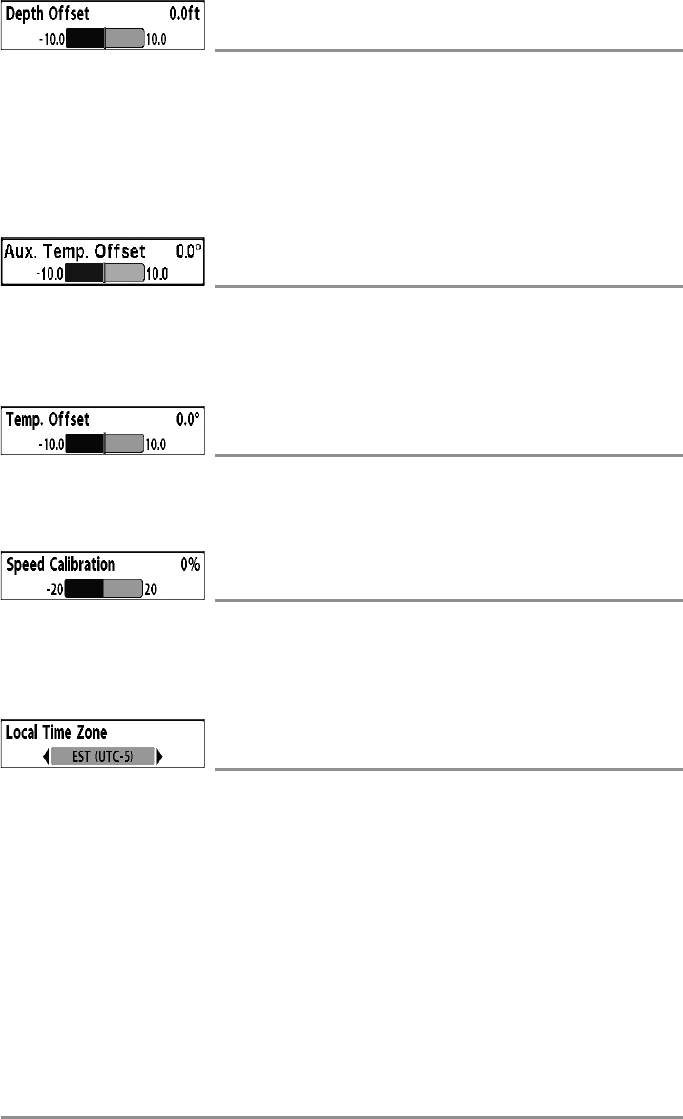
154
Setup Menu Tab
Depth Offset
(Advanced)
Settings:-10.0 to +10.0 feet or -3 to 3 meters [International models only],
Default = 0.0, or Off
Depth Offset will adjust the digital depth readout to indicate depth from the waterline or boats
keel. Enter a positive vertical measurement from the transducer to the waterline to read the
depth from the waterline. Enter a negative vertical measurement from the transducer to keel to
read the depth from the keel.
Aux. Temp Offset
(Advanced)
Settings: -10.0 to +10.0 degrees, Default = 0
Aux Temp Offset will adjust the aux temperature readout (the temperature on the optional-
purchase temperature probe or Temp/Speed accessory) by the amount entered.
Temp. Offset
(Advanced)
Settings: -10.0 to +10.0 degrees, Default = 0, or Off
Temp Offset will adjust the temperature readout by the amount entered.
Speed Calibration
(Advanced, with Speed paddlewheel only)
Settings: -20% to +20%, Default = 0%
Speed Calibration will adjust the speed readout by the percentage entered, and will appear in
the menu if a Speed accessory is connected and the paddlewheel has moved at least once.
Local Time Zone
(Advanced)
Settings: Various; Default = EST [UTC-5] - Eastern Standard Time
Local Time Zone selects your time zone in reference to the time reported by the GPS receiver
when Time+Date is selected as a Digital Readout (see Setup Menu Tab: Select Readouts).
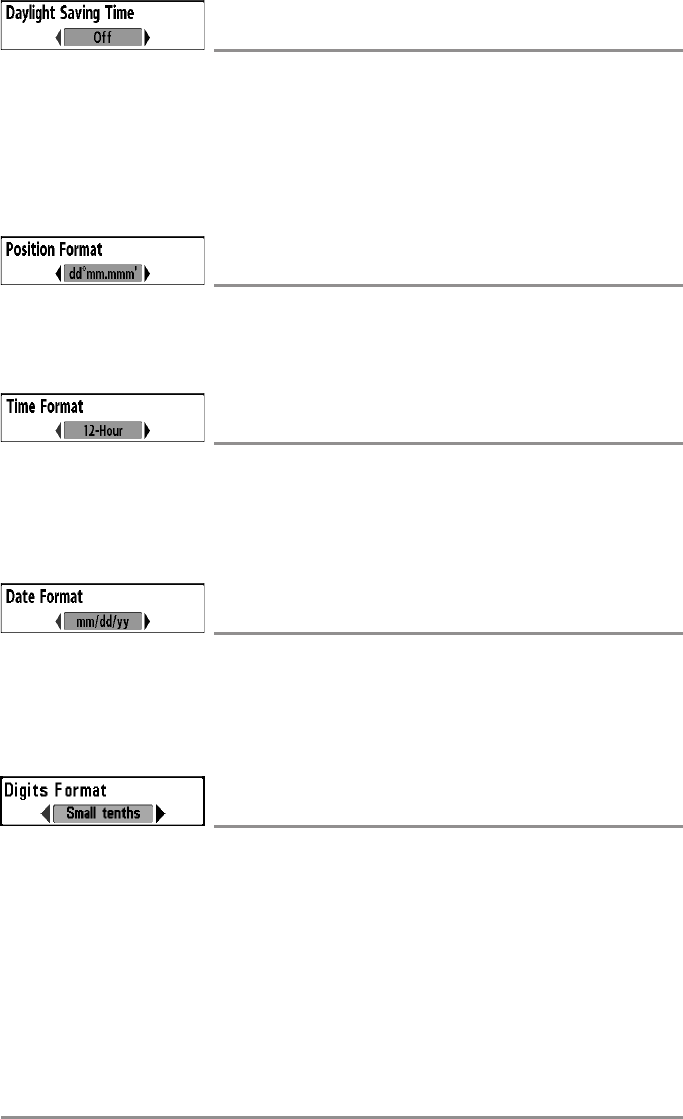
155 Setup Menu Tab
Daylight Saving Time
(Advanced)
Settings: Off, On; Default = Off
Daylight Saving Time adjusts the time display to account for local Daylight Saving Time when
Time+Date is selected as a Digital Readout (see Setup Menu Tab: Select Readouts).
Selecting On adds one hour to the time display adjusted for your local time zone. Selecting Off
leaves the time display as adjusted for your local time zone.
Position Format
(Advanced)
Settings: dd.ddddd°, dd°mm.mmm', or dd°mm'ss"; Default =
dd°mm.mmm'
Position Format selects the format of the latitude and longitude position display.
Time Format
(Advanced, International only)
Settings: 12-hour, 24-hour; Default = 12-hour
Time Format changes the time format used by the unit. Time Format selects a 12 hour or 24
hour format for the time of day displayed when Time + Date is selected as a Digital Readout
(see Setup Menu Tab: Select Readouts).
Date Format
(Advanced, International only)
Settings: mm/dd/yy, dd.mm.yy, yy.mm.dd; Default = mm/dd/yy
Date Format changes the date format used by the unit. Date Format selects the format for the
date display when Time + Date is selected as a Digital Readout (see Setup Menu Tab: Select
Readouts).
Digits Format
(Advanced)
Settings: Small tenths, Large tenths, No tenths, Default = Small tenths
Digits Format adds a tenth decimal place to readouts such as Temperature and Depth. The format
can be changed to small format, large format or no format.

156
Setup Menu Tab
NMEA Output
(Advanced)
Settings: Off, On; Default = Off
NMEA Output turns the NMEA* output on or off. NMEA Output should be turned On if you
connect the NMEA Output wires of the GPS Receiver cable to another NMEA-compatible
device, such as an autopilot.
*NMEA 0183 is a National Marine Electronics Association standard for data communication.
The following NMEA sentences are output:
DPT - Depth
MTW - Water Temperature
GLL - Lat/Lon Position
GGA - GPS Fix Data
RMC - Recommended Minimum Specific GNSS Data
VTG - Course Over Ground and Ground Speed
ZDA - Time and Date
When navigating, the following NMEA sentences are also output:
APB - Autopilot Sentence B
BWR - Bearing and Distance to Waypoint
RMB - Recommended Minimum Navigation Info
Sonar
Settings: Off, On, Default = On
Sonar deactivates Sonar and removes the Sonar Views from the view rotation.
Demonstration
Settings: Off, Visible; Default = Visible
Demonstration controls whether the Demonstration Mode is visible or off. The Demonstration
Mode appears on the screen if you don’t press any keys during the warning screen at power up.
Menu settings cannot be saved in Demonstration (see Power On the Control Head and
Start-Up Options Menu).
Video Out
(Advanced)
Settings: Domestic Models: Off, NTSC; International Models: NTSC, PAL,
PAL-M, Off; Default = Off
Video Out allows you to set the video format that will be sent to your remote monitor.
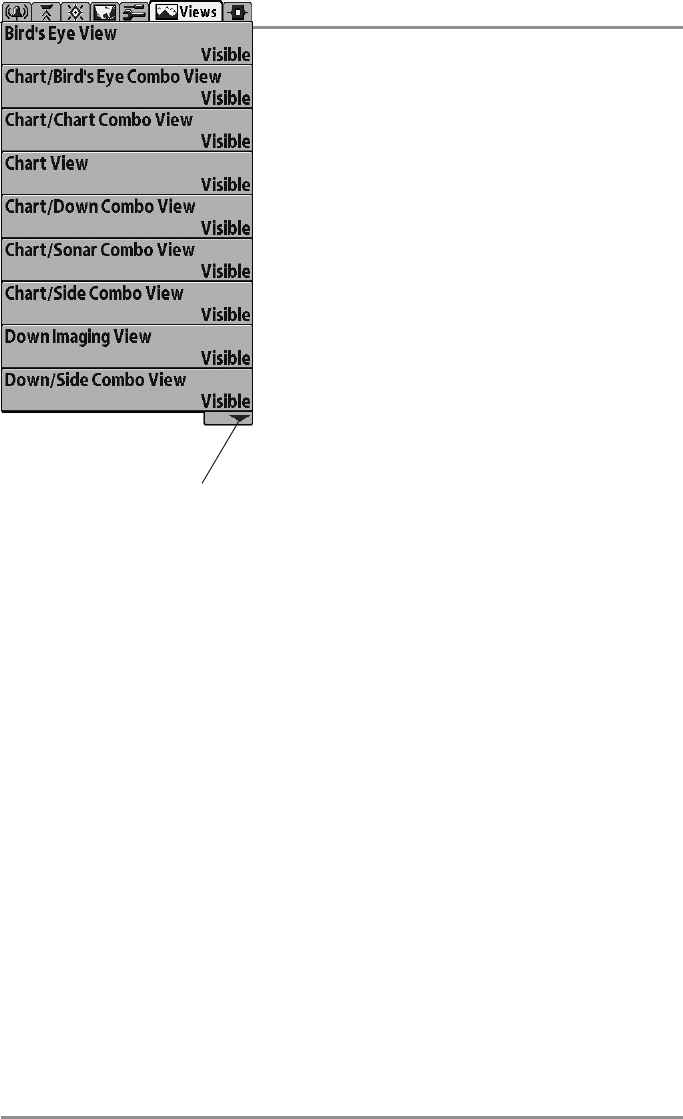
157 Views Menu Tab
Views Menu Tab
From any view, press the MENU key twice to access the
tabbed Main Menu, then press the RIGHT Cursor key until
the Views tab is selected.
This menu tab allows you to set the available views to
hidden or visible in the view rotation. The view will be
removed from the view rotation if it is set to Hidden and
will be displayed in the view rotation if it is set to Visible.
NOTE: See Views for more information.
1198c SI Views Menu
The down arrow indicates more menu
options. Press the DOWN Cursor key to
scroll through the full menu list.
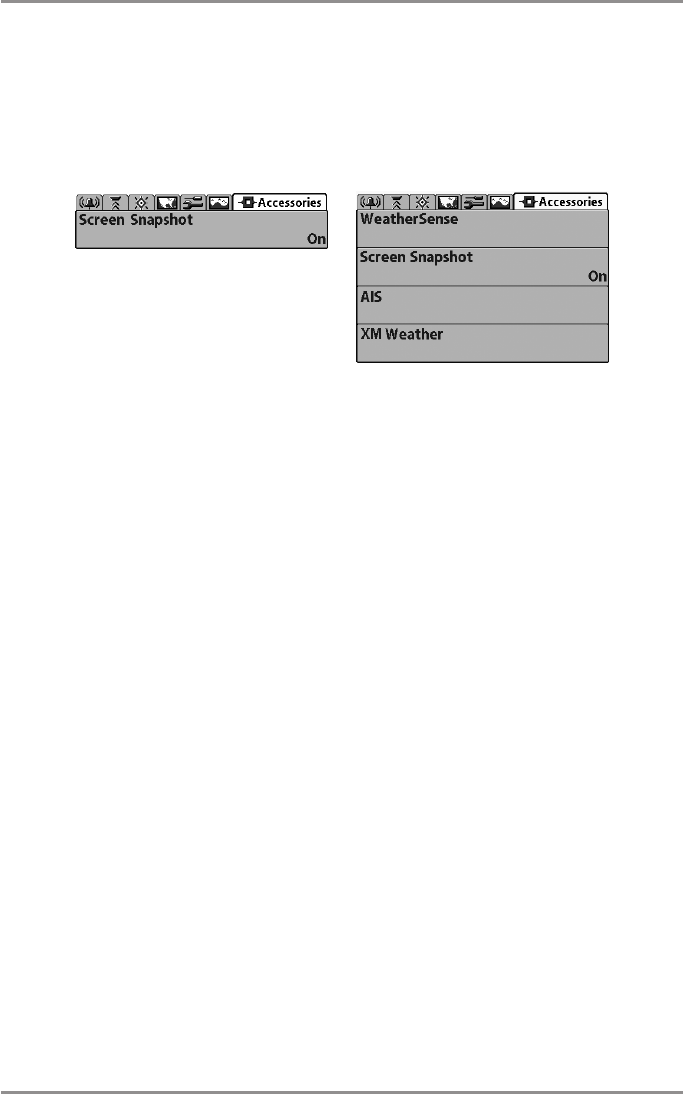
158
Accessories Menu Tab
Accessories Menu Tab
From any view, press the MENU key twice to access the Main Menu, then press the RIGHT cursor
key until the Accessories tab is selected.
Screen Snapshot will always appear under the Accessories tab. If you attach additional
accessories to the control head, the menu choices that support the accessory will be added
automatically. See the Operations Manual that comes with your accessory for detailed
information.
NOTE: Accessories to enable WeatherSense® , AIS, and XM WX® Weather require separate purchases.
Visit our Web site at humminbird.com or contact our Customer Resource Center at 1-800-633-1468
for details.
Accessories Menu
(no accessories attached)
Accessories Menu
(with accessories attached)
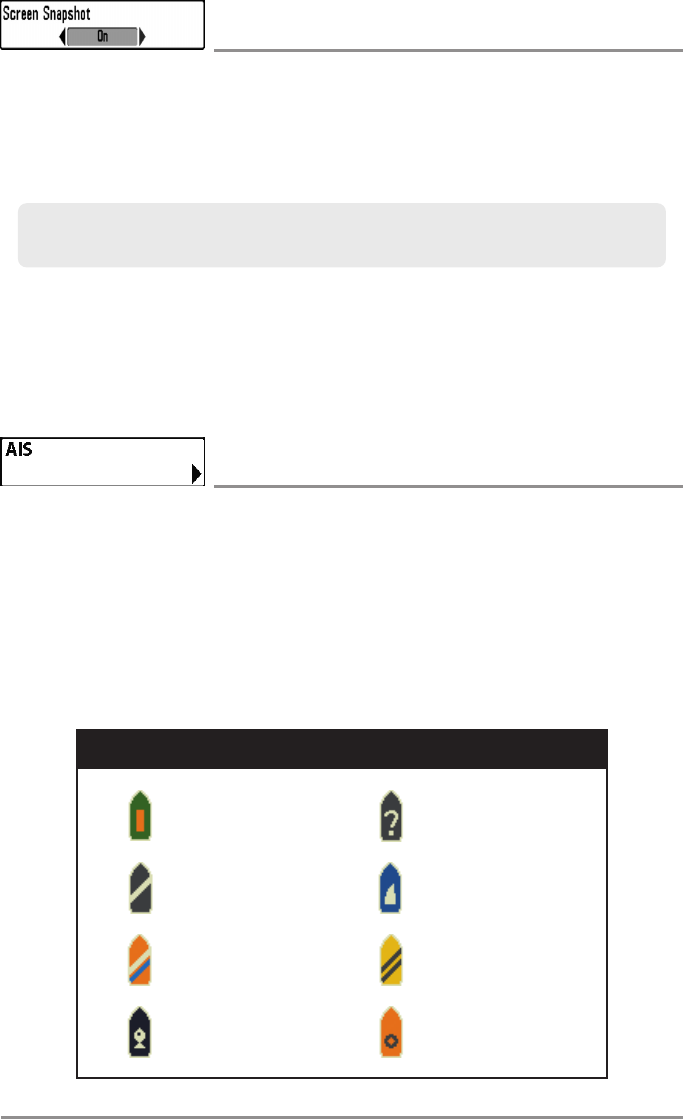
159 Accessories Menu Tab
Screen Snapshot
(optional-purchase SD Cards only)
Settings: Off, On; Default = Off
Screen Snapshot activates the screen snapshot function. When Screen Snapshot is enabled,
pressing the MARK key creates a saved screen snapshot on the optional-purchase SD card
installed in your unit’s card slot. All active menus, dialog boxes, warnings and messages are
captured and saved automatically.
NOTE: You must have an optional-purchase SD card installed for the Screen Snapshot feature to work.
NOTE: If you use your SD card in two different Fishfinder units that have different screen sizes, the
recordings made on one unit will still be present on the card, but they will be represented by the Unavailable
icon (circle with a slanted line through it) on the Snapshot and Recording View on the other unit.
AIS
(optional-purchase AIS equipment only)
Settings: Press the RIGHT Cursor key to activate.
Your Fishing system is compatible with AIS technology. This equipment must be purchased
separately and connected properly to the control head for AIS to be activated in your Fishing
System.
When an AIS is connected to the Fishing System, AIS will appear as a menu option in the
Accessories Menu Tab. AIS allows you to locate and monitor other vessels, or Targets, within
range of the VHF signal. The AIS then exchanges information with those targets, including
vessel identification, position, course, and speed.
NOTE: For more information, see Snapshot and Recording View and Snapshot and Recording
X-Press™ Menu.
Cargo Boat
Dredge Boat
Law Boat
Passenger Boat
Vessel Icons
Unidentified Boat
Sail Boat
Tow Boat
Tug Boat
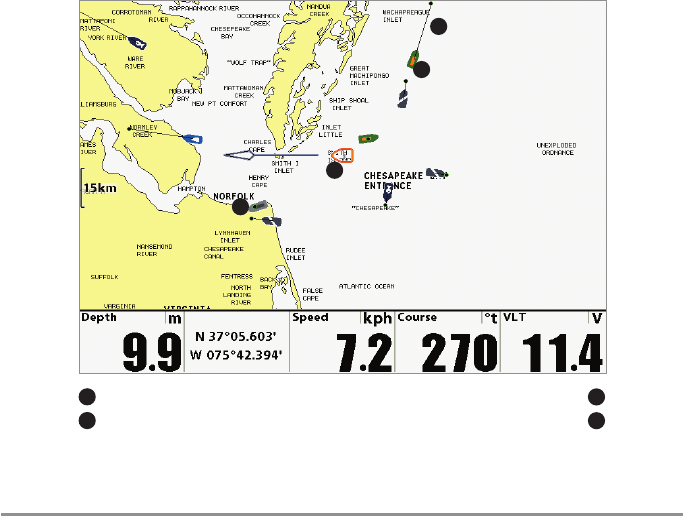
160
Accessories Menu Tab
As target information is received, the information is displayed in the Chart Views. In Bird’s Eye
View, only the target position is displayed.
•Vessel Icons identify the type of target.
•Alarm & Red Vessel Icon identify a target that has exceeded the CPA (Closest Point of
Approach) setting. The alarm sound and banner will display on the screen. Press any key
to stop the alarm, but the vessel icon will continue to display as red until it is out of the
CPA alarm zone.
•Available Targets: If the AIS has not received information from a target within 10
minutes, the target will turn gray. If information is not received after 15 minutes, the
target will disappear from the view. Also, if there are several targets on the view, and a
new target message is received, the oldest target will disappear from the view.
•MMSI Tag (Maritime Mobile Service Identity) will be displayed if it is available for
each target.
•Target Course Lines point in the direction of a vessel’s course. The length of the line can
be adjusted in the Target Course Line setting in the AIS Submenu.
•Target Details: Information about each target can be found in the Target List in the AIS
submenu. You can also use the 4-WAY Cursor Control key to move the active cursor onto
a vessel icon. Press the INFO key to view available information, including target name,
speed, course, latitude/longitude position, registration, call sign, and more.
•AIS Submenu allows you to control and view AIS information.
Chart View with AIS
Your Boat icon Target Course Line
13
Target (Vessel in the area) Gray Target (information unavailable)
24
1
2
4
3

161 Accessories Menu Tab
AIS Submenu: The AIS submenu allows you to track targets,
receive alerts when targets are within the distance you set, and
display targets in Chart Views. In Bird’s Eye View, only the position
will be displayed.
To change settings in the AIS Submenu:
Highlight AIS is in the Accessories MENU Tab, and press the RIGHT Cursor key to access the AIS
Submenu.
Tracking Target sets targets and related information to be visible (On) or hidden (Off) in
the Chart Views. In Bird’s Eye View, only target position will be displayed. (Settings: On,
Off; Default = On)
CPA (Closest Point of Approach) Limits sets how close a vessel can approach. The
amount can be set in nautical miles or time. When the vessel has traveled past the set
limit, the Vessel Icon will turn red in the view and an alarm will sound. Press any key to
turn off the alarm. Press the RIGHT Cursor key to open the dialog box.
CPA sets the closest point of approach, measured in nautical miles.
TCPA sets the closest point of approach, measured in time.
Target List shows active targets and related information that is available with each AIS
update. Press the RIGHT Cursor key to open the Target List.
Sort: The list is sorted by MMSI number (if available). Targets without an MMSI will
be shown at the bottom of the list.
Scroll: Use the UP or DOWN Cursor keys to scroll through the list and highlight
targets. Press and hold the DOWN Cursor key to scroll through all the targets on
the list quickly.
Target Highlight: Highlight a target on the Target List, and press the RIGHT Cursor
key. The Target List will close and the active cursor will go to the target you
highlighted. Press the EXIT key to remove the active cursor from the screen.
Target Course Line turns course lines off or sets the amount of time represented on the
target course line. The length of the course line indicates the last known ship speed,
while the direction of the arrow shows heading. (Settings: Off, 00:00 - 59:59; Default =
5:00)
MMSI Label (Maritime Mobile Service Identity) sets the MMSI label information to be
Visible or Hidden. (Settings: Visible, Hidden; Default = Visible)
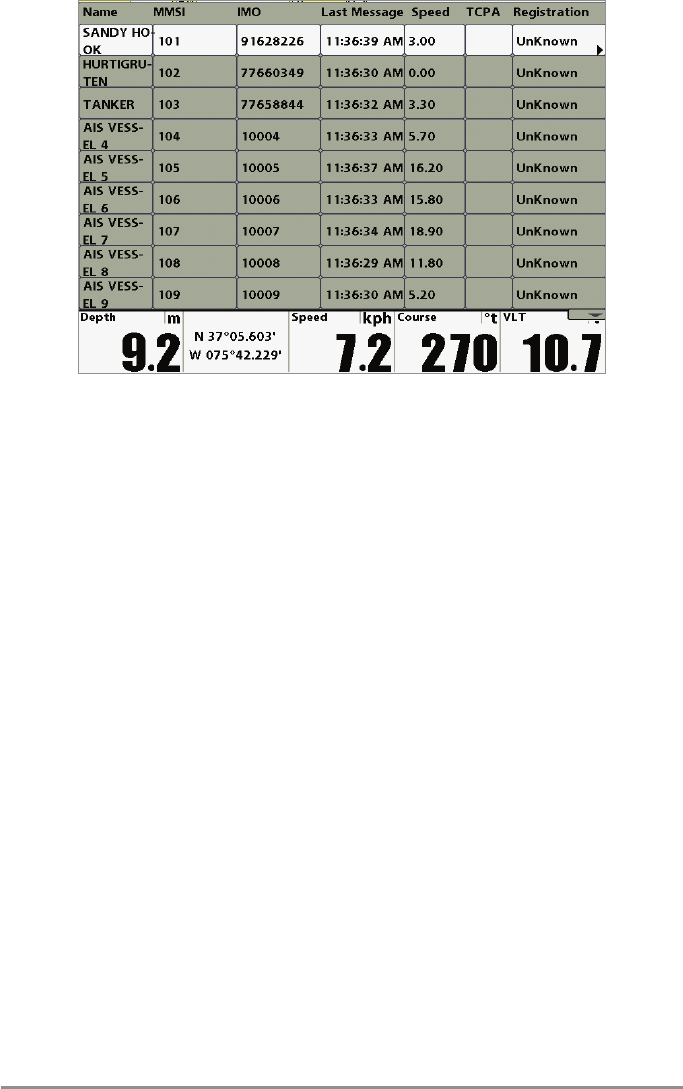
Accessories Menu Tab 162
AIS Target List

163 Troubleshooting
Troubleshooting
Before contacting the Humminbird® Customer Resource Center, please read the following
section. Taking the time to review these troubleshooting guidelines may allow you to solve a
performance problem yourself, and therefore avoid sending your unit back for repair.
1100 Series™ Doesn’t Power Up
If your 1100 Series™ doesn’t power up, use the Installation section of this manual for specific
confirmation details, making sure that:
• the power cable is properly connected to the 1100 Series™ control head,
• the power cable is wired correctly, with red to positive battery terminal and black to
negative terminal or ground
• the fuse is operational
• the battery voltage of the power connector is at least 10 Volts.
Correct any known problems, including removing corrosion from the battery terminals or wiring,
or actually replacing the battery if necessary.
1100 Series™ Defaults to Simulator with a Transducer Attached
A connected and functioning transducer will cause the newly-started 1100 Series™ to go into
Normal operating mode automatically. If, when you power up the 1100 Series™, it goes into
Simulator mode automatically, even though a transducer is already connected, this means that
the control head is not detecting the transducer. Perform the following troubleshooting tasks:
• Using the Installation section of this manual, check to make sure that the transducer
cable is securely connected to the 1100 Series™. Reconnect if necessary, and power up
the 1100 Series™ again to see if this fixes the problem.
• Replace the non-functioning transducer with a known good transducer if available and
power up the control head again.
• Check the transducer cable. Replace the transducer if the cable is damaged or corroded.

164
Troubleshooting
Display Problems
There are several main conditions or sources of possible interference that may cause problems
with the quality of the information displayed on the control head. Look in the following table for
some symptoms of display problems and possible solutions:
Problem Possible Cause
The control head loses
power at high speeds.
When the boat moves
at higher speeds, the
bottom disappears or
suddenly weakens, or
the display contains
gaps.
There are no fish
detected, even when
you know they are in
the water under the
boat, or sonar readings
seem weak or faulty.
If the power output of your boat’s engine is unregulated, the
control head may be protecting itself using its over-voltage
protection feature. Make sure the input voltage does not
exceed 20 Volts.
The transducer position may need to be adjusted. A mix of air
and water flowing around the transducer (cavitation) may be
interfering with the interpretation of sonar data. See your
Installation Guide for suggestions on adjusting the transducer
position.
Electrical noise from the boat’s engine may be interfering
with sonar reception. See Finding the Cause of Noise for
more information.
Sonar readings may be affected if the transducer is not
positioned correctly (i.e. mounted at an angle, not straight
down), or there is some kind of mechanical interference,
either because it is mounted inside a hull that is too thick for
proper sonar transmission, the bond between the transducer
and the hull is not airtight, or because the transducer is dirty.
Check with your Installation Guide for guidance on re-
positioning the transducer, and make sure the transducer is
clean.
Low battery voltage may be affecting the power of signal
transmission.
Electrical noise from the boats engine may be interfering with
sonar reception. See Finding the Cause of Noise for more
information.

165 Troubleshooting
Finding the Cause of Noise
Electrical noise usually affects the display with many black dots at high speeds, and high
sensitivity readings. One or more of the following sources can cause noise or interference:
Possible Source of Noise Isolation
Other electronic devices
The boat’s engine
Cavitation from the boat’s
propeller
Turn off any nearby electronic devices to see if the
problem goes away, then turn them on one at a time to
see if the noise re-appears.
To determine whether the boat’s engine is the source
of the noise, increase the RPMs while the boat is in
neutral and stationary to see if the noise increases
proportionately; if noise appears when you rev the
engine, the problem could be the spark plugs,
alternator, or tachometer wiring. Replace the spark
plugs with resistor plugs, install an alternator filter, or
route the control head power and transducer cables
away from the engine wiring.
Turbulence created by the propeller can cause noise;
make sure the transducer is mounted at least 15” (38 cm)
from the propeller, and that the water flows smoothly
over the face of the transducer at all times.

Warranty & Service Policy 166
1-Year Limited Warranty
We warrant the original retail purchaser that products made by Humminbird® have been
manufactured free from defects in materials and workmanship. This warranty is effective for one
year from the date of original retail purchase. Humminbird® products found to be defective and
covered by this warranty will be repaired or replaced free of charge at Humminbird’s option and
returned to the customer freight prepaid. Humminbird’s sole responsibility under this warranty
is limited to the repair or replacement of a product that has been deemed defective by
Humminbird®. Humminbird® is not responsible for charges connected with the removal of such
product or reinstallation of replaced or repaired parts.
This warranty does not apply to a product that has been:
• Improperly installed;
• Used in an installation other than that recommended in the product installation and
operation instructions;
• Damaged or has failed because of an accident or abnormal operation;
• Repaired or modified by entities other than Humminbird®.
Please retain your original receipt as a proof of the purchase date. This will be required for in-
warranty service.
THIS WARRANTY IS EXPRESSLY IN LIEU OF ANY OTHER WARRANTIES, OBLIGATIONS OR
LIABILITIES ON THE PART OF HUMMINBIRD® AND WILL BE THE CUSTOMER'S EXCLUSIVE
REMEDY, EXCEPT FOR ANY APPLICABLE IMPLIED WARRANTIES UNDER STATE LAW WHICH
ARE HEREBY LIMITED IN DURATION TO ONE YEAR FROM THE DATE OF ORIGINAL PURCHASE.
IN NO EVENT WILL HUMMINBIRD® BE LIABLE FOR ANY INCIDENTAL OR CONSEQUENTIAL
DAMAGES FOR BREACH OF ANY EXPRESS OR IMPLIED WARRANTY RELATING TO THE
PRODUCTS.
Some states do not allow limitations on an implied warranty, or the exclusion of incidental or
consequential damages, so the above exclusions may not apply to you. You may also have other
rights, which vary from state to state.

167 Warranty & Service Policy
Humminbird® Service Policy
Even though you'll probably never need to take advantage of our incredible service policy, it's
good to know that we back our products this confidently. We do it because you deserve the
best. We will make every effort to repair your unit within three business days from the receipt
of your unit at our factory. This does not include shipping time to and from our factory. Units
received on Friday are typically shipped by the following Wednesday, units received Monday are
typically shipped by Thursday, etc.
All repair work is performed by factory-trained technicians to meet exacting factory
specifications. Factory-serviced units go through the same rigorous testing and quality control
inspections as new production units.
After the original warranty period, a standard flat rate service charge will be assessed for each
repair (physical damage and missing parts are not included).
Any repairs made after the original warranty will be warranted for an additional 90 days after
service has been performed by our factory technicians. You can contact our Customer Resource
Center or visit our Web site to verify the flat rate repair fee for your product (visit the Product
Support section):
http://www.humminbird.com
We reserve the right to deem any product unserviceable when replacement parts are no longer
available or impossible to obtain. This Service Policy is valid in the United States only. This applies
only to Humminbird® products returned to our factory in Eufaula, Alabama. This Service Policy is
subject to change without notice.
DOMESTIC (USA) CUSTOMERS:
PLEASE DO NOT RETURN THIS PRODUCT TO STORE FOR SERVICE
For all technical issues please call 1-800-633-1468
or visit www.humminbird.com, click SUPPORT.
Please reference product serial number and model number when contacting Humminbird®.

Warranty & Service Policy 168
Returning Your Unit for Service
Before sending your unit in for repair, please contact the factory, either by phone or by email, to
obtain a Repair Authorization Number for your unit.
NOTE: Please do not return your Humminbird® product to the store for service.
Please have your product model name and serial number available before calling the factory. If
you contact the factory by e-mail, please include your product model name and serial number
in the e-mail, and use Request for Repair Authorization Number for your e-mail subject header.
You should include your Repair Authorization Number in all subsequent communications about
your unit.
For IN-WARRANTY service, complete the following steps:
• Obtain a Repair Authorization Number from the Humminbird® Customer Resource
Center.
• Tag product with your name, street address, phone number and your assigned Repair
Authorization Number.
• Include a brief written description of the problem.
• Include a copy of your receipt (to show proof and date of purchase).
• Return product freight prepaid to Humminbird®, using an insured carrier with delivery
confirmation.
For OUT-OF-WARRANTY service, complete the following steps:
• Obtain a Repair Authorization Number from the Humminbird® Customer Resource
Center.
• Include payment in the form of credit card number and expiration date, or a money
order. Please do not send cash.
• Tag product with your name, street address, phone number and your assigned Repair
Authorization Number.
• Include a brief written description of the problem.
• Return product freight prepaid to Humminbird®, using an insured carrier with delivery
confirmation.

169 Accessories
1100 Series™ Fishing System Accessories
Accessories customize the 1100 Series™ to your needs and enable you to stay on the edge of
new technology. When an accessory is connected to the 1100 Series™, additional menus and
readouts are added automatically to the Main Menu System. Accessories available today that
are supported by your 1100 Series™ include:
QuadraBeam PLUS™ transducer: purchase and connect the QuadraBeam PLUS™ transducer
to your 1100 Series™ Fishing System to access specialized QuadraBeam PLUS™ functions such
as two 45° fan-shaped 35° 455 kHz Side Structure locating sonar beams to spot fish, bait and
structure to the left and right of the boat over an area of the bottom that’s always equal to twice
your depth, for a continuous 90° of uninterrupted side to side coverage to 160 feet.
WeatherSense® Fishing Condition Monitor: purchase and plug in the WeatherSense®
accessory to your 1100 Series™ to obtain barometric pressure readouts and trend data in real
time.
GPS Connection Cable: purchase the GPS Connection Cable in order to connect a handheld or
other NMEA* GPS-compatible device that you may already own to your 1100 Series™.
*NMEA 0183 is a National Marine Electronics Association standard for data communication.
Universal Sonar 2: Your 1100 Series™ Fishing System supports Universal Sonar 2, a state-of-
the-art, integrated and protected transducer that is built into the lower unit of Minnkota trolling
motors. With Universal Sonar 2, all wiring is concealed inside the indestructible composite
shaft—out of sight and out of harm’s way, with no clamps, ties, or exposed wires. Universal
Sonar 2 features new temperature sensing and the performance of DualBeam PLUS™
technology (available with all Humminbird® DualBeam PLUS™ models). An expanded view and
greater bottom detail gives you a totally new perspective of the water below, along with optimal
sonar performance to help you find fish.
Downriggers are the key to catching fish you otherwise couldn’t even touch. And now
Humminbird’s CannonLink™ Downrigger Controller makes operation of up to six Cannon®Mag
20 DT or Mag 20 DT/HS downriggers incredibly easy. Using the controls on your Fishing System,
deploy or retrieve downriggers, hold a specific distance off the bottom, cycle downriggers
between two depths, and adjust the Positive Ion Control. Even see temperature and water
clarity at depth and speed at the ball right on-screen when using the Cannon®Speed-n-Temp.
You’ll never be shorthanded again, just make adjustments from the helm, while your mate rigs
the lines and brings in the fish!
With the new InterLink™ Network Connection, you can now share GPS position, waypoints,
routes and your current track between two Humminbird® Fishing Systems in real time. Mark a
waypoint at the console, and it’s instantly available on the second unit. No matter where you’re
at on the boat, you’ll have access to your critical fishing and navigation information. Plus, daisy
chain InterLink™ with other System Modules and you’ll have a network that lets you share
digital data around the boat. It’s a simply, clearly, better networking solution!

Accessories 170
Humminbird’s AS WX 1 weather accessory provides anglers with access to continuously-
updating weather conditions. The AS WX 1 uses sophisticated technology to track nationwide
weather information for more than 20 different weather conditions, including precipitation,
wind, lightning, and full forecasts for more than 150 cities across the country, then scales and
customizes this detail to the angler’s specific location. See the AS WX 1 accessory guide for
details.
PC Connect Cable: Purchase the PC Connect Cable to connect the Fishing System to a PC in
order to upload product software updates and new features obtained from humminbird.com.
This accessory requires the MSWindows-compatible HumminbirdPC™ software downloaded
from our Web site to your PC in order to communicate with the Fishing System.
Be sure to check out our Web site humminbird.com for additional new and exciting accessories
to grow your 1100 Series™.
NOTE: Each accessory requires a separate purchase. You can visit our Web site at humminbird.com or
contact our Customer Resource Center at 1-800-633-1468 for additional details.

171 Specifications
Specifications (1158c)
Depth Capability .........................................................1500ft(500m)
Power Output
. . . . . . . . . . . . . . . . . . . . . . . . . . . . . . . . . . .500 Watts (RMS); 4000 Watts (Peak-To-Peak)
Operating Frequency
DualBeam PLUS™:................................................200kHzand83kHz
Area of Coverage
DualBeam PLUS™: . . . . . . . . . . . . . . . . . . . 60° @ -10 dB in 83 kHz and 20° @ -10 dB in 200 kHz
Target Separation ...............................................21/2Inches(63.5mm)
Power Requirement .......................................................12-20VDC
LCD .............................................600Vx800H;10.4”DiagonalColorTFT
Current Draw ..................................................................1.4A
Transducer ...............................................................XNT920T
Transducer Cable Length ...................................................20ft(6m)
IPX Rating . . . . . . . . . . . . . . . . IP67 Waterproof/Submersible @ 1m for 30 minutes and dust tight
NOTE: Product specifications and features are subject to change without notice.
NOTE: Humminbird® verifies maximum stated depth in saltwater conditions, however actual depth
performance may vary due to transducer installation, water type, thermal layers, bottom composition
and slope.

172
Specifications
Specifications (1158c DI)
Depth Capability ...........................................
250 ft (76 m) Down Imaging™,
600 ft (183 m) traditional sonar
Power Output
. . . . . . . . . . . . . . . . . . . . . . . . . . . . . . . . . . .500 Watts (RMS); 4000 Watts (Peak-To-Peak)
Operating Frequency ........................................XNT9DIT:400kHz,800kHz
200 kHz and 455 kHz (traditional sonar)
Area of Coverage
XNT 9 DI T: . . . . . . . . . . . . . . . . . . . . . . . . . . . . 75° @ -10 dB in 455 kHz, 45° @ -10 dB in 800 kHz
XNT 9 DI T (traditional sonar): . . . . . . . . . . . . . . . . . . . . . . . . . . . . . . . . . . . 25° @ -10 db in 200 kHz
16° z@ -10 db in 455 kHz
Target Separation ...............................................21/2Inches(63.5mm)
Power Requirement ........................................................10-20VDC
LCD .............................................600Vx800H;10.4”DiagonalColorTFT
Current Draw ..................................................................1.4A
Transducer ................................................................XNT9DIT
Transducer Cable Length ....................................................20ft(6m)
IPX Rating . . . . . . . . . . . . . . . . IP67 Waterproof/Submersible @ 1m for 30 minutes and dust tight
NOTE: Product specifications and features are subject to change without notice.
NOTE: Humminbird® verifies maximum stated depth in saltwater conditions, however actual depth
performance may vary due to transducer installation, water type, thermal layers, bottom composition
and slope.

173 Specifications
Specifications (1198c SI)
Depth Capability .........................................................1500ft(500m)
Power Output
. . . . . . . . . . . . . . . . . . . . . . . . . . . . . . . . . . .500 Watts (RMS); 4000 Watts (Peak-To-Peak)
Operating Frequency
Side Imaging®: . . . . . . . . . . . . . . . . . . . . . . . . . . . . . . . . . . . . 200 kHz and 83 kHz, 455 kHz, 800 kHz
Area of Coverage
Side Imaging®: . . . . . . . . . . . . . . . . . . . . . . . . . . . .455 kHz: (2) 86° @ -10 db (180° Total Coverage)
800 kHz: (2) 55° @ -10 db (130° Total Coverage)
Target Separation ...............................................21/2Inches(63.5mm)
Power Requirement ........................................................12-20VDC
LCD .............................................600Vx800H;10.4”DiagonalColorTFT
Current Draw ..................................................................1.4A
Transducer: .........................................................XHS9HDSI180T
Transducer Cable Length ....................................................20ft(6m)
IPX Rating . . . . . . . . . . . . . . . . IP67 Waterproof/Submersible @ 1m for 30 minutes and dust tight
NOTE: Product specifications and features are subject to change without notice.
NOTE: Humminbird® verifies maximum stated depth in saltwater conditions, however actual depth
performance may vary due to transducer installation, water type, thermal layers, bottom composition
and slope.

Specifications 174
ENVIRONMENTAL COMPLIANCE STATEMENT: It is the intention of Johnson Outdoors Marine
Electronics, Inc. to be a responsible corporate citizen, operating in compliance with known and applicable
environmental regulations, and a good neighbor in the communities where we make or sell our products.
WEEE DIRECTIVE: EU Directive 2002/96/EC “Waste of Electrical and Electronic Equipment Directive
(WEEE)” impacts most distributors, sellers, and manufacturers of consumer electronics in the European
Union. The WEEE Directive requires the producer of consumer electronics to take responsibility for the
management of waste from their products to achieve environmentally responsible disposal during the
product life cycle.
WEEE compliance may not be required in your location for electrical & electronic equipment (EEE), nor may
it be required for EEE designed and intended as fixed or temporary installation in transportation vehicles
such as automobiles, aircraft, and boats. In some European Union member states, these vehicles are
considered outside of the scope of the Directive, and EEE for those applications can be considered
excluded from the WEEE Directive requirement.
This symbol (WEEE wheelie bin) on product indicates the product must not be disposed of with
other household refuse. It must be disposed of and collected for recycling and recovery of waste
EEE. Johnson Outdoors Marine Electronics, Inc. will mark all EEE products in accordance with the
WEEE Directive. It is our goal to comply in the collection, treatment, recovery, and environmentally
sound disposal of those products; however, these requirements do vary within European Union member
states. For more information about where you should dispose of your waste equipment for recycling and
recovery and/or your European Union member state requirements, please contact your dealer or distributor
from which your product was purchased.
ROHS STATEMENT: Product designed and intended as a fixed installation or part of a system in a vessel
may be considered beyond the scope of Directive 2002/95/EC of the European Parliament and of the
Council of 27 January 2003 on the restriction of the use of certain hazardous substances in electrical and
electronic equipment.
NOTE: This product uses the Linux operating system. This portion of the software is free software; you can
redistribute it and/or modify it under the terms of the GNU General Public License as published by the Free
Software Foundation; either version 2 of the License, or (at your option) any later version. This program is
distributed in the hope that it will be useful, but WITHOUT ANY WARRANTY; without even the implied
warranty of MERCHANTABILITY or FITNESS FOR A PARTICULAR PURPOSE. See the GNU General Public
License for more details.
You may receive a copy of the GNU General Public License along with this program; if not, write to the Free
Software Foundation, Inc., 51 Franklin Street, Fifth Floor, Boston, MA 02110-1301 USA.
To receive a free copy of the Linux software used in this system, please send a letter of request* with the
following information:
Name (First & Last)
Phone Number
E-mail Address
Mailing Address
Humminbird®serial number
(Your Humminbird ®unit must be registered at humminbird.com/support/productregistration.aspx.)
Shipping and Handling: We can only accept requests that include a money order in the amount of $9.99 to cover
shipping and handling. Please allow 4-6 weeks for processing.
Send the letter of request* to the following address:
Linux Software Request
Humminbird
678 Humminbird Lane
Eufaula, AL 36027

175 Specifications
*NOTE: A copy of the Linux operating system is not required to upgrade your fishing system. The Humminbird®
application software and control head include a separate service warranty. Please see humminbird.com and
the Warranty section of this manual for details.
Copyright © 2000 Caldera Systems, Inc
All rights reserved.
Redistribution and use in source and binary forms, with or without modification, are permitted provided that the
following conditions are met:
•Redistributions of source code must retain the above copyright notice, this list of conditions and the
following disclaimer.
•Redistributions in binary form must reproduce the above copyright notice, this list of conditions and the
following disclaimer in the documentation and/or other materials provided with the distribution.
•Neither the name of Caldera Systems nor the names of its contributors may be used to endorse or
promote products derived from this software without specific prior written permission.
THIS SOFTWARE IS PROVIDED BY THE COPYRIGHT HOLDERS AND CONTRIBUTORS ``AS IS'' AND ANY EXPRESS
OR IMPLIED WARRANTIES, INCLUDING, BUT NOT LIMITED TO, THE IMPLIED WARRANTIES OF
MERCHANTABILITY AND FITNESS FOR A PARTICULAR PURPOSE ARE DISCLAIMED. IN NO EVENT SHALL THE
CALDERA SYSTEMS OR CONTRIBUTORS BE LIABLE FOR ANY DIRECT, INDIRECT, INCIDENTAL, SPECIAL,
EXEMPLARY, OR CONSEQUENTIAL DAMAGES (INCLUDING, BUT NOT LIMITED TO, PROCUREMENT OF
SUBSTITUTE GOODS OR SERVICES; LOSS OF USE, DATA, OR PROFITS; OR BUSINESS INTERRUPTION) HOWEVER
CAUSED AND ON ANY THEORY OF LIABILITY, WHETHER IN CONTRACT, STRICT LIABILITY, OR TORT (INCLUDING
NEGLIGENCE OR OTHERWISE) ARISING IN ANY WAY OUT OF THE USE OF THIS SOFTWARE, EVEN IF ADVISED
OF THE POSSIBILITY OF SUCH DAMAGE.

Glossary - Sonar 176
Glossary Sonar
Beam (Sonar Beam) The wide, cone-shaped projection of sound waves formed as sound travels
underwater. See Cone Angle.
Bottom Contour The profile of the bottom graphed to the display as the depth changes.
Bottom Hardness The density (or composition) of the bottom. Varying levels of hardness can be
determined by interpreting the “thickness“ of the main sonar return. Hard returns appear thin and black,
softer returns appear thicker and less black. It is important to note that a sonar return from a sloping bottom
can have the appearance of a softer bottom.
Cavitation The effect of air bubbles created as the propeller rotates and the boat moves through the water.
Cone Angle The angular measurement of the sonar beam at a specific dB down point (i.e. -10 dB). See dB
Down Point.
Dead Zone The area of the sonar beam that receives the sonar signal after the main bottom return. Fish
and other objects close to the bottom that fall within the dead zone will probably not be visible in the sonar
beam. Precision sonar beams, such as the Humminbird® 20° beam, have a smaller dead zone than wider
sonar beams.
Decibel The measurement for sound pressure level, or “intensity”of the sonar return. See dB Down Point.
dB Down Point The standard decibel level at which the sonar cone angle is measured, and is written as
“@ -10 dB” or “@ -3 dB“. Measurements at smaller down points (bigger negative numbers) indicate that
the less intensive sonar signals are being used for the measurement.
Display, FSTN (Film Super-Twist Nematic) FSTN is a monochrome display technology characterized by
black, high-contrast pixels. All monochrome fixed mount Humminbird® products use FSTN technology.
Frequency A measure of the number of sound wave cycles per second of a sound impulse transmitted
underwater. A typical frequency for fishfinders is 200 kHz, which offers a good balance of performance
under many conditions. Lower frequencies, such as 50 kHz, are capable of penetrating to greater depths, but
with less resolution. Higher frequencies, such as 455 kHz, offer greater resolution, but are limited in depth
performance. Humminbird® uses a variety of frequencies that are optimized for specific applications.
Grayscale The use of varying shades of gray to represent the strength of the sonar signal on the display.
Traditionally, the strongest sonar signals are represented in black, and progressively weaker signals are
represented in progressively lighter shades of gray.
Noise The unintentional, external sound waves that interfere with the optimal operation of sonar. Noise
appears as random “dots“ on the display and is caused by a variety of sources. Many Humminbird® products
have a Noise Filter menu setting that allows the user to clear the screen of noise that is difficult to eliminate
(also, see Troubleshooting).
Pixels The “picture elements“, or small square blocks, that make up the image on the LCD. Measured as a
vertical by horizontal number (i.e. 640V x 320H), this key specification typically indicates the quality of
resolution. In fishfinders, the total resolution (vertical multiplied by horizontal) is often less important than
the “Vertical Pixel“ resolution because a greater number of vertical pixels provide finer resolution of targets
detected by sonar. Sonar information on the horizontal axis can vary greatly, depending on boat speed and
the Chart Speed setting.

177 Glossary - Sonar
Glossary Sonar
Power Output The amount of sound energy emitted into the water by the transducer’s transmitter. Power
output is measured using either RMS (Root Mean Square) or P-T-P (Peak-to-Peak) measurement systems.
Either method is acceptable, but it is important when comparing power outputs, to make sure that the same
measurement system is being used for both outputs, because P-T-P numbers are 8 times higher than RMS
numbers. Greater power output allows the sonar signal to penetrate through weeds and thermoclines, reach
deeper depths and operate more effectively in noisy environments, such as when the boat is running at high
speed.
Pulse Width (Pulse Length) The length of time that a sonar sound burst is transmitted into the water.
Shorter pulse widths provide better target separation, but cannot travel to great depths. Longer pulse widths
provide better depth penetration, but result in poorer target separation. Humminbird® varies pulse width
based on depth to optimize both target separation and depth performance. See Target Separation.
Second Return Describes the appearance of a second sonar return below the primary sonar return (bottom
contour) at exactly twice the true depth. The second return is caused by the same sonar energy bouncing
off the bottom once, rebounding to the water surface and then traveling back down to the bottom to be
reflected again. Second returns are more common in shallow water and over hard bottoms; it is possible to
see a third sonar return under some circumstances. The second return provides useful information to help
determine bottom hardness, as areas with harder bottoms will generally create a second return. The second
return can be used as a guide to set Sensitivity when in shallower water.
SONAR (SOund and NAvigation Ranging) Sonar technology uses precision sound bursts transmitted
underwater to determine the distance and other attributes of objects in the water. Distance can be determined
because the speed of sound in water is constant, and the time for the signal to return is measured. Sound also
travels very quickly underwater, making sonar a responsive, cost-effective tool. Sonar is the basic technology
behind all recreational and commercial fishfinding and depthfinding devices.
Sonar Update Rate The number of times per second that the transducer’s transmitter/receiver sends and
receives sonar signals. A very fast sonar update rate collects more information and provides a more detailed
image of the bottom, fish, and structure. Many Humminbird® units operate at up to 40 times per second
when in single frequency operation. Due to the limitation of the speed of sound in water, the update rate
begins to slow as depth increases to deeper than 50 feet. In very shallow water (less than 10 feet), however,
update rates as much as 60 times per second can be achieved.
Speed The rate at which the boat moves through the water. Boat speed can be measured as Speed Over
Ground or Speed Through Water. Speed Over Ground is provided by GPS, and is the measurement of the
boats progress across a given distance. Speed Through Water is provided by a speed paddlewheel, and is
the measurement of the flow past the boat, which may vary depending on current speed and direction.
Speed Through Water is most critical for anglers using downriggers, as it impacts the running depth of the
down riggers. Speed Over Ground is optimal for navigation, as accurate destination times can be derived
from this measurement. Humminbird® products allow for input and display of both sources.
Structure A general term for objects on the bottom that present a discontinuity and are a likely attractor
for fish. This includes bottom contour features (drop-offs, humps, and holes), standing structure (stumps,
timbers, brush piles), and a wide range of other potential objects (sunken boats, reefs).
Surface Clutter A phenomenon where sonar returns are reflected off of tiny objects near the surface of
the water, including algae and even air bubbles. Typically, saltwater environments have significantly greater
surface clutter than freshwater due to continuous wind and wave action that causes aeration at the surface.

Glossary - Sonar 178
Glossary Sonar
Target Separation The measurement of minimum distance that a fishfinder needs to be able to recognize
two very close objects as two distinct targets (i.e. two fish hanging very close, or a fish hanging very close
to structure). Humminbird® fishfinders provide a very good 2 1/2 inches of target separation in shallower
than 100 feet of depth. Target separation decreases as depth increases due to the need for longer Pulse
Width to achieve greater depth. See Pulse Width.
Thermoclines Water layer(s) of distinctly different temperatures that create a sonar reflection due to the
density of the differing water temperatures. Typically a thermocline will appear as a continuous band across
the display at some distance above the bottom contour. Thermoclines are of interest to anglers because fish
will suspend above or below the thermocline as they seek the optimum temperature and oxygen levels.
Time Variable Gain (TVG) A processing step applied to the sonar return to “normalize“ the data so that
objects of equal size (i.e. fish) appear to be the same size, even if they are separated by a good distance.
Transducer The transducer is part of the sonar system, which mounts on the boat and is in contact with
the water, that converts the electrical energy from the transmitter into sound energy, and that forms the
sonar beam in turn. Internally, the transducer consists of one or more piezo electric disks that expand by very
minute amounts to create the sound wave. This element also works in reverse, converting the returned
sound energy back into an electrical signal that the receiver interprets. See SONAR.
Zoom A feature that focuses on a smaller area of the bottom to provide enhanced resolution. With
enhanced resolution, the angler can more easily see fish hanging in structure or multiple fish hanging close
together.
Zoom, Bottom Lock Bottom Lock Zoom is a feature that focuses on a smaller area just above the bottom
to provide enhanced resolution. Unlike regular zoom, it continuously graphs the bottom at a constant point
on the display regardless of changes in depth. This “flattens“ out the bottom contour, but is effective at
showing fish on or near the bottom, and is preferred by many saltwater anglers.

179 Glossary - GPS & Navigation
Glossary GPS & Navigation
Acquisition Time The length of time that a GPS receiver typically takes to determine a position from at
least three satellites. Humminbird® GPS receivers provide very fast acquisition times (under one minute),
permitting users to get out on the water faster.
Altitude The height measurement above sea level. Altitude is a measurement that can be provided by GPS.
Bearing (BRG) The direction to a destination waypoint measured in degrees from North (i.e. 321°, where
000° is North, 090° East, 180° is South, 270° is West).
Chartplotter A navigation device that shows Present Position on a Map, along with Tracks, Waypoints, and
Routes. All Chartplotters are also considered Trackplotters.
Cold Start The procedure that a GPS receiver must perform when it does not have historical information
regarding its current location. This procedure typically lasts for several minutes, and may be experienced
upon first power up of the receiver, or if the receiver has been moved a great distance.
Course Over Ground (COG) The current direction the boat is traveling measured in degrees from North
(i.e. 321°, where 000° is North, 090° East, 180° is South, 270° is West). When the Course Over Ground is
equal to Bearing, the boat is said to be “On Course” and will arrive at the destination in the most efficient
manner. COG is often confused with Heading. See Heading.
Cross Track Error (XTE) The straight-line distance of the boat from the intended Track. XTE measures how
far the boat is off course and also triggers the Off Course Alarm. See Track.
Differential GPS (DGPS) A system used to improve the position accuracy of the Department of Defense
GPS through the use of secondary “correction signals” broadcast from ground stations around the coastal
United States and on some inland waterways. These correction signals are provided by the USCG and
received by an auxiliary Differential Beacon Receiver (DBR) that connects to the GPS receiver. The advent of
WAAS has largely negated the need for the added expense of a DBR in the United States.
Distance To Go The straight-line distance between Present Position and the Destination Waypoint. DTG
and SOG (Speed Over Ground) are used to calculate Time To Go. See Time to Go and Speed Over Ground.
Estimated Position Error (EPE) A calculation that indicates the potential position inaccuracy the user
may experience due to a variety of GPS factors which include satellite position in the sky, signal strength,
and others factors.
Fix Type Indicates whether the GPS receiver is providing 2D fix or 3D fix. A 2D fix requires only three
satellites and provides only latitude and longitude. A 3D fix requires four or more satellites, and provides
latitude, longitude, and altitude.
GPS (Global Positioning System) GPS provides accurate position (latitude, longitude, altitude)
information virtually anywhere on the earth through satellite technology and personal receivers on the
ground. See How GPS Works.
Heading The direction the boat is pointing and is measured in degrees (i.e. 321°, where 000° is North, 090°
East, 180° is South, 270° is West). Due to wind and waves, the boat is often traveling in a slightly different
direction than it is heading, and therefore Heading is often confused with Course Over Ground. See Course
Over Ground.
Map Datum Refers to a particular survey of the earth’s surface that was referenced when creating a chart
(i.e. WGS84). It is important to select the correct Map Datum setting in your fishfinder when comparing GPS
position to a paper chart to avoid slight position inaccuracies. Almost all electronic charts use the WGS84
Map Datum and therefore, they do not require setting changes.

Glossary - GPS & Navigation 180
Glossary GPS & Navigation
MMC (Multi Media Card) An MMC is a postage stamp-sized memory device used to store electronic
data such a maps, waypoints, routes, and other information. MMC is a very rugged format suitable for the
marine environment, but it is not waterproof. MMC is the same format that many digital cameras use. See
SD.
North, Magnetic The principle reference point of the compass (i.e. North is 000°). Magnetic North relies
on the earth’s magnetic field to align a metal pointer generally towards True North. However, due to local
variations in the earth’s magnetic field around the globe, the difference between True North and Magnetic
North can be greater than 10°. See True North.
North, True The principle reference point of the compass (i.e. North is 000°). True North uses the axis of
the rotation of the earth as the reference for North and is constant for all points on the earth. Most GPS units
default to True North as the setting. The GPS heading may vary from the boat compass heading because the
compass uses Magnetic North. See Magnetic North.
Present Position The current location (latitude, longitude) determined by GPS. The Present Position is
indicated on-screen by a directional boat icon if the boat is moving or a round symbol if the boat is stationary.
Route A series of waypoints linked together in a specific sequence to define a navigation path between two
points, and saved in the fishfinder’s memory. Routes are often used when frequently traveling between two
or more locations because it is a faster and more accurate method than repeatedly selecting individual
waypoints each time one travels through the same area. Routes consist of a Start Waypoint, an End
Waypoint, and a series of waypoints in between. Users can begin navigation at the beginning, the end (to
run the route in reverse) or at any waypoint in between. See Waypoint.
SD (Secure Digital) An SD card is virtually identical in function to an MMC; however, the speed at which
information can be accessed is generally faster, the storage capacity is generally larger, and the card has
security features which can be used to prevent extracting the data from the card. SD is the same format that
many digital cameras use. See MMC.
Selective Availability (SA) A GPS system “feature” that can be implemented by the U.S. Department of
Defense (DoD) to degrade the accuracy of GPS positioning information. With SA active, the GPS is accurate
to within 100 meters 95% of the time. With SA inactive, the GPS is accurate to within 45 meters 95% of the
time. Currently, SA is inactive and the consumer can enjoy the greater precision GPS provides; however, the
DoD reserves the right to activate SA at any time.
Speed Over Ground (SOG) The measurement of the boat’s progress across a given distance and the
speed measurement provided by GPS. An alternate, Speed Through Water, is provided by a speed
paddlewheel, and is the measurement of the flow past the boat, which may vary depending on current
speed and direction. Speed Over Ground is optimal for navigation because accurate destination times can
be derived from this measurement. Humminbird® products allow for input and display of both speed
measurements.
Time To Go (TTG) The estimated time required to reach the destination waypoint. TTG is calculated using
the SOG and DTG. See SOG and DTG.
Track A series of saved points that define the past path of the boat. These Track Points are saved at regular
time intervals. Tracks are a useful and quick method to see where you’ve been, and an easy guide to follow
to get you back to the starting point. Generally, all GPS units have a limited number of Track Points that can
be saved before the unit runs out of memory and begins erasing the first track points saved. Because of this,
the user can adjust the Track Point Interval menu to increase the amount of time between when points are
saved, and thus extend the distance covered by a track. Tracks can also be permanently saved to memory
and re-displayed at the user’s option.

Glossary GPS & Navigation
Track Line (TRK) The planned line of travel between two waypoints, and it represents the most efficient
path between the two points because it is a straight line. The TRK is measured in degrees (i.e. 321°, where
000° is North, 090° East, 180° is South, 270° is West). See Cross Track Error and Course Over Ground.
Trackplotter A navigation device that shows Present Position, along with Track, Waypoint, and Routes, but
NO MAP in the background. See Chartplotter.
Trolling Grid A Humminbird® feature that displays a precise reference grid around a waypoint. This grid is
used as a guide pattern for trolling around a specific area to assure a more efficient and complete coverage
of that area.
UTC (Universal Time Constant) UTC is the “standard time” used in navigation and is the local time in
Greenwich England. (UTC is equivalent to Greenwich Mean Time (GMT)).
WAAS (Wide Area Augmentation System) WAAS is complementary technology to GPS that provides
enhanced accuracy through correction signals broadcast from Federal Aviation Administration WAAS
satellites stationed over the USA. These secondary signals are automatically received by the standard
Humminbird® GPS Receiver. With WAAS signal, GPS accuracy is improved to within 3 meters 95% of the
time. Outside the United States, regional governmental coalitions have created similar systems such as
EGNOS (Europe) and MSAS (Japan).
Waypoint The saved location (latitude, longitude) of a point of interest that is stored in a GPS receiver’s
memory. This can include a marker buoy, dock, fishing hole, or anywhere else the user may want to return
to. Humminbird® products offer the ability to name and assign a symbol to the saved location. Depth, Date,
and Time of Day when the waypoint was created is also saved.
Waypoint Target A Humminbird® feature that displays a precise “bull’s eye” around a selected waypoint.
This bull’s eye is used to easily monitor boat position relative to a waypoint, and is useful for fishing over
submerged structure. With Waypoint Targets, a quick look at the screen lets you know how far off the
waypoint the boat has drifted.
Glossary - GPS & Navigation
181
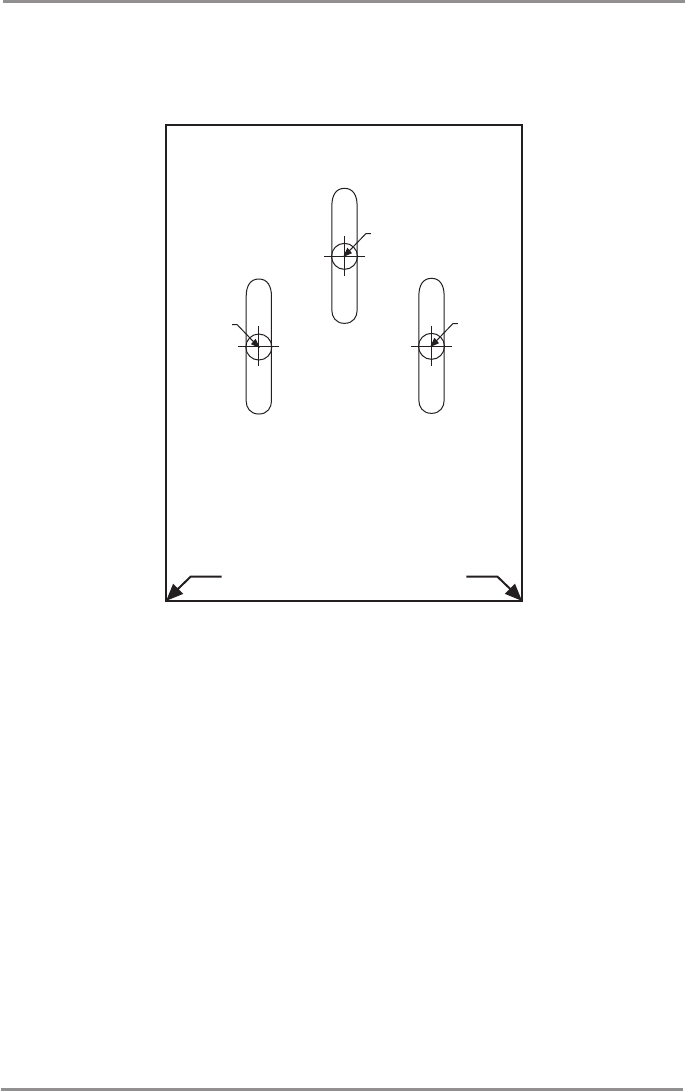
Appendix A Transducer Mounting Template: XHS 9 HDSI 180 T
NOTE: If you are reproducing or printing this template from an electronic file, start with the following print
settings: Scale = None, Paper = 8.5 x 11 inches, Layout = Portrait. Confirm that the template matches the
transducer bracket slots and adjust the print as needed.
Drill
Drill
Drill
Use 5/32”
drill bit.
TOP
PLACE EITHER CORNER
ON DEADRISE ANGLE
Remove and use for
Transducer Installation
Appendix 182
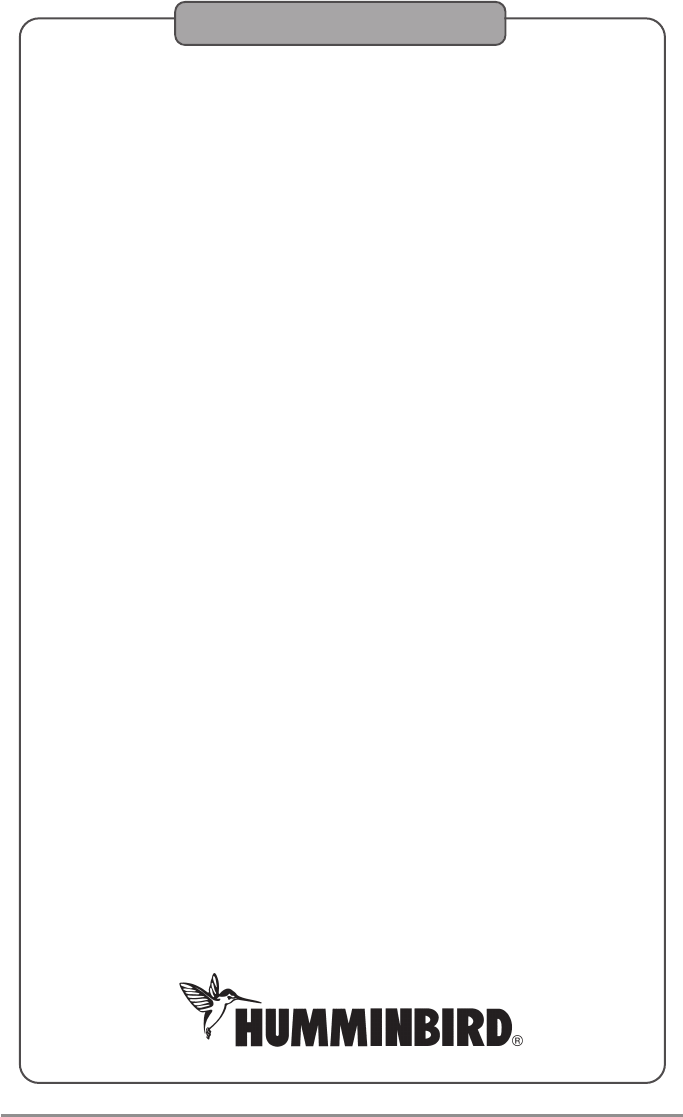
183
Contact Humminbird®
Contact the Humminbird® Customer Resource Center
in any of the following ways:
By Telephone
(Monday - Friday 8:00 a.m. to 4:30 p.m. Central Standard Time):
1-800-633-1468
By e-mail
(typically we respond to your e-mail within three business days):
service@humminbird.com
For direct shipping, our address is:
Humminbird®
Service Department
678 Humminbird Lane
Eufaula, AL 36027 USA